
The ultimate hub for all things RVs
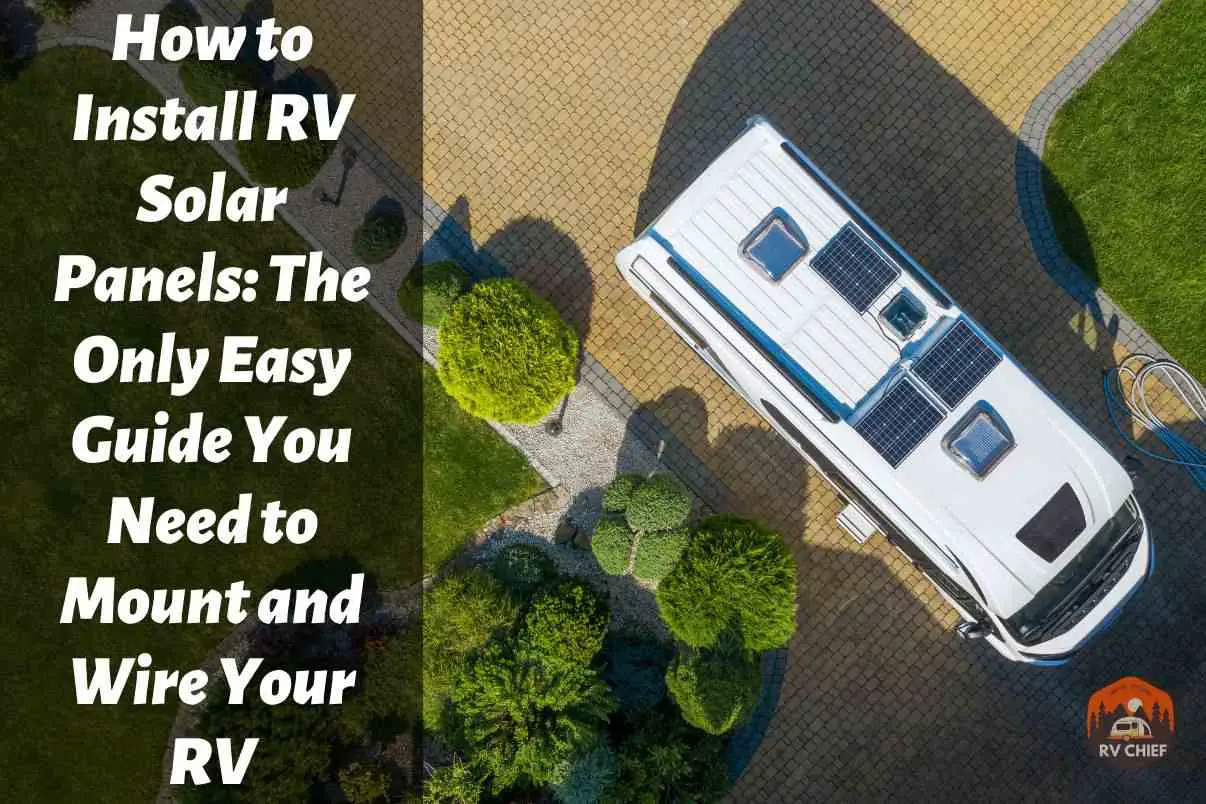

How to Install Solar Panels on an RV: The Only Guide You Need
Installing solar panels on an RV enhances your camping experience. Unlike generators, solar panels are noiseless and barely need maintenance or replacement for several years. Before mounting solar panels on an RV, choose between standard or flexible solar panel placements to get the most out of the sun.
Then, create a position for the solar panels on your RV roof and connect mounting brackets to each panel. After that, identify the spots where you need to drill holes in your RV roof. Drill the hole and screw in your mounting brackets.
Using butyl tape, line the bottom edges of each panel and connect the panels to the roof. Then, apply a generous amount of Dicor sealant, and your solar system is ready.
In this article, I’ll walk you through the step-by-step process of mounting solar panels on your RV, including what you need for RV solar panel installations and the required materials for wiring.
Table of Contents
- 1.0.1 Pro Tip
- 2 What You Need for Installing Solar Panels on RV
- 3.1.1 Pro Tip
- 3.2 Step 2: Connect Mounting Brackets to Each Solar Panel and Set them Aside
- 3.3 Step 3: Identify the Spots Where you Need to Drill Holes in your RV Roof
- 3.4 Step 4: Drill a Pilot Hole in Your RV Roof and Screw Your Mounting Brackets
- 3.5 Step 5: Using Butyl Tape, Line the Bottom Edges of Each Panel
- 3.6 Step 6: Use the Screws from the Mounting Kit to Connect the Panels to the Roof
- 3.7 Step 7: Apply a Good Amount of Dicor Sealant
- 4.1 Portable RV Solar Panels
- 4.2 RV Solar Panel Corner Brackets
- 4.3 VHB Tape
- 5.1 100W RV Solar wiring diagram
- 5.2 200W RV Solar wiring diagram
- 5.3 300W RV Solar wiring diagram
- 5.4 400W RV Solar wiring diagram
- 5.5 Large RV solar wiring diagrams (400W or more)
- 6 Materials Needed for Wiring Your Solar Panel into Your RV
- 7 How to Wire the Solar Panels into Your RV
- 8.1.1 Pro Tip
- 8.2.1 Pro Tip
- 8.3 Wiring your RV Solar Panels in Series-Parallel
- 9 Final Words
- 10.1 How do RV solar panels work?
- 10.2 How many solar panels does it take to power an RV?
- 10.3 Can I connect the solar panel directly to the RV battery?
- 10.4 How many batteries do I need for my RV solar system?
- 10.5 Do you need an inverter for RV solar panels?
Installing Solar Panels on an RV

Before installing solar panels on an RV, you should first know how and where you want to mount your panels. Drilling holes into your RV’s roof is critical, so endeavor to get it right on the first try.
Take note that all RV roofs aren’t the same. Also, the solar panel arrangement that worked for others may not work for you. However, you may not have to worry about hole drilling if you’re using a flexible solar panel .
Still, planning for the best positions to place your panels for durability and efficiency is necessary.
Before purchasing your solar panels, ensure to take detailed measurements of your RV roof. Take note of all AC units, vents, and any other items on your roof that could obstruct your RV solar panel installation. For best results, draw a diagram of your entire roof with the measurements and positioning of the panels.
What You Need for Installing Solar Panels on RV
Once you’ve decided on the perfect positions for your RV solar panel mounting, the next step is to get the right supplies and tools to properly secure the panels to the RV roof.
Here’s a list of some of the tools you need:
- Cordless Drill
- Mounting Z Brackets (required: 1 set for each panel)
- Dicor Self-Leveling Lap Sealant
How to Install Solar Panels on RV in 7 Easy Step -By-Step Guide
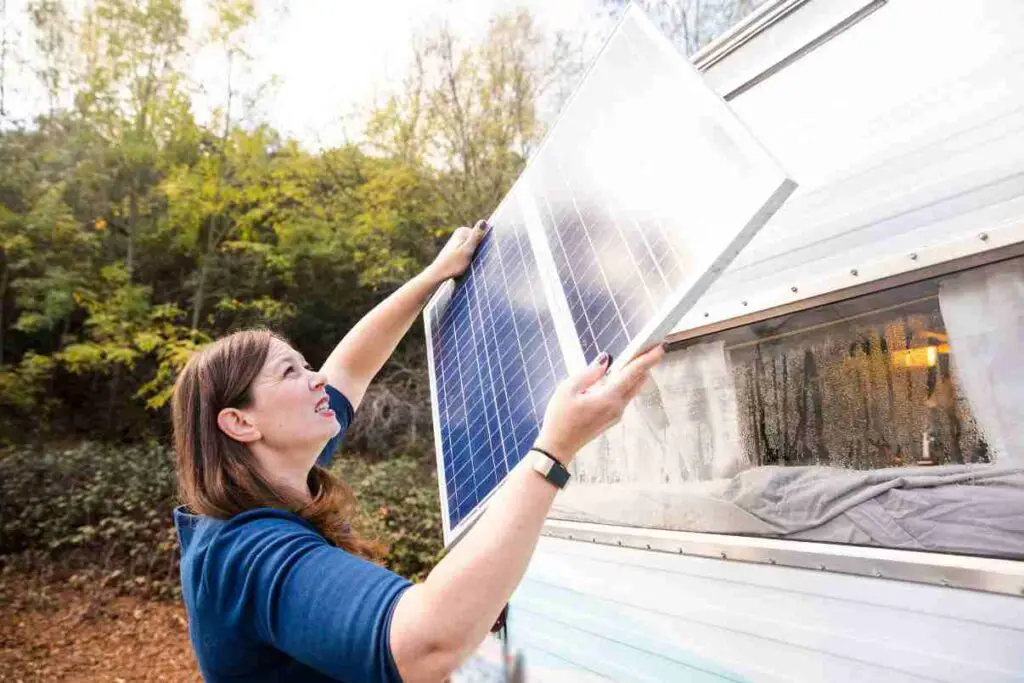
Installing solar panels on an RV will be seamless if you follow these seven easy steps.
Step 1: Create a Position for the Solar Panels on your RV Roof
Before proceeding with your RV solar panel installation, create a better position for the solar panels on your roof. Double-check if the panels properly fit in the position before drilling holes into your roof.
Keep in mind that the process will differ based on the type of solar panel you have. For instance, rigid panels must be attached to the RV roof using screws. Flexible panels are mounted with adhesive, although they can also be mounted with screws.
It’s worth noting that the material used in building the upper layer of your roof will determine the type of adhesive needed. As a result, many RV solar panel kits don’t come with adhesive. Rather, they only come with the mounting hardware.
Ensure the panels are mounted in a position where air conditioning and vents won’t shade them.
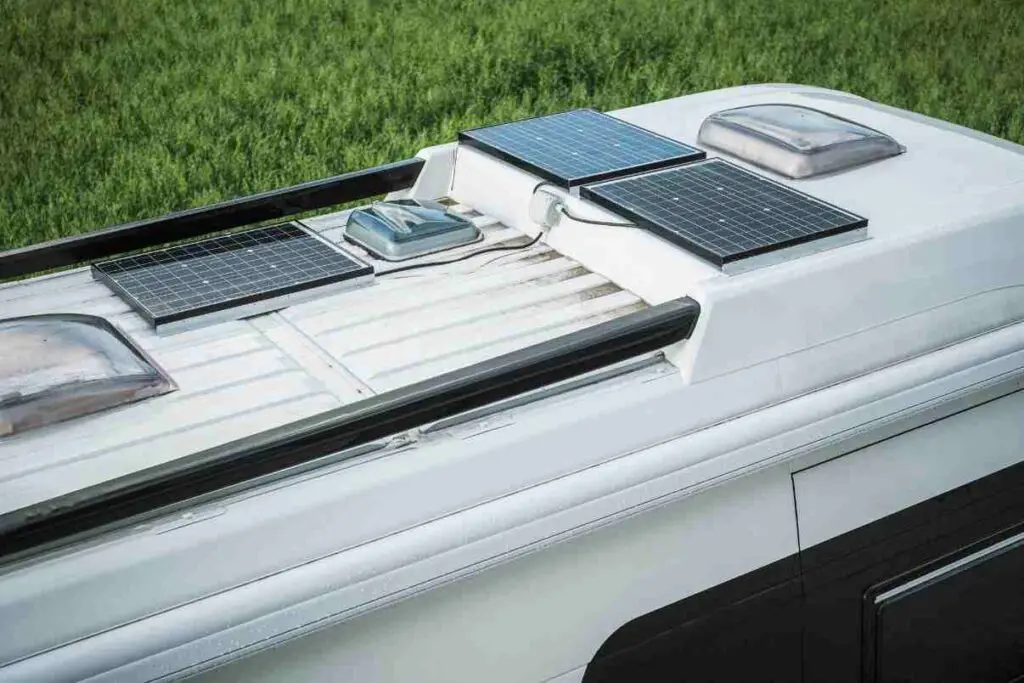
Step 2: Connect Mounting Brackets to Each Solar Panel and Set them Aside
The next step is to attach mounting brackets to each solar panel. As earlier mentioned, the RV solar panel mounting process may differ depending on the panel type.
However, you must install rigid panels with screws by drilling into your roof. They can be fixed tilt-mounted or affixed flat to your RV roof.
Step 3: Identify the Spots Where you Need to Drill Holes in your RV Roof
Identifying the spots where you need to drill holes on your RV roof applies when installing rigid solar panels with a fixed mount. In such a case, you must bolt the brackets tightly based on your panel’s positioning.
Then, apply sealant underneath the brackets to keep the seal airtight and prevent potential roof leakages. However, you don’t have to drill holes if the panels have flexible designs. Such designs can be mounted with adhesive attached directly to the roof surface.
In addition, removable types, like EcoFlow Portable Solar Panels, have a foldable design and portable carry case. They’re easy to set up and require no installation.
Step 4: Drill a Pilot Hole in Your RV Roof and Screw Your Mounting Brackets
Position your solar panels and mark where you need to drill holes. Then, drill small pilot holes into your RV roof where your brackets will be screwed down. Ensure the holes will hit studs in your RV so your panels are secure.
Then, fill the holes with a small quantity of the Dicor sealant to help ensure that everything remains watertight. Although all RVs are different, the studs are usually visible with a 2-3-inch-wide gray line that goes width-wise off the roof.
Step 5: Using Butyl Tape, Line the Bottom Edges of Each Panel
Line the bottom edges of each solar panel with butyl tape and arrange the panels in place. Covering the panels with butyl tape helps add security to your panels and prevents them from flying off.
Step 6: Use the Screws from the Mounting Kit to Connect the Panels to the Roof
Attach the solar panels to your RV roof using the screws from the mounting kit. Ensure that the panels are properly placed in their mapped-out positions.
Step 7: Apply a Good Amount of Dicor Sealant
Apply a generous amount of Dicor sealant around and on top of the mounting brackets to seal everything off. Make sure to apply the adhesive directly to the butt joint in the roof surface and around the mounting brackets to seal them off from sun rays.
Attaching Solar Panels to RV Roof Without Drilling

After deciding the type of solar panel you’d love to use, it’s necessary to consider mounting it. Depending on your chosen type, there are different methods of attaching solar panels to an RV roof without drilling.
Portable RV Solar Panels
Portable RV solar panels are great at harnessing the energy of the sun. They’re great alternatives to traditional installations for RVers willing to undertake a DIY project. These panels require a simple setup and are ready to use.
The two most common portable RV solar panels are foldable and suitcase solar panels. Foldable solar panels have more than two panels and fold up in an accordion style. To set up this solar panel, all you need to do is attach the clamps to the battery terminals, and you’re good to go.
On the other hand, the suitcase solar panels come in a folding set of two 50-watt panels. An adjustable kickstand allows it to stand upright or at the desired angle. To set up this panel, attach the alligator clamps to your RV battery’s negative and positive terminals and connect the panels to the attached solar charge controller.
RV Solar Panel Corner Brackets
One of the most effective methods for mounting solar panels to your RV roof without drilling is using corner brackets. These brackets are made of ABS plastic. They’re usually attached to the four corners of the solar panels and adhered to the RV roof using silicone glue.
Corner brackets are only for aluminum-framed, rigid solar panels. They don’t work with flexible panels. To install these brackets, you’ll need to place them on all spots on the panel, mark holes, and drill them through each marked area.
Then, fasten the brackets to the solar panel using the provided bolts and nuts. Apply silicone adhesive, preferably Sikaflex 252 , to the underside of the brackets and place it in the desired roof’s position.
VHB tape is a lightweight, affordable option for mounting solar panels without drilling. It’s an extremely strong double-sided tape that can be applied quickly and easily to solar panels.
Despite its ease of use, VHB isn’t strong enough to adhere rigid solar panels to an RV roof. Hence, it is strictly used on flexible solar panels only. To apply VHB tape, remove the plastic layer from one side of the tape and stick it to the solar panel’s bottom edges.
Then, remove the plastic layer from the other side of the tape and firmly press the solar panel onto the desired roof location. When applying this tape, ensure that the area is dust-free and isn’t too cold outside.
RV Solar Panel Wiring Diagram
After sizing your RV system and the panels, the bulk of work starts! Below are different RV solar panel wiring diagrams. Each diagram illustrates how to connect the solar panels, battery bank, and charge controller.
100W RV Solar wiring diagram
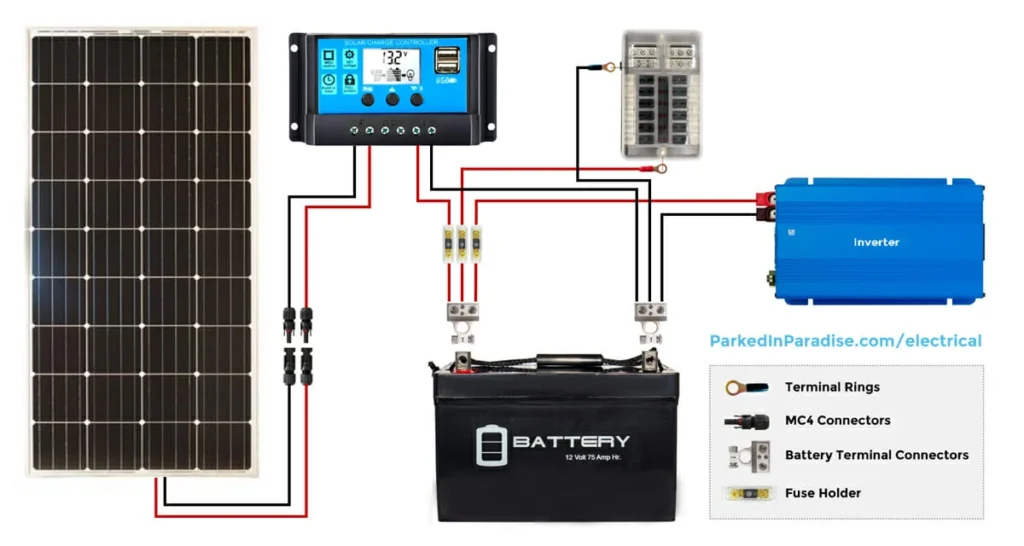
A 100-watt solar system powers small items like a roof vent , LED lights, and a cell phone. It’s more suitable for camper vans but is great at providing supplementary energy on the go.

However, the amount of power a 100-watt solar panel can provide depends on factors like the weather, location, type of charge controller you install, and time of year. A 100-watt solar panel provides about 30-32 amp hours per day.
200W RV Solar wiring diagram

A 200W RV solar panel system is enough to power small 12V appliances, like a sink pump, a cell phone signal booster, and a laptop. It’s less likely to power a portable refrigerator full-time. So, it’s a good setup for supplementary power.

This RV solar panel is relatively small and has an easy setup. Unless you’re considering wild camping in your RV, this panel gives you reliable access to shore power.
Besides, it can run a small, energy-efficient fridge, making it a good option for small campers. However, if your ideal solar system is larger than 2200 watts, build the system with scalability in mind.
300W RV Solar wiring diagram
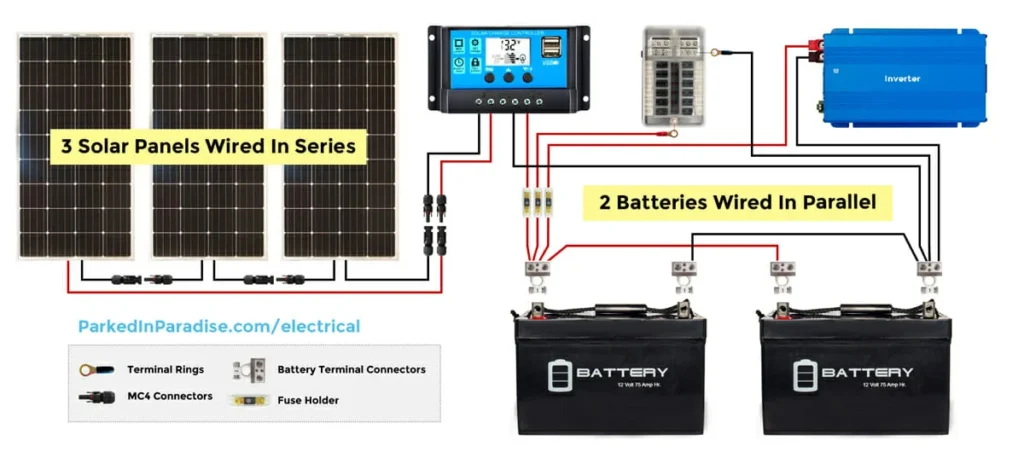
A 300-watt solar system can support the energy demands of a couple or even a small family in a medium-sized motorhome. Careful use and monitoring can take up to a year without needing other energy sources like hookups or driving.

This panel provides approximately 90 to 96 amp hours daily. Since you may be unable to recharge the batteries daily, consider having an alternative (as a contingency) to avoid cycling the batteries more than necessary.
Overall, 300-watt panel systems reserve a day or two, depending on your usage.
400W RV Solar wiring diagram

A 400-watt solar panel system gives you a couple of days in reserve, depending on your usage, without other sources of recharging. It’s enough to run your roof vent during the day and night to stop condensation.
In addition, it can recharge small devices on a USB, like tablets, kindles, and phones.

How much 400 watts of solar panels can power depends on the time of year, the location, the type of charge controller, and the weather. However, they’re capable of providing 120 to 128 amps daily.
Large RV solar wiring diagrams (400W or more)
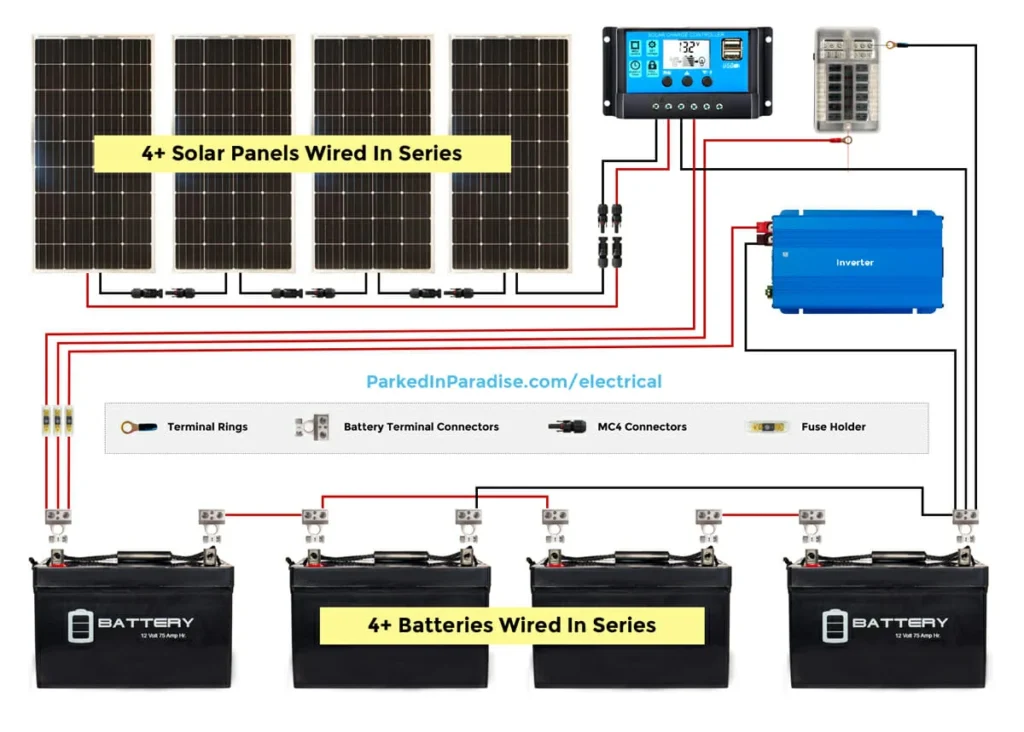
800 watts of solar power is enough for even the largest RVs and campervans. Large RV solar panels provide about 200 to 256 amp hours daily.
They’re enough to run a large fridge, an inverter for a TV, a coffee maker, and charge laptops. If you plan to live in a camper during the winter , the 800W is a full-service luxury.

With large RV solar panel systems, there’s no need for driving or shore power. Although you’ll always need to monitor the battery levels and usage with a solar system this size, you’ll comfortably have enough energy to meet the needs of four people.
Materials Needed for Wiring Your Solar Panel into Your RV
When wiring your solar panel, there are certain materials you must have in place. Some are batteries, mounting brackets, connectors, solar panels, cables, and an inverter.
All the necessary materials must be available, whether you’re wiring your solar panels in parallel or series. While there are numerous inverters, 300W, 600W, 1000W, and 1500W are the most common for solar panels between 100W and over 400W.
The most commonly used alternator chargers are B2B chargers and battery isolators. Wires and fuses are additional parts for all solar systems. In all, before choosing a solar panel system for your RV, make sure to research all its specifications.
How to Wire the Solar Panels into Your RV
After mounting solar panels on your RV roof, the next procedure is to start wiring them. Below are the actual steps for wiring the solar panels into your RV:
- Mount the RV solar panels to the roof using the parallel or series method.
- Attach the charge controller to the RV’s interior near the battery bank.
- Run wires from the solar panels to the charge controller with a circuit breaker or fuse.
- Connect the charge controller to the battery bank
- Then, connect the solar panels.
- Caulk and seal any holes or exposures created during the installation process. If using an inverter, it should be mounted very close to the battery bank.
Parallel Wiring vs. Series vs. Parallel Series
In series wiring connections, the negative cable of one panel goes to the positive of the second one, the negative of the second goes to the positive of the third, and so on. Then, the two unused cables from the first and last panels go into the charge controller.
Wiring in series means the panel’s amperage remains unchanged, but their voltages are combined. The negative and positive cables often go into a combiner box for parallel wiring connections. One thick positive cable and a negative cable go into the charge controller.
Sometimes, the MC4 branch connectors are used instead of a combiner box. Parallel wiring means the panels’ voltage remains, but their amperages are combined. The series-parallel connection is usually used with numerous panels.
It’s a combination of the two other wiring methods, which allows you to adjust the amps and voltage of your solar array to the properties of your charge controller. For instance, you can create two strings of panels with high voltage but wire them in parallel to combine their amperages.
Wiring your RV Solar Panels in Parallel

Wiring RV solar panels in parallel is when the positive and negative (+ and -) wires are grouped. This type of wiring allows each panel to operate on its own.
Solar panels wired in parallel require higher-gauge wiring because the amperage is the wire gauge’s limit.
Don’t wire your solar panels in parallel for units of over 500 watts because you’ll need to buy expensive, thick wires to make the connection efficient.
Wiring your RV Solar Panels in Series

The lowest-performing panel in series wiring connections sets a limit on the output. All other panels will be removed if one panel is in the shade.
Connecting your solar panels in series doubles the voltage going through the wires while leaving the amperage unchanged.
Use an efficient charge controller. Voltage is the reason why charge controllers have a limit. Hence, RV solar panels wired in series require a more expensive charge controller.
Wiring your RV Solar Panels in Series-Parallel
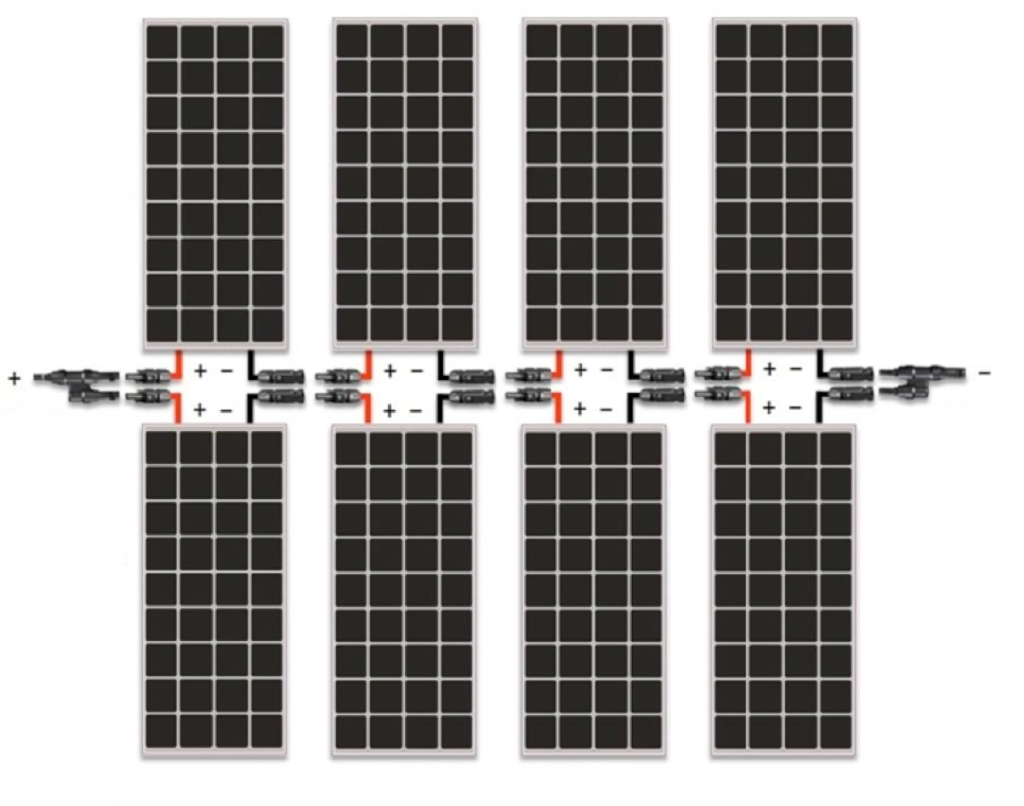
Wiring RV solar panels in series-parallel means that you have multiple series that you’re wiring in parallel. For example, if you have four solar panels, you could have two sets of two panels.
While one series might be wiped out due to a panel in the shade, the other can still perform at maximum capacity.
You double your voltage and amperage rather than quadruple for a four-panel array wired in series parallel. This allows you to limit the gauge of your wires and the size of your charge controller.
Final Words
The biggest determinants of a solar panel RV installation are your budget and power demands. Although you may consider hiring a professional to take care of the installation, it can also be a seamless DIY project. All you need to do is follow the steps in this article and rest assured of a perfect RV solar panel mounting and a better off-road experience.
If you’re using a flexible panel, you can use adhesive to fix the panels. Run the wiring through a conduit to a cable entry plate and connect it to a charge controller. The installation and wiring materials are affordable and easy to access.
Once your solar panel system is installed, maintain and inspect it regularly to ensure optimal performance. Neglecting routine maintenance can lead to reduced efficiency and potential issues.
Although an RV solar installation can cost about $500 to $2,000, the investment is worth it. So, get started with your RV solar panel installation already. Do you have any questions or suggestions on installing solar panels on an RV? Let us know your thoughts in the comment section!
FAQs on How to Install RV Solar Panel
How do rv solar panels work.
RV solar panels convert solar energy into direct current electricity (12V DC), which charges the RV’s batteries and stores the electricity. Passing the 12V DC through an inverter converts it into 120-Volt AC (alternating current), which powers 120-Volt gadgets like a coffee maker. In short, with solar panels, you can power almost anything.
How many solar panels does it take to power an RV?
Five solar panels are enough to power an RV if your total power consumption is 10,000 Wh. However, the number of panels largely depends on your power consumption needs and environmental conditions.
Can I connect the solar panel directly to the RV battery?
Yes, you can, but it’s not advisable. Connecting the solar panel directly to the RV battery can cause explosions and overheating. Instead, connect it to a charge controller. It’ll help guard the battery against overcharging and improve its lifespan.
How many batteries do I need for my RV solar system?
1 to 4 batteries are enough for your RV solar system. Generally, every 100 amp hours of battery storage capacity is enough for a 300-watt solar panel system. So, if you have two 12V or any combination of batteries that sum up to 200 amp hours, your solar panel output shouldn’t be less than 600 watts.
Do you need an inverter for RV solar panels?
Yes, you do. Residential solar panel setups run on DC, so your RV solar system needs an inverter to convert the DC to AC energy. If you’re using solar panels to power your RV, the energy they collect must first go through an inverter before you can use it.
Leave a Comment Cancel reply
Save my name, email, and website in this browser for the next time I comment.
- More Networks


Before you go, check this out!
We have lots more on the site to show you. You've only seen one page. Check out this post which is one of the most popular of all time.
The Complete Beginners Guide to RV Solar (Sizing, Design & Installation)
When we think about the freedom and adventure of RVing, it is easy to forget that most campers will not function for long without being connected to some-sort of external power system. This article will walk you though all of the steps required to size, design and install a solar system in a RV. This article is written for the Newbie RV owner that wants to explore the world off-grid without needing to always be connected to a generator or shore power.
The goal of this article is to help you learn what is needed to build a RV solar system from the ground up and get you to the point of being able to confidently discuss off-grid solar systems with anyone. I have done my best to cover every topic in a simple and easy understand way. After reading this you should be armed with all of the info you need to install your own solar system or know what to ask for when hiring someone else to do the installation.
This is a long post that covers everything from definitions to sizing. You may want to save this page to your browser bookmarks so you can find this reference again as you design and build your system.
Table of Contents
- Solar and Electrical Terms
Solar System Components
Series and parallel connections, sizing rv solar systems.
- Charge Controller Options
System Wire Sizing
Choosing house batteries, battery bank sizing, calculating energy consumption, final thoughts, solar and electrical terms we need to know.
If you found your way to this article you likely know what solar is, but let's run through a few key terms to ensure our terminology is the same.
Solar Array
When one sees a group of solar panels installed on a RV, house, building, etc. the term most often used to describe the installation is Solar Array. A Solar Array is made up of a group of two or more Solar Panels that are electrically connected together .

The term Solar Array is an informal reference to a group of connected panels that make up a system — it is not a scientific term.
Photovoltaic Array
When exploring solar, you will encounter the term “ Photovoltaic Array .” Solar Array is a generic term that refers to the installation of solar panels. Photovoltaic Array is the scientific term used when describing power outputs and efficiencies of panels.
It is possible that you will see people interchanging the terms Solar Array and Photovoltaic Array, but Photovoltaic Array is the proper PRO term used to describe power outputs of interconnected cells inside of a single panel or the combined output/efficiency of a complete solar installation. Solar Array should be used when generically referring to a solar panel installation.
A Photovoltaic Array is defined as a grouping of solar cells that make up a single solar panel or group of panels.
Solar cells are the small square sections you see when looking at a solar panel.

The term photovoltaic (PV) originates from two root words: “photo” (light) and “voltaic” (voltage).
When you see the abbreviation PV, they are usually discussing something related to input or output specifications of one or more panels (e.g voltage or amps).
One must carefully read the docs referencing PV to determine what values are being discussed. Sometimes it is one panel and sometimes it is all panels combined.
Watt (W) is a unit of power , and power is the rate at which energy is produced or consumed. Think of watts as a measure of electrical flow. Does an electrical device need a big flow or a small flow to work?
The easiest way I have found to describe Watts is to think about a garden hose. The amount of water that can flow through a hose is similar to Wattage. A small hose cannot move as much water as a larger one. This is the same concept in electricity. Lower wattage devices will not consume as much power as a higher wattage device.
A 100W light bulb, for example, uses energy at a higher rate than a 60W bulb. The 100W bulb is going to require a bigger flow of electrons to work than a lower output bulb.
Watts are calculated by multiplying Voltage times Amps of a device. In the 60W bulb example, we do not know the amperage, but we do know the operating voltage of 120V. We can determine the amps by dividing the rated wattage by 120V.
Watts (W) ÷ Volts (V) = Amps (A) 60 Watt Bulb ÷ 120 Volts = .5 Amps
In the solar context, Watts is the rate that the solar energy flows power from the panels to the RV Charge Controller.
Watt Hours (Wh) / Kilowatt Hours (KWh)
A common term that surfaces when we research solar is Watt Hours (Wh). This can be confusing at first. Watts and Watt Hours can sound similar, but they are different.
A Watt Hour (Wh) is a measurement of the amount of work performed or generated during a period of an hour. RV appliances and electrical devices perform “work” and that requires energy in the form of electricity that is supplied through batteries from a camper if it is not connected to grid (e.g. shore) power.
Watt Hour Example : All electrical components are rated in Watts (W). When seeing the term Watt (W) without Hours (Wh) next to it, the rating is referring to how much power the device will require to operate for one-hour. A 60W lightbulb, for example, will consume 60 watts of energy every hour, which equates to 60 Wh per hour. When discussing Watt Hours, we are looking at how much energy is needed or has been consumed over time. A 60W bulb would consume 600 Wh's in 10 hours of use.
Watts (W) x Hours (H) = Watt Hours (Wh) 60 Watt Bulb x 10 Hrs of use = 600 Watt Hours
Kilowatt Hours (KWh) is Watt Hours that exceed 1,000. Utility company's use KWh to make the numbers easier to read. 1 KWh = 1,000 Wh. In the bulb example above, let's assume it was operating 24 hours a day for 7 days (168 hours). It would have consumed 10,080 Wh's. TO make the larger numbers more manageable, we divide Wh's by 1,000 to get KWh
Watt Hours ÷ 1000 = KWh 10,080 Watt Hours ÷ 1000 = 10 KWh
Megawatt: It is rare to see the term Megawatt used in a RV, but it is possible if calculating a year or more of use. Mega means million. The math works the same as converting to Killowatt. The only difference is you would divide by 1,000,000 instead of 1,000. In our 60W bulb example, it would have to be operating 24 hours a day for 6,849 days to get to 1 Megawatt!
Amps (A) and Amp Hours (Ah)
Amps is an abbreviation for Amperage. Amperage (Amps) is a rating that states how much power a device will require to operate at peak or in the case of a battery how much power it can deliver when fully charged.
Think of amps like water flowing through a garden hose. The amount of water that can flow through a given size hose is like Amps. For example, a big hose found on a fire truck is going to deliver a larger volume of water than a small garden hose at your house. A weather radio may consume 0.2 Amps whereas a space heater may consume 15 Amps.

Every electrical device will have an Amp rating. Most of the time when device manufacturers reference Amps, they will just put the letter “A” by the number. “A” stands for Amperage/Amps. The picture above is the back of the power transformer for a Ring Alarm system. In the Output section lists 2.5A. What this is saying is the Ring transformer can deliver power up to 2.5 amperage. This does not mean it consumes 2.5A 24×7, but it can deliver up to 2.5A without damaging the power supply or whatever may be connected to it.
Amps and Watts can sound the same, but they are different. In our gardenhose example, Amps would be the volume of water flowing through the hose, whereas, Watts would be the power generated by the water running through the hose (i.e. think pressure washer or hydroelectric dam).
Similar to Watt Hours, Amp Hours are the amount of Amps that are delivered in an hour.
Think about the process of filling a swimming pool with water. It could take days to fill a pool with a garden hose and a few hours to fill with a fire hose. Both methods will fill the pool to its max capacity. Larger hoses deliver more water and reduces the amount of time it will take.
In electricity, a 1 amp continuous output device would equal 1 amp hour. A 2.5 Amp device would equate to 2.5 Amp Hour. In the swimming pool example, a small hose may deliver 10 gallons an hour whereas a large fire hose could deliver 100 gallons an hour.
Let's take our 60W bulb example from above. A standard 60W bulb will consume approximately 0.5A in an hour. To find out how many amps a Bulb will consume in 10 hours we just multiply the amperage by time in hours.
Amps (A) x Hours (H) = Amp Hours (Wh) .5A Bulb x 10 Hrs of use = 300 Amp Hours
Voltage (V)
Voltage is a term we use all of the time, but it can be a bit tricky to grasp the concept of what it means. Voltage is potential energy. It is like the amount of water behind a Dam. High voltages are like being behind a large dam. Low voltages are like being behind a small one. The more water there is behind a dam, the more potential energy the dam can deliver.
The term Potential energy can also be a bit tricky to understand as well. It is a bit easier to think about this as water. If you have ever used a siphon hose to move water from one bucket to another then you have experienced how potential energy works. The higher bucket has a higher potential than the lower one that is empty. A siphon hose creates the conduit that will move the water from the higher potential to the lower potential.
Next, think about what happens when the water levels equalize between the two buckets… The siphon hose stops flowing water — the potential energy between the two buckets has equalized. When the potential energy is the same, water — or in the case of electricity — electrons will not move.

The image above is showing what happens when siphoning water. When the two buckets have the same level of water, the siphon stops working. This is what happens in Electricity with Voltage. Higher voltage electrons want to move toward a lower voltage.
A battery, for example, may have a nominal voltage of 12.6 V. A battery charger must be rated for something above that (e.g. 14.6 Volts) to work. The battery charger has a higher potential voltage so the electrons want to move toward the battery until the battery voltage equalizes with the charger voltage. When the voltages equalize a battery will stop charging. This is similar to what happens when water stops flowing in a siphon.
A brief aside about battery chargers. If a battery charger does not reduce its output when the battery it is charging is full, it could damage the battery. Pushing more voltage into a device rated for lower voltage for extended periods of time may cause permanent damage. Always use a battery charger designed for the battery it is charging . Using a constant voltage lithium charger on a lead acid battery will destroy it.
Converter and Inverter
One of the most common terms that get interchanged by new RV owners is Converter and Inverter. They sound the same, but they are different.
A Converter gets its name because it “converts” standard 120 Volt Alternating Current (VAC) house-style electricity down to 12 Volt Direct Current (VDC) automotive voltages. The RV Industry calls these devices Converter/Chargers.
The difference between a Converter/Charger and a standard battery charger is the amperage output. Converter/Chargers are designed to power the 12V items inside of a coach when plugged in then the surplus power is used to charge the on-board batteries. Most standard auto battery chargers are designed to charge the batteries only. They have a lower output current and generally are not designed to power other DC powered devices like lights and a radio.

A Converter/Charger is a simple device. The electrical plug that powers it connects to a normal house-style 120 VAC socket. The other end has 12 VDC positive and negative terminals that connect to the DC Bus of a camper. The Converter/Charger pictured above is manufactured by Progressive Dynamics and rated for an 80 Amp output. Common stock RV converter/chargers generally range from 35-60A.
Inverters are similar to Converters, but they work in the opposite direction. A converter changes AC voltage to DC. An Inverter changes DC voltage to AC. Inverters are used when a standard household-type electrical device needs to be powered from batteries.
It is common to see RV's ship with an inverter if the coach has a residential refrigerator. A residential refrigerator needs AC power to operate. When traveling, a RV needs AC power to keep the refrigerator running. The AC power is supplied by an Inverter.

High-end RV's with upgraded electrical systems may come with larger inverters, but generally larger inverters are installed after-market by owners who upgrade their electrical systems.
Solar systems are actually fairly straightforward. Basic systems have two main components. The Solar Panels that convert light into electricity and a charge controller that transforms the voltage coming in from the solar panels down to something that can charge the batteries.
Solar Panels
Solar panels used in RV's typically come in one of two configurations — Monocrystalline or Polycrystalline.
Monocrystalline and Polycrystalline panels are both made from silicone. Monocrystalline panels are made from a single block of silicone that is cut to a uniform size and shape that are called wafers.
Monocrystalline panels are the most efficient because they are cut from pure-blemish free silicone stock. Mono panels cost more than Poly panels because the Mono manufacturing process is expensive and time consuming.

Polycrystalline panels are also made from silicone, but their construction comes from multiple silicone sources that are bought together to form the cells. The process is less expensive, but the imperfections in the Poly cell lowers its efficiency.

It is easy to identify the differences between Mono and Poly panels.
- Mono Panels are cut at a 45 degree angle at each corner because they are made from a round-stock of silicone. If manufacturers were to cut a perfect square they would have too much loss in material.

- Poly panels are perfect squares. They are manufactured out of multiple sources of silicone so the manufacturers can utilize every inch of space when forming the panel. The square shape provides more surface area that improves cell efficiency. This helps offset some of the loss due to how the panels are made.
Panel Construction (Rigid vs Flexible)
There are two types of construction methods of Solar panels used in the RV industry – Rigid and Flex. Rigid panels are generally what is thought of when someone thinks about a solar panel. They are the rectangular shaped aluminum framed panels that we see everywhere.

We see rigid solar panels everywhere because they are virtually indestructible. Rigid panels have been manufactured for decades. The manufacturing process is efficient and the panels are tested by power companies and large installations worldwide. Rigid panels are proven technology that will withstand years of highway driving, rain, hail, tree limbs bumping them, etc.
The drawback of installing Rigid panels on the roof of an RV is they are bulky and need to be hard-drilled into the roof. Each panel will require 6 to 8 physical mounting points securing it to the RV roof. Every hole has the potential of creating a leak point. Accordingly, Airstream and rigs with metal roofs have the additional challenge of drilling through metal to mount the panels. If they are ever remove or change the panels, there would be unsightly holes in the roof that would not be easy to conceal.
Flexible Solar Panels
Flex panels are starting to show up more on RV's. The flexible nature of the panels make them easy to mount onto unusual shapes like an Airstream roof.

Another advantage to the Flex Solar Panels is they are adhered to the surface with a peal and stick adhesive. If they ever need to be removed, a heat gun and some elbow grease can pull them up without damaging the roof.
Flex panels are not as durable as rigid panels. It is very common to see nicks and cuts in a Flex panels that was caused by a tree limb or something nicking them.
Cuts will not necessarily prevent a Flexible Solar Panel from functioning, but they will reduce their overall efficiency.
Another issue with Flex panels is how the top surface is constructed. Flex panels have a soft plastic surface that covers the silicone wafers (Rigid panels are made with tempered glass). The soft plastic is susceptible to UV damage and will deteriorate over time. The top-surface clouding will cause the the entire panel to lose efficiency.

Flexible Solar panels have their advantages, but they are more expensive and will not last as long as a Rigid panel. Most quality flex panels come with a 10 year warranty, but the warranty does not cover labor to remove and install the replacement. Flex panel manufacturers may not cover panels damaged by nicks and scrapes either. Given the choice, rigid solar panels will work better for most RVs.
Charge Controllers
The second primary component of a RV Solar installation is the Charge Controller. What they do is normalize the electrical power coming in from the solar panel to something that can safely charge the on-board batteries.
There are two different types of Solar Charge Controllers — PWM and MPPT.
PWM Charge Controllers
PWM stands for Pulse Width Modulation. PWM controllers act like on/off switches. When they are on, the voltage coming from the panel feeds directly into the battery bank directly. The power output from the panel is not altered. When a battery is fully charged, a PWM controller will toggle the solar panels on and off to keep the batteries in absorption.
PWM systems required that the solar panels are precisely matched to the batteries being charged. If you have a 12 VDC normal battery bank, the panels will need to output a voltage slightly over 12 VDC ~ something around 18 VDC. If you remember our definition above about voltage potential, this is where it comes into play in solar. As soon as the panel output falls below 12 VDC, it stops charging the batteries. A PWM controller would switch the panel off so the battery doesn't try to feed the panel.
Installing multiple solar panels in a PWM system has to be carefully thought out. PWM controllers have a max input amp rating that cannot be exceeded and the solar panels need to output voltages over 12 VDC to work, but they cannot exceed 18 VDC or it can damage the batteries and components inside of the RV. Most of the time PWM systems have one or two panels.
MPPT Charge Controllers
MPPT stands for Maximum Power Point Tracking. MPPT controllers are basically DC to DC converters. They take input voltage form panels and step it down to a safe voltage for the system being charged. All MPPT controllers are designed to convert higher voltages coming form solar panels down to 12 VDC. The common input voltages for MPPT charge controllers are 50, 75, 100 and 150.

MPPT charge controllers are the most flexible. They let you find the best panel that fits the roof and then it does the conversion required to charge the batteries. Accordingly, by having higher input voltages solar panels can be connected in series that multiplies the voltage of the panels and does not increase amps. The advantage of this is lighter weight wires can be ran between the solar panels and charge controller.
When discussing multiple solar panel configurations, it generally doesn't take long to get into the discussion on how they will be wired together (e.g. Series or Parallel).
The reason the wiring discussion is important is because how you connect the panels determines what charge controller you will need, what types of panels you can use and the gauge (thickness) of the wires running between the solar panels and charge controller.
Parallel Connections
Parallel connections are the most common wiring in the auto and RV industry. RV Batteries, for example, are almost always wired in parallel. What parallel means is all positives connect to each other and all negatives connect to each other.

When batteries or solar panels are wired in parallel, the voltage stays the same. Two 12 VDC batteries that are connected in parallel output 12 VDC to whatever they are connected to. This is the most common configuration in two battery automobiles and RV's.
What happens in a parallel connection is the output doubles. In the picture above, two 12 V 100 Ah batteries were connected. The result is it is now like having one big 12 V 200 Ah battery. The batteries are joined and double their capacity without changing the output voltage.
The challenge with parallel connections in solar arrays, however, is when two panels are connected in parallel their output amperage doubles. The higher amperage needs to be carried through wiring from the panels to the charge controller. In solar installations it is generally better to keep the amperage as low as possible.
Series Connection
Series wiring of batteries connects the positive terminal from one battery to the negative terminal to another battery. The cross connects would continue in the positive to negative configuration until the last battery. There would be one open positive and one open negative. Those would connect into the system.

The batteries in the photo above are 100 Ah 12 VDC. What happens in a Series connection is the voltage doubles to 24 V, but the amperage output remains the same.
Doubling of voltage is what happens to solar panels that are connected in series as well. Two 32 V / 9 A output solar panels would output 64 V at the charge controller when connected in series, but their amperage would remain the same at 9 A. The advantage of this configuration over parallel is that it would take a smaller gauge wire to carry 9 A in a series connection vs 18 A in a parallel connection.
Series-Parallel connections
In large complex solar installations, it is common to see panels wired in a series-parallel configuration. This configuration has to be thought out carefully. Everything needs to be identical in each section to work properly.
Series-parallel is a configuration where there could be groups of panels in series and then the groups combine together to form a parallel connection.

The diagram above shows 4 groups of solar panels (one per row). Each row is connected in series and the outside connections are in parallel. The panels are 19V 8A.
- The total output of the above series-parallel configuration is 38V 32A.
- If all 8 panels were connected in parallel, the output voltage would be 19V at 64A.
- If all 8 panels were connected in series, the output voltage would be 152V at 8A
Series-parallel allows solar installers to get more wattage on the roof while keeping the input voltage and amperage into something that a charge controller can handle. Series-parallel also allows for installers to use smaller sized wires. The 32A output can be used on 10GA wires that are common in RV's that have preinstalled wires. The 64A output of the parallel connection would double the size of the wiring required.
Series wiring in this example would work fine with the standard 10 Gauge wiring in RVs with pre-wired solar connections. The output voltage, however, is too high. 152V output would push it outside of the specs of most charge controllers that cap at 150V input.
When designing a solar array, it is important to calculate the output voltage and amperage based on series, parallel, and parallel-series configurations. This will help you then pick the appropriately sized charge controller and wiring.
The surface area on an RV ultimately defines the capacity of the system. The easiest way to start is to measure the roof and determine approximately where a solar panel could be installed.

Both images above are Grand Design RV's. The layout of OEM components on the roof such as air conditioners and vents determine where panels can be installed. The top photo is a 2020 Grand Design Momentum 376TH. The second is our 2020 Grand Design Momentum 397TH. They are both big rigs, but the roof layout is different.
Our rig was ordered with factory solar. The panel at the bottom of the picture shows the OEM panel. GDRV installed the panel in a location that is off center, but they did not leave room for a second panel. We added two more factory Jaboni panels in the front. The two panels in the front could not be even due to a LCI Cellular LTE antenna.

The image above is a mockup I created to add two panels to the OEM install. The measurements are not exactly to scale, but it helped get in the ballpark. We added two panels, ran larger wiring from the roof to the charge controller, relocated the wiring into a junction box and left the OEM panel in place. This configuration gives us 900W of solar capacity. To achieve more we would have to move the OEM panel and patch the holes in the roof. The panels are wired in series.
Calculating Solar Panel Output
After roughing in the initial lay-out I was able to calculate the output power needed to size the solar charge controller and wiring. The first step was to look at parallel connections. The panels output 9.3A max output. 3 panels in parallel would output 27.9A and maintain 39.85V.
The next step was to look at panel output when wired in series. The panels output 39.85 V maximum open current voltage. 3 panels in parallel would output 119.55V and maintain 9.3A.
Determining Charge Controller Size
The Grand Design Solar install came standard with a Jaboni 30A MPPT charge controller. The easiest solution would be to use the OEM controller; however, when looking at the Jaboni Charge Controller specs , it will not work with 3 300W Solar Panels.
If we refer back to the above calculations, 3 panels in parallel would output 27.9 A. Although this is within the limits of the input amperage, the max size wiring supported is only 10 AWG. 10 AWG is max rated to 30A for solar installations. This configuration would push 10 AWG wiring to its limits, which increases heat and voltage drop.
Next we look at 3 panels in series, which output 119.55V. The max input voltage for the Jaboni Charge Controller is 45V. The Jaboni Charge controller can only support 1 300W solar panels in series.
The OEM charge controller can only support parallel connections due to the limitation of input voltage. Operating 3 panels in parallel is technically possible, it would push the amps on the wiring to the max supported by the Jaboni charge controller. Another limit of the Jaboni Charge controller is it can only output a max of 30A. 3 panels in series has the potential at charging at more amps with a different charge controller. Therefore, we eliminated the OEM Jaboni charge controller from our system.
Victron Charge Controller Options
Victron makes a wide range of solar charge controllers and are frequently used in RVs. It is important to find a charge controller that will fit the system without buying one that is too large or too small. A large system will not be as efficient as a smaller one. A small system can overload and shut down if more power than it can handle is pushed in or out of it.

Victron lists all of their charge controller's on there website. At first glance it may be confusing, but it isn't too hard to narrow down the product needed for our install.
The first item I looked at was what devices support Bluetooth. I wanted a controller that can be programmed and monitored directly from the Victron smartphone app. The devices that have integrated bluetooth are called SmartSolar and have a picture of a smartphone next to them (top row of image above plus the leftmost controller on the second row).
Now that we have narrowed to the Victron SmartSolar devices, we need to determine what controller we need. The output voltages are available in different configurations — 12V/24V/48V. Output voltage is the voltage that the system uses to charge the onboard battery bank. This is not the input voltage from the panels. I chose 12V output.
I like keeping everything at 12V in an RV because that is the standard voltage used in vehicles. Higher voltages are more efficient, but they require step-down DC to DC converters to work with inside RV systems and it increases the risk that an RV tech or someone not familiar with high-voltage systems could accidentally cross wires that could cause significant damage to components.
After determining the output of 12V in our case, the next step is deciding what controller we need based on the specs of the panels. Victron conveniently lists the input and output capability of their controllers in the name. The MPPT 150|70 can handle input voltages up to 150V and will charge at 70A. A MPPT 250|100 can support up to 250V input voltages and charge batteries up to 100A.
To pick the controller we need to refer back to our solar panel specs. The higher voltage input in general is more efficient because we can run smaller gauge cables from the roof. Looking at our 3 panel series connection, we would output a max of 119.55V, which takes us out of the 100V and below input controllers. We can use either the 150V input or the 250V input controllers.
Now we need to look at our charging potential to see what size controller we need. We need a bit of math to get us in the ballpark. In our 3-panel configuration we will be outputting 119.55V at 9.3A. The controller will step down the voltage to 12VDC. When stepping down voltages, the amperage will increase. We need to see how many amps we will be outputting to confirm the approximate controller size we need.
To calculate charging amperage, we need to reference the panel output wattage. Our 3 panel configuration is 900W (300W x 3). 900W output divided by the end-voltage of 12V works out to the maximum amperage output potential of the system (900W ÷ 12V = 75A).
Our 900W system will need a charge controller that can output somewhere around 75A. Next, let's look at the specs of the Victron charge controller specs that are in the 75A range to pick the best one for our system.
Victron controllers are built to compensate for panel and cable loss. When looking at the reference table, the SmartController 150|75 would work for our system. Our 900W panels are below the 1000W rated input specs. Our output voltage of 119.55V is below the 150A input voltage. And our input amperage of 9.3A from the panels is below 50A max limit.
In our 3 panel configuration the Victron 12VDC SmartSolar 150|75 will match our system perfectly. However, we may add another 300W panel to the system. What would happen if we did?
Victron Series Parallel Charge Controller Sizing
Based on our 397TH roof configuration, we could add one more Jaboni panel if we relocate the OEM panel. Adding another panel is somewhat easy, but the math changes if we do. We need to run though the numbers to ensure we have expansion capabilities.
4 300W panels in series would output 1200W at 159.4V. This output voltage would force us into the significantly more expensive 250V charge controller. However, if we configure the panels in series-parallel we can easily keep the output voltage below 150V.
Connecting 2 sets of panels in series and then combining those two panels in parallel changes the math.

To calculate the Series-parallel configuration we start by calculating the series legs. In the image above, each row consists of 2 300W Jaboni panels that output 39.85V at 9.3A each. The 2 pair series panels (row in pic above) works out to 79.7V (39.85 x 2) at 9.3A. The two series pairs are then combined into parallel, which works out to 79.7V at 18.6A.
Series connections add voltages together and leave amps the same. Parallel connections leave the voltage the same and add the amperage. When combining two series connections into a parallel leg the voltage will remain the same as the series pair and the amperage will double.
By changing to a series-parallel configuration, we are able to keep the voltage below 100V. This opens up the option to look at the 100V and up controllers; however, when referencing the 100V Victron Charge Controller specs , they only support panel configurations up to 700W.
Although our voltage output is lower than 100V, the series-parallel configuration will still require a 150V|X system that can handle the output load of the 1200W panels.
The SmartSolar table above shows the Victron Charge Controller specs that may fit. By adding the 4th panel we push outside of the 150|75 controller because our system will output more than 1000W. The 150|85 is now the best fit. It will support a panel configuration up to 1200W and charge at 85A. It would also possible to jump up to the 150|100, but that would additional cost that isn't necessary for the 1200W panel configuration.

I chose the 150|85A controller for our installation. Although we have 900W initially that will work with the 150|75, I will be adding another panel to our system. By stepping up to the next charge controller size I can use the same controller to work with our 900W system and support the expansion to 1200W.
Solar to Charge Controller Wire Sizing
Now that we have landed on the number of panels and the charge controller, we need to calculate the size of wires we need. We will have two connections to cable — the feed from the Solar panels to the Charge Controller and the feed from the Charge Controller to the Batteries.
The system I have been documenting will start with 900W panels, but the plan is to expand it to 1200W in the future. When sizing, we need to look at both configurations and size to the largest wiring requirements.
We need to compare both 900W and 1200W system configurations because it is possible that a smaller system could put a heavier amp load on the wiring. For example, one could have a smaller system in parallel that multiples the amperage on the cables and then move to series in a larger system. In this situation the smaller parallel configuration would put a heavier amperage load on the wires.
We can use tables and reference data to determine wire size, but fortunately there are a number of online calculators that make the process easier. One of the calculators I like to use is hosted on the Renogy website . It is important to keep in mind that not all sizing calculators are designed to compensate for solar. Renogy sells quality solar components. Their calculator is safe to use for sizing solar wiring.

When reaching the Renogy calculator, select Solar Cable Gauge Calculator. Next we need to enter the specifications for the proposed configurations. We can start with the wire size from the panels to the charge controller. I will use the numbers generated for the 900W and the 1200W examples.
900W Configuration (3 300W Series)

For the 900W system, we need to round up to the next full number. I rounded the 119.55V output of the 3 series connected panels to 120V and rounded the 9.3A output to 10A. I entered 40 feet to ensure that I calculate the maximum length possible. Quality cables that are designed for solar have low loss. I used TemCo cables so I entered 2%. After entering the number click calculate button.
The wire gauge size needed for a 900W system would be 14 AWG minimum.
Next, we need to calculate the specs of the 1200W Series-Parallel panels.

In the 1200W Series-Parallel wire calculator, I rounded up the output voltage from 79.7V to 80V and the amperage from 18.6A to 19. I left the distance and the loss the same.
The wire gauge size needed for a 1200W system would be 10 AWG minimum.
Based on our calculations, the 1200W Series-Parallel system will require the largest 10 AWG cables. We need to use the 1200W configuration for sizing the wires.

I like bumping up to the next size cable. Larger cables will improve efficiency and provide for expansion down the road if needed. In our 1200W configuration, the 10 AWG wiring will support a max of 30A. If we jump to 8 AWG, we can safely carry 55A. The one size up adds significant headroom and only marginally changing price and weight.
I chose to run 8 AWG wiring from the roof to the charge controller.
Charge Controller to Battery Bank Wire Sizing
The next step of the process is determining the size of wires needed to charge the battery bank. The Renogy Wire Size Calculator is technically designed for solar panel to Charge Controller, but we can use the calculator to get into the ballpark of what we need to connect to our batteries as well.

Using the Renogy solar calculator for the battery interconnect cable is the easiest since we are on this page already. All that is needed is to change the Solar Array Voltage and Operating Current to the output specs of the Charge Controller. In our case, we are using the Victron 150|85 that has an operating voltage of 12VDC and a max charging amperage of 85A. The distance from the charge controller to the batteries should be as short as possible. I used 6 feet in this calculation, which is about double the actual length of approximately 3 feet.
The Renogy calculator indicates that we need to use a 2 AWG size wire to connect to the battery bank. This will support the max charge amperage and voltage. However, before locking in 2 AWG, we need to reference the Victron Charge Controller documentation . We need to verify that the Charge Controller has terminals large enough to fit 2 AWG wiring.

Based on the Renogy calculator and the Victron Charge Controller documentation, 2 AWG wire size will fit the terminals and carry the 85A max charging load.
Charge Controller Distance to the Battery Bank is Important!
The Charge Controller should be mounted as close as possible to the battery bank. To illustrate why this is important, I changed the battery calculation slightly. I increased the distance from the controller to the battery bank from 6 feet to 10 feet.

Adding 4 more feet to the distance the minimum wire size moved form 2 AWG that will fit the charge controller to 0 AWG that will not fit the output terminals of the charge controller. Mount the Charge Controller as close as possible to the Batteries.
The heart of a RV solar system isn't the solar panels it is the battery bank. The solar panels do not actually operate anything. Their sole purpose is to charge the batteries that store the power required to operate the equipment in the RV.
Battery Bank Voltage
When selecting batteries, the first decision to make is the voltage configuration that will be used. Higher voltage battery banks such as 24V and 48V configurations improve overall efficiency of a solar system, but changing battery voltage from 12VDC adds risk. Most RV's and vehicles in general are built around 12VDC.
Standard 12V configuration enables us to jump start from one vehicle to another without damaging the electrical system. All DC powered components installed in an RV including systems such as the furnace, slide controllers, generator starter, lights, radio, water heater, etc. are designed to solely work off of a 12V system.
When deciding to change from 12VDC to something else, the battery bank must be isolated from all other RV components. A device called a DC to DC converter must be installed between the battery bank and the RV components. DC to DC converters will step down the battery operating voltage to 12V that is safe to use internally.
DC to DC converters function similarly to solar charge controllers. They are reliable, but they do add another point of complexity and failure point in the system.
The further we move from standard, we move further away from what RV techs, mechanics and most RV owners understand. Solar connected systems are complex and have very expensive components. A simple mistake like trying to charge a 24V battery bank with a standard 12V charger can cause permanent damage to parts, blow fuses, and could start a fire!
In a home or off-grid situation, higher voltages are preferred, but in an RV I highly recommend keeping everything 12VDC. Keeping the electrical system as close to standard as possible is safer.
- We may need to leave our rigs at dealers for maintenance,
- We may sell our rigs to someone that doesn't understand the system,
- We may have a breakdown and need to jump start the generator from the tow vehicle,
- We could brake down on the road and a tow truck driver is not familiar with the system.
Battery connections
Similar to solar panels, batteries can be configured in parallel, series and a combination series-parallel. For this discussion I will generally target parallel configurations since we like sticking with 12V in a RV.

It is important to note that there are some RVs that have installed 6V Golf Cart Batteries in their rigs. 6V batteries need to be wired in a Series-Parallel configuration so they output 12V into the RV. Series-parallel is similar to the discussion above regarding solar panels. Two 6V batteries are connected in Series. The output of those two batteries are connected to the the other two-group of batteries in parallel.
The 6V configuration is not as common now that there are more powerful 12V options, but it is possible that you may encounter a 6V parallel-series connected system if you are upgrading an older rig. It is always a good idea to take pictures of existing wiring before changing anything and then test voltages with a multimeter. It can cause significant damage to systems if 6V and 12V systems are inadvertently connected to each other.
Battery Chemistry
There are 3 types of chemistries used in most RV Batteries – Lead Acid/Wet Cell, AGM/Gel Cell and Lithium-Ion. Outside of those chemistries, there are a myriad of marketing differences from one battery manufacturer to another. We may hear about cold craning amps, deep cycle, marine, maintenance free, etc. Regardless of what the batteries are called, they all end up being one of the 3 chemistries.
Lead Acid / Wet Cell
The Lead Acid Battery is by far the most common battery found installed in RVs. The technology has been around for over 100 years. Lead Acid batteries are also routinely called Wet Cell batteries. The reason they are called wet cell is because water needs to be added to the batteries regularly.
Lead Acid batteries require a lot of maintenance from owners. When Lead Acid batteries are charged the internal cells generate heat. The hot plates inside of the battery heats the surrounding water that is intended to keep the cells cool. The water will heat up above its boiling point and create steam that evacuates outside of the battery. When the battery cools, the escaped steam is lost and the water level decreases. This process happens during every charge cycle. The lower water level exposes the internal lead acid plates to air, which exposes them to high-heat during charging. Heat will destroy the charging plates reducing their overall power output. This is why wet cell lead acid batteries must be regularly serviced with water. One charge cycle without water covering the internal plates will cause permanent damage to the battery.
Another disadvantage of lead acid batteries is they are not efficient at storing electrical loads over time. A fully charged battery that is disconnected form everything will lose 5% of its capacity every week. A battery sitting 1-2 months without a trickle charger will be completely dead.
Fully discharged lead acid batteries will destroy them. A fully charged battery pushes the Acid electrolyte that holds the charge into the surrounding water. As the battery discharges, the acid attaches to the lead plates. When removing the Acid from the water the freeze point increases. Frozen water expands and will destroy the lead acid plates and can crack the housing. This is the main reason why car batteries die in winter.
Most of us have been taught to trick charge our batteries when in storage, which is great advice. The problem of trickle charging lead acid batteries; however, is the plates always stay warm. The warm plates evaporate the water in the cells. Batteries being trickle charged still need to be inspected regularly to ensure water level in the cells is sufficient. If water goes unchecked, the cells will be exposed to air and overheat during trickle charging. This is why we find lead acid batteries that will not hold a charge after winter storage even though they were stored in a warm location and trickle charged.
Sealed Lead Acid/Maintenance Free Batteries
Sealed Lead Acid Maintenance free batteries are very common. Battery manufacturers love marketing sealed lead acid batteries as being Maintenance Free. Unfortunately Maintenance free batteries and lead acid batteries are one in the same. They are made up of the exact same chemistry.
The only difference between a sealed lead acid battery vs a standard lead acid battery is accessing the cells. Standard serviceable lead acid batteries have caps that can be removed to enable inspection and water servicing. Sealed battery caps are designed to capture and cool the steam released from the water when the batteries are charged. When the hot steam cools it creates condensation that is directed back into the cell.
Although sealed lead acid batteries will last longer without maintenance, the process of converting water to steam and back does not capture 100% of the water. Over time the water level will decrease and expose the lead plates to air. Maintenance Free batteries that are never serviced will suffer the same fait as standard lead acid batteries that are not serviced properly.
Interestingly, standard lead acid batteries could outlast maintenance free batteries if they are properly maintained.
It is possible to add water to some maintenance free batteries, but this process generally requires removing labels and prying off the covers. When servicing them, however, the water recapture system can be damaged turning them into standard lead acid batteries that need to be regularly serviced.
AGM/Gel Cell Batteries
AGM/Gel Cell batteries and lead acid batteries function basically the same way. The difference is the material that holds the charge (e.g. electrolyte). Lead acid Batteries use water. AGM (Absorbent Glass Mat) batteries use a Fiberglass material that is situated between the lead plates. Gel Cell batteries use a gelatin material that holds the electrolyte. The electrolyte is exchanged between AGM and Gel cell batteries in exactly the same way that Lead Acid and Water works. The main difference is stability. AGM and Gel batteries do not suffer from evaporation like lead acid batteries and are truly maintenance free. They cannot be serviced.
Gel cell batteries are not commonly used in RVs or solar. They do not work well when high charge or discharge rates. Starting generators, moving slides, etc. can overdrive a gel battery and cause it to internally short circuit. Accordingly, fast charging form large solar systems will also damage a gel cell battery. The main reason we see gel cell batteries is they work very well in slow discharge conditions and they can operate in environments that have high heat better than AGM or Lead Acid.
AGM batteries are commonly found in RVs. AGM batteries are sealed and can be mounted in any configuration — sideways or upside down. AGM does not off-gas as much as Lead Acid batteries, but they still create toxic fumes when charging. They cannot be installed inside of a living space and must be vented externally.
AGM batteries will not last as long as a properly maintained Lead Acid Battery and they are more expensive; however, the maintenance free design of an AGM battery and the ability to mount them in any configuration make AGM the most common aftermarket battery used in RVs.
Lithium Ion (LI) Batteries
The new kid on the block is the Lithium Ion battery, which is often abbreviated to LI. Lithium batteries hit the market initially in laptop computers, smartphones, and personal devices. The consumer electronics market drove the initial LI use case because the batteries can be built in virtually any shape or size. LI technology was pushed into high-demand applications by Tesla the electric car manufacturer. Tesla vehicles use a powerful LI battery configuration that carries their vehicles 300 miles or more on a single charge.
Automobile and consumer electronic manufacturers have invested billions of dollars into research and production of stable and safe Lithium Ion battery technology, which has enabled aftermarket battery manufacturers to create drop-in sized batteries that have the exact same shape and voltage output of a normal Lead Acid, AGM or Gel Cell battery.

The drop-in form factor of Lithium batteries has rapidly moved LI into the mainstream market making LI the most common battery chemistry used in solar and high-power applications.
The main advantage of Lithium technology is they can deliver to their full rated power. A 100AH LI battery can deliver a full 100AH at a stable voltage from fully charged to fully discharged. Lead Acid, AGM and Gel Cel batteries all suffer from the same technology limitations. A 100AH traditional battery chemistry, for example, can only safely deliver 50% of its rated capacity (e.g. 50AH). Discharging a traditional battery beyond 50% will decrease its output. Several deep discharges of a traditional battery will destroy them. LI batteries can be fully discharged and recharged thousands of times without damaging the battery. Most quality LI battery manufacturers cover their batteries for 10 years or more. Lion Energy batteries come with a lifetime warranty. They are guaranteed to deliver no less than 80% of their initial rated capacity for 3,500 full charge/discharge cycles.
LI battery chemistry holds voltage consistent as they discharge even when under a significant load. A traditional battery will have a voltage drop when delivering full power and the voltage will drop over time as the battery discharges. Voltage fluctuations of traditional batteries can damage equipment, which is another reason why it is not safe to discharge traditional batteries beyond 50% of their capacity.
LI batteries are also completely sealed and maintenance free. Like AGM batteries, they can be mounted in any configuration — on their sides or even upside down. Where LI batteries further diverge from traditional battery chemistry is they do not off-gas. They can be safely installed inside the cabin of an RV. Mounting inside is critically important for small RVs like an Airstream that does not have large external storage compartments. Many Airstream owners install LI batteries in the storage compartment under the bed. LI chemistry is the only battery option that can be safely used inside a living space.
The final key differentiator between traditional batteries and Lithium ion is the weight. A type 27 lead acid battery will weigh somewhere between 54 to 70 lb. A Lion Energy UT1300 Lithium battery weights 23 lb!
The primary disadvantage of LI batteries is the upfront cost. LI batteries can be 5 to 10 times more expensive than traditional battery technology. It is not uncommon to pay more for LI batteries than all other components of a solar system. The advantages of weight, discharge capacity, safety and stability make them a very good choice for RVers.
I recommend looking close at LI batteries for any solar system build. If you are on a budget, starting off with one or two batteries and expand the battery bank over time might be a better choice than building around traditional battery technology. Adding capacity later is relatively easy if the system is installed in an area that has room to add more batteries.
LI batteries have a better return on investment over time than traditional batteries because traditional batteries need to be replaced every 2-3 years. It also takes 2 traditional batteries to deliver the same output capacity of 1 LI battery.
As I discussed above, the number of solar panels are defined by the size of the roof. RVs do not have an unlimited roof space. There is a limit to the maximum amount of power than can be generated per day. Battery banks are similar. Batteries take up space in the RV and they are expensive. The more power on board, the longer a RV can be powered by the rig, but again there is still a charging limit. We can't fill our coaches with batteries and not have sufficient solar to charge them. We need to size a battery bank with our solar array.
The challenge with battery bank sizing is that if the batteries will only be charged by solar panels, the time to charge plus the consumption rate need to be look at. A small 100W panel charging a 12V battery on paper will charge at 1200Wh in full sun. One Lion UT1300 battery holds 1250 Wh's (105Ah x 12V). In a perfect world it would take a bit over an hour for a 100W panel to charge a UT1300.
Of course, we do not live in a perfect world. We cannot charge batteries at the full panel rate. There are losses in the system from the wiring used to the energy consumed by the charge controller to covert panel voltage to 12VDC. In my 1200W system, I landed on an 85A Victron Charge controller. The max rate I can charge at is 1020W (85A x 12V) per hour.
Another consideration we need to take into account is the hours of sun available. The standard usable solar calculation in the US is 5 hours per day. There will be days where we receive more than 5 hours of sun and there will be overcast and rainy days where there will be no charging whatsoever. We need something to calculate from, so 5 hours is a good baseline to use as an estimate. In my 1200W system, I will generate approximately 5,100Wh's per day (1020W x 5h).
Now that we know the approximate amount of power we can generate per day, we can look at optimal battery bank sizing. A Lion UT1300 holds 105Ah of power, which equates to 1,260Wh (105Ah x 12V). I can effectively charge 4 UT1300's from dead in 5 hours (5100Wh charging ÷ 1260Wh/UT1300).
It isn't a good idea to cycle batteries fully dead and up frequently. The larger we make our battery bank, the less likely we will need to fully discharge the batteries. For planning purposes, we should try to get to 2x more battery bank storage than what a solar array can deliver to keep the battery discharge rate down to approximately 50% of capacity.
Battery life is extended if do not discharge fully regularly. A full discharge would equate to 4 UT1300's in our 1200W solar array (e.g. 5,100Wh used and recharged). If we size the bank somewhere between 6 and 8 LION UT 1300's we will increase the lifespan of the batteries by not fully discharging them and have more reserve power on hand to cover cloudy days.
One needs to balance the size of the battery bank with the amount of energy that will be consumed while taking into account the length of time it will take to charge the batteries.
It may be easier to take the batteries out of the equation for a minute to bring the point home. A 1200W solar array can deliver 5,100Wh of power per day on average. 5,100Wh is our daily consumption limit.
If one consumes more power than a solar array can deliver in a day, then the there will not be sufficient power to charge the battery bank. Every watt consumed form a battery bank over what the panels can push back into energy storage will slowly deplete the battery bank to the point where they will eventually be fully discharged and disconnect.
In a perfect world, one would just add solar panels and batteries to cover everything, but as we have been discussing RVs have limited space. It isn't possible to make our roofs bigger. What we need to do is to limit our energy usage based on the amount of charging power the panels can provide.
RV solar sizing is a different approach than what would be done for a home install where we build a system to fit the consumption. We do not have the space in a RV to satisfy max consumption, so we have to fit our consumption into what our system can deliver.
Getting back to 5,100Wh's of max daily consumption, we need to estimate what it will take to get there. It can get a bit tricky to do the calculations since some components operate on 12 VDC and some use an inverter to convert to 12 VAC that has an overhead loss. We don't need to worry too much about all of that. We just need to get into a rough estimate of what we can consume per day and make sure we are looking at the same numbers.
We can back into the numbers by looking at amps per hour or by watts per hour. I find it easier to convert to watts per hour first so we are looking at solar panel output through to the batteries using the same numbers.
The quick way to convert into Watt Hours (Wh) is to reference amp rating of the appliance on its label and multiply by the operating voltage. For example, a computer is rated for .2A at 120 works out to 24 Watts per Hour (.2A x 120V = 24). That same computer would consume 576 Wh per day (24Wh x 24 Hours).
Some always on appliances like a refrigerator are not technically running 24 hours per day. The inside temp stabilizes and power consumption is reduced. For calculations, let's assume a fridge runs for 12 of the 24 hours consuming 480 watts per hour. That works out to 5,760 Wh's consumed by the refrigerator per day!
A Refrigerator operating for 12 hours per day consuming 480 Watts per Hour will exceed our solar power generating capacity in a single day! For those of you who are planning on operating off-grid, a RV fridge running on propane is a more efficient use of power.
We all have dreams of living off-grid with no external power running our Air Conditioners all day, but the reality is that it isn't possible in a RV. We need to strike a balance of what we absolutely need to power off of electricity and use alternative power sources such as propane whenever possible. It is also important to unplug any component that isn't being used. Every plugged in electrical device will consume small amounts of power even when turned off.
On the surface solar looks to be complicated, but the reality is there are only 4 main parts that make up the system — solar panels, wires, charge controller and battery bank.
For those powering AC appliances like an Air Conditioner or Microwave, there is one more component called an inverter that turns battery power to standard household appliance power. I will write more about inverters in a future post.
We can spend a lot of time doing an energy audit trying to calculate the exact power needed, but the reality is the max solar power is limited to the space on the roof. Solar panels are cheap. Find a panel that will fit the roof the best and get as many of them as you can fit on the roof. Then take the specs of the panel and move forward though the system calculating everything needed from the wire size to the battery bank.
Jim Kerr is a entrepreneur that has founded several businesses including Orbitz , Team Convergence , Assure Flight , and Passion Highway . He is an airplane pilot, PADI SCUBA Dive Master and adventure traveler. Along with his wife Lisa, they travel North America in their 2020 Grand Design Momentum 397TH Toy Hauler with their cat Dexter. To find out more about Jim, visit JamesNKerr.com
Recent Posts
EAA AirVenture Oshkosh 2021
The EAA AirVenture Oshkosh annual event brings aviators and aerospace enthusiasts together from around the world. Over 608 thousand people attended AirVenture 2021 generating $170 million economic...
Easy Step by Step Guide to Winterize a RV
It is the time of the year that many of us need to winterize our beloved RVs and put them in storage. You may have your RV Tech on speed-dial, but before you give them a call check out this article...
- skip to Main Content
Go RVing uses cookies on gorving.com in accordance with our privacy policy . By using this site, you consent to the use of cookies. We use cookies for the following purposes: To enable certain functions of the service, to provide analytics, to store your preferences, and to enable advertisements delivery, including behavioral advertising.

- Your Basecamp
- For the Family
- Furry Friends
- All the Amenities
- Working from the Road
- Versatile Vacations
- A Fit for Any Budget
- See All Benefits BENEFITS
- Active Lifestyle
- On the Water
- Winter Sports
- The Great Outdoors
- A Weekend Getaway
- Explore a New City
- Go Glamping
- Foodie Adventures
- Seasonal Camping
- See All Activities ACTIVITIES
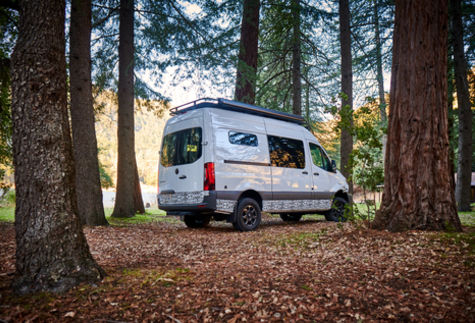
- Travel Trailers
- Expandable Trailers
- 5th Wheel Trailers
- Pop-Up Campers
- Teardrop Trailers
- Sport Utility RVs
- Truck Campers
- Learn About Towables TOW IT
- Class A Motorhomes
- Class B Motorhomes
- Class C Motorhomes
- Learn About Motorized RVs DRIVE IT
OTHER RV MODELS
- Park Model RVs
- Horse Trailers
- Ice Fish Houses
EXPLORE RVs
- Learn More EXPLORE RVs
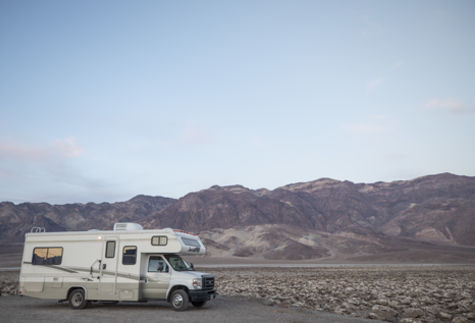
- RV How-to's
Expert Advice
- Recipes for the Road
- On the Road with RVers
- Trip Planning
- Budget Tips
- Meet Our Contributors
- Become a Contributor
- See All EXPLORE

Ryan's Story
Highlining in Moab
Ryan Robinson takes you for a ride in the passenger seat of his RV, off the grid, deep among the dramatic rock formations of the Utah Desert. Robinson and friends chill by the fire, tell stories, and of course, rig a one of a kind highline over the Looking Glass Arch in Moab, UT.
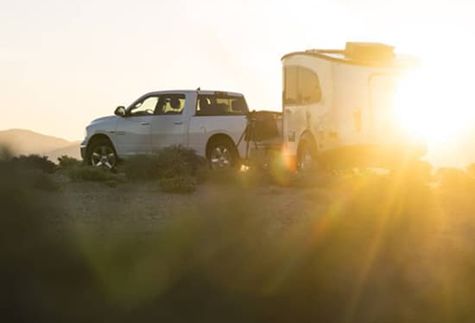
START YOUR JOURNEY
- Buying an RV
- Renting an RV
- Find a Campground
- First-Timers Tool Kit
- RV Shows & Events
- Explore Models & Manufacturers
- Find Services & Parts
- Sign up for RV Information
- Visit our Booth
- Get Started START YOUR JOURNEY
YOUR NEXT ADVENTURE
- Inspiring Trips
- RV Parks & Campgrounds
- National Parks
- Scenic Byways
SIGN UP FOR OUR NEWSLETTER
Send us your email to get helpful tips and useful information from our partners.
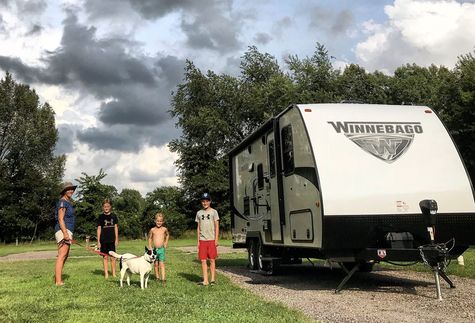
RV Solar Panels: A Beginners Guide To Going Solar
Interested in learning more about RV solar power? Jesse and Lauren Stuart share their tips for using solar panels on your RV.

Share this experience
Do you want to install RV solar panels on your camper or RV and don't know where to start? From RV solar systems to inverters, and understanding what kind of solar panels are best for an RV, there’s a lot to consider when purchasing solar panels for your rig.
So why get RV solar panels installed? RV solar panels are a great way to power your RV when you’re looking to break away from electric hookup sites and try dry camping or boondocking . When you have RV solar panels and a solar system set up in your RV or camper, you'll be able to power all or some of your RV’s electrical needs like lights, appliances, and even your RV air conditioner.
Whatever size RV you have, before you purchase your RV solar panels, there are a few things you need to know.
RV Solar Panel Systems: Which Is Right For Me?
You have two options to consider when choosing solar panels for your RV or camper
1) Portable RV Solar Panel System
A portable RV solar panel system is the easiest to set up and use. These systems typically plug into a dedicated solar plug on your RV and include one or more 100-watt solar panels that can be attached to your roof with Velcro straps. Other portable solar panels come in a suitcase. You connect the panels via a cord and place them in an area around your RV that gets the most sun.
The portable RV solar panel system is a great choice for RVers who don’t need a lot of power. Maybe you want to use your lights, charge your devices (i.e. phones, computers), and top off your trailer batteries. This option can also be the lowest overall cost to entry, but note you will probably pay more per watt for the convenience of portability.
2) Permanent RV Solar Panel System
Installing permanent RV solar panels is more expensive up front, but this option is the most efficient. You'll get the best bang for your buck per solar watt, can maximize any unused roof space for panels, the panels will be constantly collecting sunlight (i.e. while driving), and the panels don't require setup once you’re parked.
Permanent RV solar panel systems are typically installed by an RV dealer or professional companies that specialize in RV solar panel installation. These systems are designed for those who are trying to maximize solar power not just to charge devices, but also to operate appliances like refrigerators, microwaves, coffee makers, and even air conditioners.
RELATED: 8 Tips For Off-Grid RV Adventures
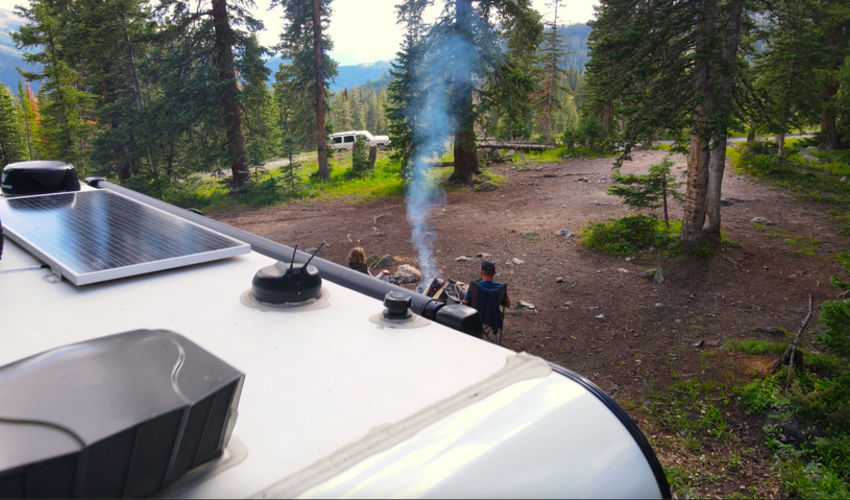
How Many Solar Panels Do I Need To Run My RV?
First, you need to determine your RV's power needs. RV solar panels are rated in watts, and you'll need to know the wattage (or watt hours) of all the devices you want to run on solar power — think your refrigerator, microwave, phones, TV, etc. For anything that uses electricity in your RV, you need to calculate watt use.
Calculating Watt Use
Locate the amps (or watts) on your devices to determine their usage. You need to convert everything to watts, so if a device only has amps, multiply it by the volts to get watts.
Example: A 120-volt rice cooker that draws 3 amps converts to 360 watts (120 x 3).
Once you know the watts per device used, determine how long you use it daily and multiply it by that “use rate” to get its daily watt usage or watt-hours.
Example: Using the above rice cooker for 30 minutes or 0.5 hours consumes 180 watt-hours (360 watts x 0.5).
Calculating How Many Solar Panels You Need
Once you determine your watt use, you can calculate the number of RV solar panels and how many watts of solar you need.
Most people think that a 100-watt solar panel produces 800 to 1,000 watts of power per day (8 to 10 hours of daylight). Unfortunately, that’s not the case. A conservative rule of thumb is that per 100-watt solar panel, you'll collect about 350 watts per day due to things like weather, optimum sun angle/exposure, and panel efficiencies.
Example: You have one phone at 5 watts to charge for an hour, you use a rice cooker that uses 360 watts for 30 minutes and you use a blow dryer that uses 1,500 watts for 6 minutes.
Phone: 5 (watts) x 1 (hour) = 5 watts
Rice cooker: 360 (watts) x 0.5 (hours) = 180 watts
Blow dryer: 1,500 (watts) x 0.1 (hours) = 150 watts
Total: 5 (watts) x 180 (watts) x 150 (watts) = 355 watts per day
Given this example, a 100-watt solar panel would be sufficient enough to generate enough power to charge your battery and run your devices each day. (Consult with the company installing your panels to determine the panel amount you need.)
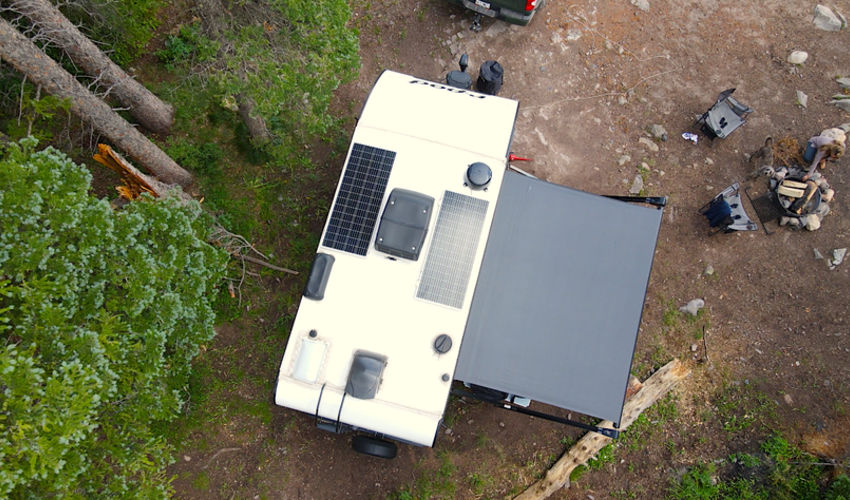
What Else Do I Need For My RV Solar Panels?
You'll need more than just solar panels for your RV. There are a few more pieces to pick up, such as:
- Battery bank
- Charge controller
Battery Bank
Batteries store the electricity produced by the solar panel so that your RV can still be powered when there’s no sunlight available (i.e. at night or during bad weather). Technically, solar panels don’t power devices, the solar panels charge the battery and the batteries are what supply the power.
Most batteries are either 24 volts or 12 volts and rated in amps (or Ah). Ideally, you want a battery that has enough capacity to power all your devices and appliances for a couple of days. That way if you have a day of no or low sunlight, you still have some juice to power your devices and appliances.
RELATED: Boondock Basics: The Only Gear Guide You’ll Ever Need
To find out how much battery you need (amps), calculate your watts and divide by volts.
An inverter charger converts DC power (produced by solar panels) into AC power that can be used by your RV's electrical system. It also can take AC power and convert it to DC power to charge your batteries.
To determine how large of an inverter you need, take the total watts you’ll use at any given time and multiply that number by 1.25.
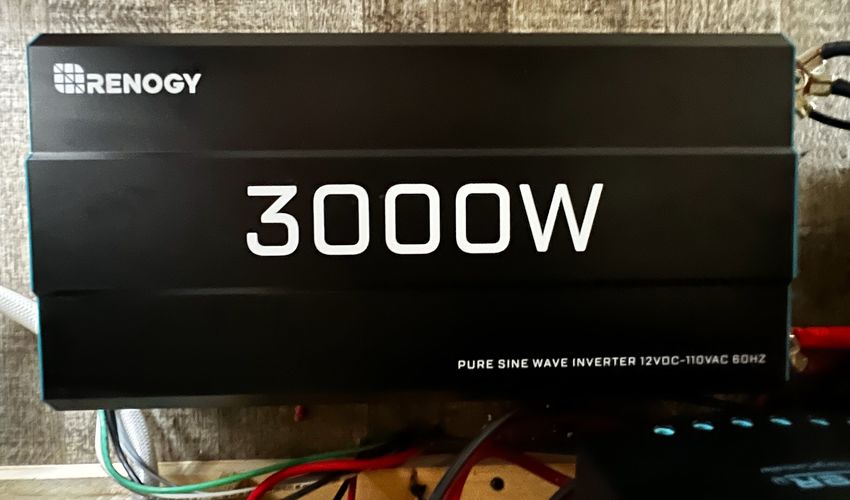
Charge Controller
Lastly, you’ll need a charge controller. The main purpose of a charge controller is to create a one-way street for energy. The charge controller takes the energy generated from your solar panels and channels it to your battery bank.
The charge controller also monitors and stops potential issues like overcharging or discharge, which can ultimately damage your battery.
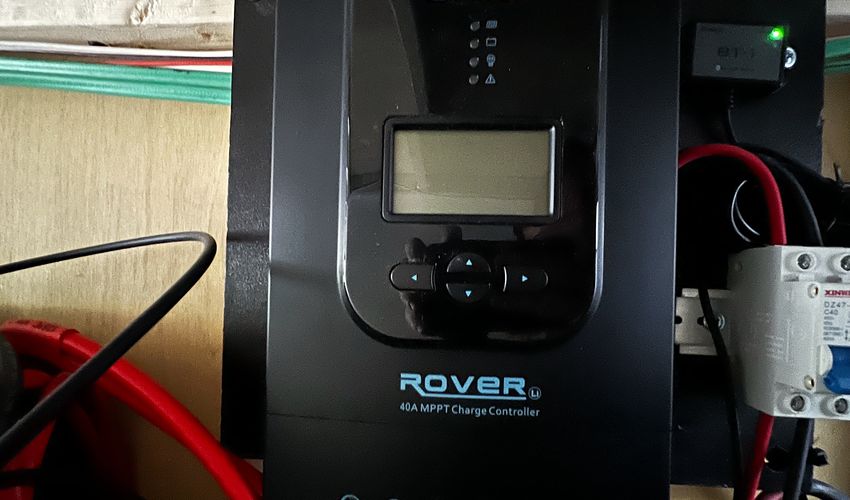
Are RV Solar Panels Worth It?
While the answer might be different for each person, there is time and money involved when deciding to add a solar panel system to your RV or camper.
Installing solar panels on your RV is ideal for those who:
- Are looking to get a little more off-grid when RVing; installing solar panels allows your RV to power up, instead of being connected to campground electric hookups/power.
- Are looking for a more sustainable solution to sourcing energy.
- Prefer the quiet collection of solar power over the hum of a gas-powered generator.
With research, time, and investment you can open up the possibilities of where you can go RVing.
The Wandering Stus
Lauren and Jesse Stuart, a travel blogging couple , along with their dog Huey cruise the country in their travel trailer sharing travel tips, itineraries, and their adventures along the way!
More Related Articles

The Right Stuff For Multigenerational Camping

Go Seasonal Camping in an RV
Outdoor decoration in the forest
8 Tips for Getting the Most Out of an RV Show
Jayco Class C at an RV show

Get More News & Inspiration!
Submit your email to get helpful tips and inspiration from Go RVing as well as information from our dealer partners on making your RV dream a reality.
* Indicates the field is required.

Beginners Guide to RV Solar Panels
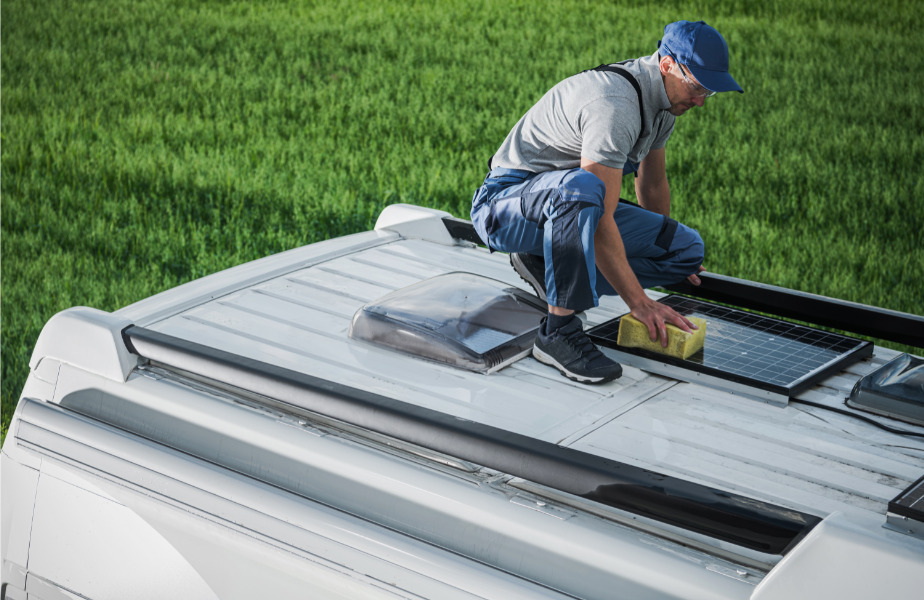
Sharing is caring!
Thanks for your support! If you make a purchase using our links in this article, we may make a commission. And, as an Amazon Associate, I earn from qualifying purchases. See the full disclosure here .
Thinking about adding an RV solar panel system to your motorhome or travel trailer but don’t know where to start? We understand. RV Solar panel power systems are a complex topic – it can be a little intimidating. There’s a lot to understand like wattages, types of RV solar panels, and the installation process. We’ll cover all that and more in our beginner’s guide to RV solar panels.
Let’s get started by talking a little bit about the science behind RV solar panels and how they work.
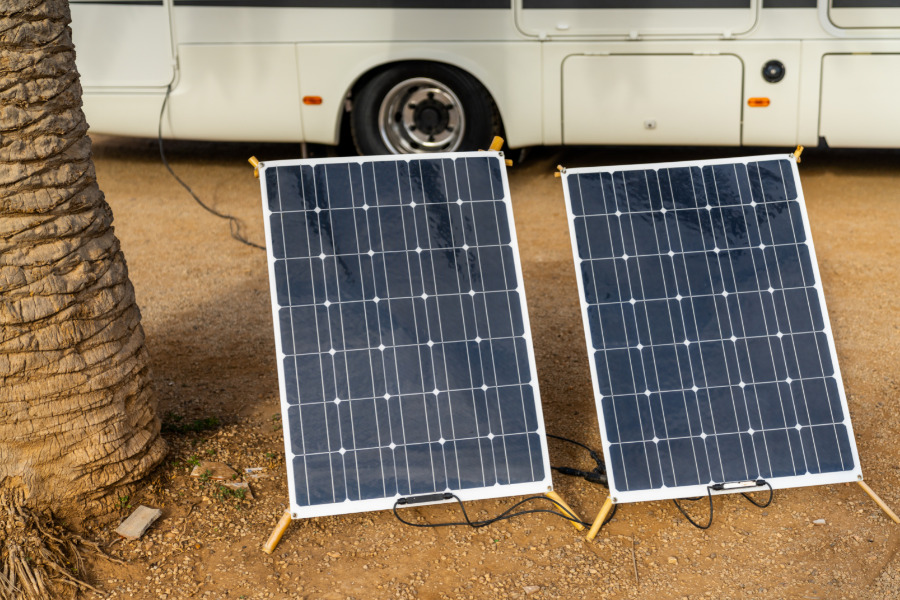
RV Solar Panel Basics: How Do They Work?
First thing’s first: how does an RV solar panel even make electricity (Don’t worry – you don’t have to be an electrical engineer to get the basic idea)?
The sun is constantly bombarding our planet with energy. In fact, it provides enough power to fill our entire planet’s energy needs 10,000 times over!
Using an RV solar panel, we can collect some of that energy and put it to use. A solar panel is actually made of several smaller solar cells . These cells aren’t very powerful on their own, but when combined together, they collect a significant amount of power.
You can think of a solar cell as a layered “sandwich,” where each thin layer is made out of silicon. The top layer has extra electrons that have a negative charge; the bottom layer has fewer electrons. This difference in charge creates an electrical field.
When sunlight hits the top layer of the cell, one of those extra electrons “jumps” free. Then the free-electron flows through the electrical field to a conductive metal plate. This plate collects the electrons and transfers them into the wires.
BOOM! You have electricity. From here, the electricity is stored in your RV batteries with the help of a charge controller. Filled up with solar power, your batteries power your RV.
But not all RV solar panels are created equal. There are actually a few different solar panel technologies available.
Types of RV Solar Panels
When you’re shopping for RV solar panels , you’ll notice two different kinds: monocrystalline and polycrystalline. Either one can be a great choice for RVers, but there are some important differences between them.
Monocrystalline RV Solar Panels
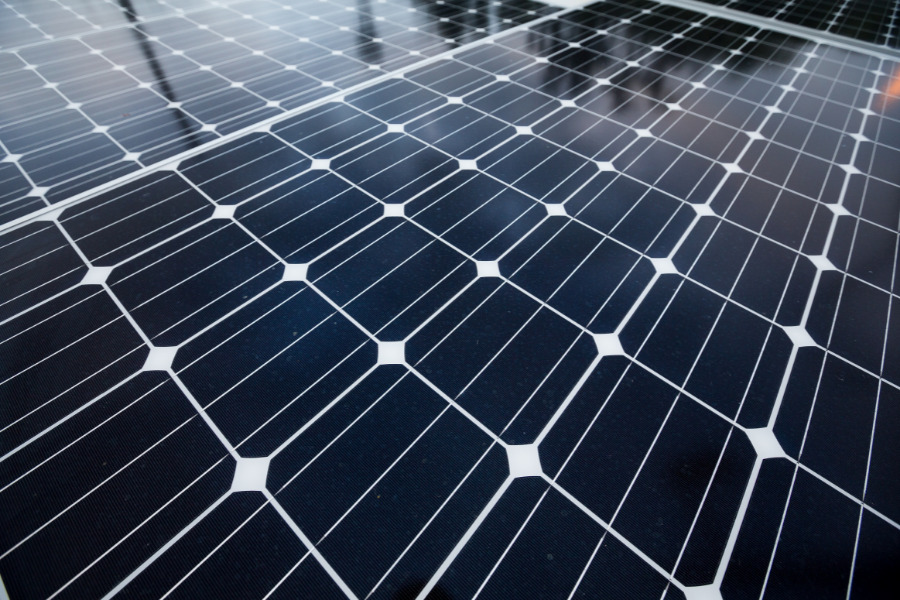
Like the name implies, monocrystalline panels are made out of one single silicon crystal. Or more accurately, a “slice” or “wafer” cut from a single huge silicon crystal. You’ll know when you’re looking at a monocrystalline panel because the cells will be black and octagonal.
Monocrystalline panels are the most efficient solar panels out there. They’ve got efficiency ratings between 15% and 20%. In other words, 15-20% of the sunlight hitting the panels converts to electricity.
This electrical efficiency also allows them to be slightly more compact than other panels. So, they’re also the most space-efficient option.
Polycrystalline RV Solar Panels
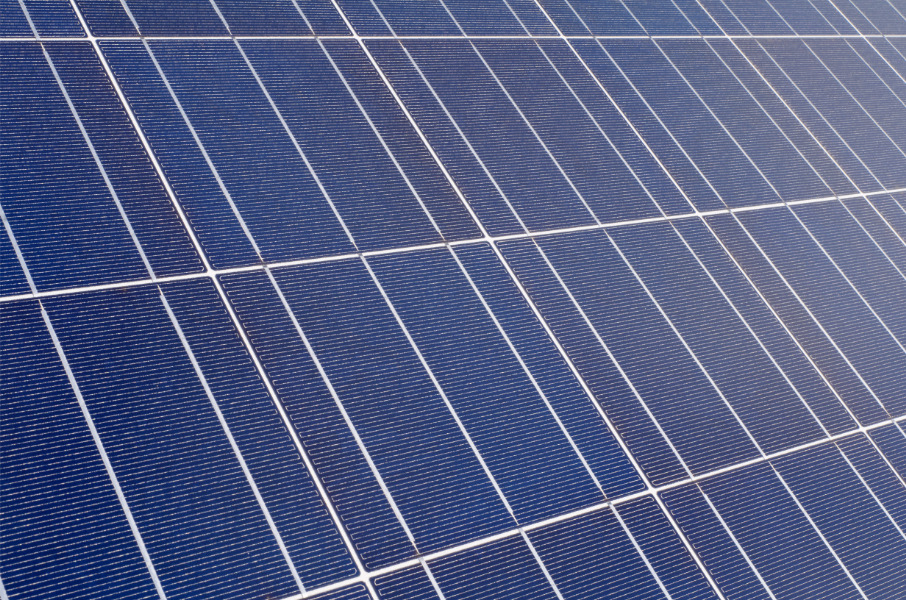
With a polycrystalline panel, instead of one big crystal, you have a bunch of smaller crystals melted together. These panels are recognizable by their blue, rectangular cells.
Polycrystalline panels are cheaper than monocrystalline panels, but they’re also less efficient. They’re only 13-16% efficient, compared to the 15-20% of a monocrystalline panel.
This lower efficiency isn’t the end of the world. In fact, a polycrystalline panel can still fulfill your power needs. Going with a polycrystalline RV solar panel setup can save you a few dollars on your solar setup.
Rigid vs Flexible Solar Panels
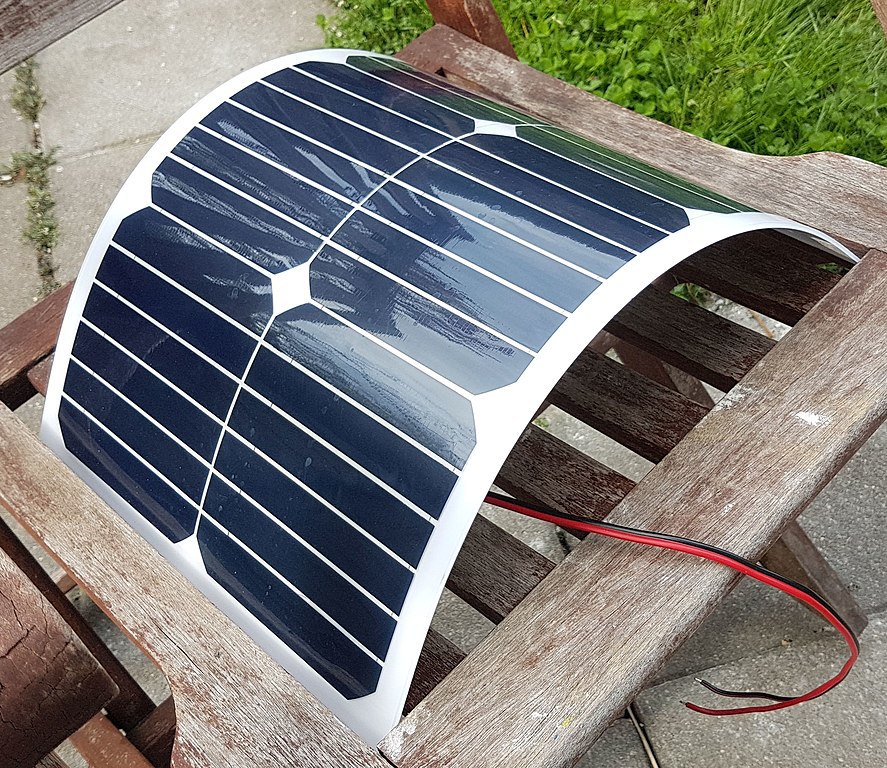
One last kind of solar panel is the flexible solar panel also known as a “thin-film” panel. Your “classic” RV solar panels are hard and rigid. Just like the name says, flexible solar panels can be bent into (almost) any shape or position.
The flexible nature makes these RV solar panels great for all kinds of applications. Plus, they’re much easier to install because you can use an adhesive. With rigid panels, you have to drill holes.
The big drawback of flexible panels is their low efficiency. Rigid panels – monocrystalline and polycrystalline – will have an efficiency somewhere between 13-20%. Meanwhile, flexible panels, are only 7-15% efficient.
Another potential problem is that flexible panels are more prone to damage. For example, driving through a wooded area and hitting a stray tree branch could scratch through the panel. You have to be a little more careful with flexible panels.
The big upside of flexible panels is their flexibility. And not just the literal kind; a flexible solar panel can be used in lots of situations where a rigid panel might not work as well. For example, attached to the curved side of a teardrop camper.
Roof Mounted vs Portable RV Solar Panels
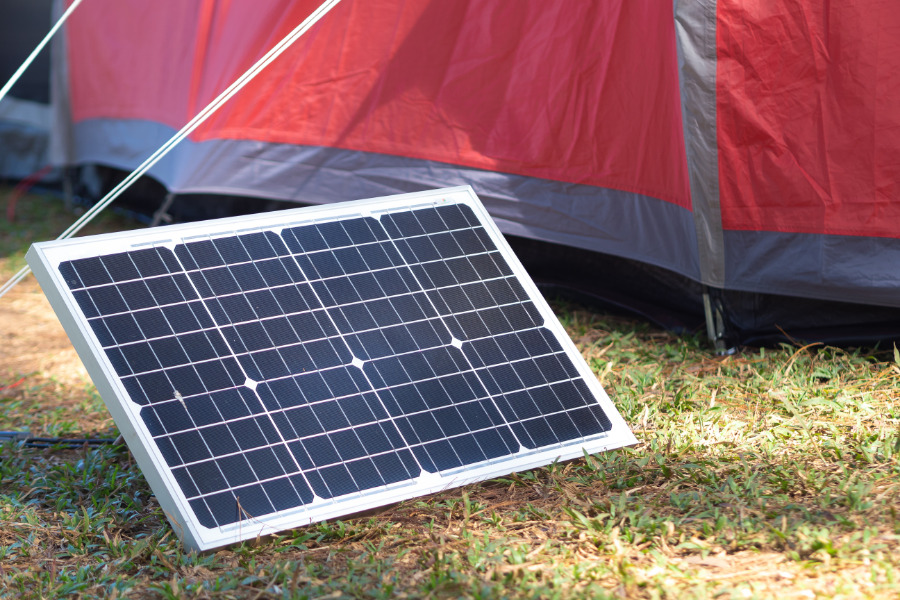
When you think of RV solar panels, you probably think about them being permanently installed on the roof of a motorhome or travel trailer. But did you know that there are solar panels you don’t have to install?
Enter the portable RV solar panel. Rather than being permanently attached to your RV, these solar panels fold up for storage when they’re not in use. When you get parked at your sunny destination, you simply pull them out and attach them to your battery whenever you need them.
Portable solar panels have a bunch of advantages:
- There is no need for installation which can involve hours of hard work
- You don’t have to worry about where your RV is parked; the solar panel can be moved for the best sunlight
- Portable solar panels are often more affordable than a full, RV rooftop solar install
However, there are some drawbacks to portable solar panels too:
- You’ll need space to store your panel when you’re not using it
- Every time you need to power up your battery, you have to take out the portable panels and set them up
- If you’re RVing in a shaded area, you might have to move the panels throughout the day to chase the sun
- If you need a lot of power, portable panels might not be sufficient
Portable RV solar panels might not replace a full rooftop array of solar panels but they’re a great (easy) way to get started with solar power.
How Many Solar Panels Do You Need to Run An RV?
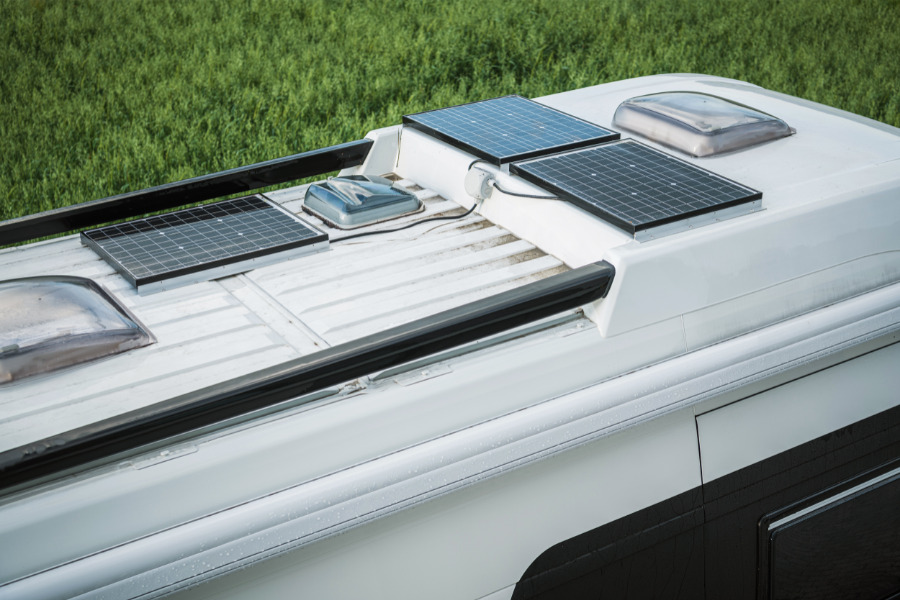
You’re probably wondering, how many solar panels you’ll need for my RV? The exact number depends a lot on the panels you’re using and your power needs. Some people might only need one or two panels, but others will need six or more!
An important thing to remember is it’s not really the number of panels that matter – it’s the number of watts. Three 100-watt panels are the same as one 300-watt panel. So, what you really want to know is how many watts you need.
You’ll notice when you look at RV solar panels that they all have a certain wattage rating. Your average RV solar panel is rated between 100 and 400-watts. You can find higher and lower ratings too.
To put it simply, more watts mean more power. Keep in mind that these ratings are under ideal conditions. Your RV solar panels will give you less power if it’s not a perfectly sunny day or if it’s under shade.
But wait, then how many watts do you even need? There are two main ways to calculate your power needs.
Calculating How Many Solar Panels Does an RV Need?
When calculating how many solar panels your RV needs, the best option is to do a power audit. This means calculating how much power everything in your camper is consuming.
Method 1: Boondocking
The best way to calculate your power needs is to spend some time boondocking. With this method, you can see just how much power you’ll need in a real-world scenario (Plus, you can cut loose off-grid and take a probably much-needed break).
Take your RV out and go for a camping trip, using everything as you normally would. Be sure not to use a generator. During the trip, you can track how long it takes you to drain your batteries.
To track your charge level, use a battery monitor or multimeter. If yours doesn’t display the battery level, you can calculate it using the voltage readout. When the voltage readout shows about 12.2-volts, your batteries are around 50% discharged.
To get the most accurate values, it’s helpful to take multiple trips. That way you can get a good average of your power consumption.
How to Calculate Battery Capacity
Battery capacity is measured in amp-hours or Ah.
For this example, let’s say you have 200Ah of usable battery power.
If you used 50% of the capacity in 20 hours, that’s 5Ah per hour (50% of 200= 100. 100Ah divided by 20 = 5Ah). Then multiply this by 24 hours to see a full day’s use: 5Ah x 24 hours = 120Ah per day.
As a general rule of thumb , a 100-watt solar panel will give you 30 amp-hours a day. So in order to get 120Ah per day (the amount of power calculated you need per day), you’d need at least 400-watts of solar panels.
Method 2: Adding up Your Electronics
Another way to estimate your power needs is by adding up the power you’ll consume every day through the electronic devices you commonly use. This is a more time-consuming method and not as accurate. If you can’t take your RV out boondocking then it might be your only option.
There are plenty of wattage worksheets and tools online to help you calculate your power consumption. Parked in Paradise has a comprehensive version that accounts for how much power you have coming in and the devices you use. It’s fully interactive, so you can just input the information and it will give you the numbers. Whatever worksheet you use, the general process is the same.
You’ll want to round up all the electronics in your RV and put them on the list (ex. your coffee maker, hairdryer, air conditioner, fans, laptop chargers, etc.). Then you’ll need to find the wattage of each device. This information should be written somewhere on the device or its power source.
Once you have the wattage, you’ll need to estimate how many hours a day you’ll use each device. Then fill in the worksheet with this information. You’ll also need to know if the device runs off AC or DC power.
Once you’ve input everything, most worksheets should do the math for you. Viola! You’ll know how much power you need in a day.
From here, matching the solar panels is the same as before. A 100-watt panel will give you about 30 amp-hours per day. So, for every 30-amps consumed, you’ll want another 100-watts of power.
What Other Components Do You Need for an RV Solar Panel System?
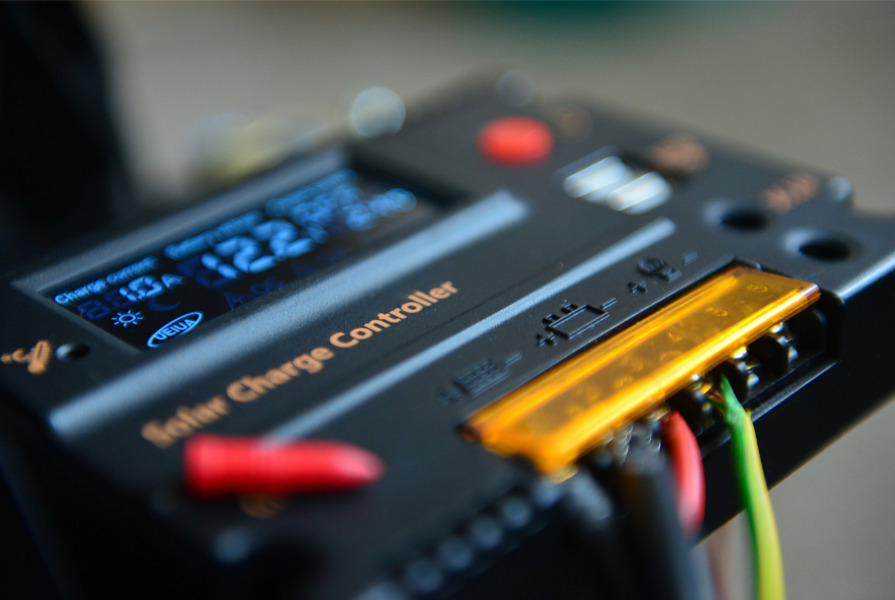
There are other components you’ll need for your RV solar panel system. So far, you’ve figured out how many RV solar panels you need and decided what type of panel you want. Getting the energy to the house batteries requires additional equipment.
You need somewhere to store electricity (your house batteries) and something to control charging (the aptly named charge controller). And if you want to power 120v AC devices, you’ll also need an inverter.
Battery Bank
While the RV’s solar panels make the electricity, house batteries (not the engine battery) are what actually powers your motorhome and the electronics. All the batteries together are referred to as your RV’s “battery bank.” There are two different kinds of batteries used in RVs: lead-acid and lithium batteries.
Lead-acid batteries are cheaper, but they’re also less efficient. You can only discharge them to about 50%. They also need to be replaced every few years (more frequently if you habitually discharge them below 50%).
There are a few different kinds of lead-acid batteries, but absorbed glass mat (AGM) batteries are usually the best choice. Deep-cycle or marine-grade AGM batteries are specifically designed to work as house batteries. These batteries can be discharged the most, last the longest, and don’t require any maintenance.
Lithium-ion batteries are pricier, but they’re more than worth it. These batteries can be discharged almost completely and can last up to 10 years before needing replacement.
Your RV is probably already equipped with a battery bank. But it might be worth considering an upgrade. Upgrading to lithium and/or adding more batteries can give you more power and let you stay out boondocking for longer.
RV batteries will have an Ah rating showing how much power they can supply on a single charge. Adding together the amp hours of all your batteries will tell you how much power you can draw before needing to recharge them. When combining batteries, always make sure they’re the same type.
Charge Controller
You can think of the charge controller as the “brains” of your solar setup. It takes the high voltage coming from your RV solar panels and throttles it down to something your RV battery can actually use. The charge controller also ensures your batteries get charged properly and don’t get damaged.
There are two different kinds of charge controllers:
- Pulse width modulation (PWM)
- Maximum power point tracking (MPPT)
PWM controllers are more affordable, but they’re also less efficient. A PWM controller is really only recommended if you have a smaller setup (200-watts or less).
MPPT charge controllers are the more efficient option. With an MPPT controller, you’ll always get the perfect charge. They’re well worth the investment and if you have a larger system, you definitely want an MPPT charge controller.
When you’re picking a charge controller, you’ll also need to match it to your solar panels and batteries. The exact process depends on what type of controller you choose. Thankfully, Renogy has a great guide to choosing your charge controller.
With solar panels and a charge controller, you can charge your batteries. But you’ll need an inverter if you want to power most of your electronics.
But why can’t I just run my electronics off the battery? Because the power coming from your battery is 12 volt DC (“direct current”). Many components in your RV, like lights and the 12v fridge, can use that 12v DC power without a problem. But other devices, like TVs, phone chargers, and coffee makers need to use 120-volt AC (“alternating current”) power. Simply, an inverter takes your battery’s 12v DC power and “inverts” it into 120v AC.
When choosing an inverter, you’ll need to know how many watts of power your electronics consume in a day. Then add 15% to have a bit of a safety buffer and find an inverter that’s rated for (at least) that number of watts.
When you’re looking at inverters, you’ll see “modified sine wave” and “pure sine wave” inverters . Modified sine wave inverters are less expensive than a pure sine wave. But if you want to power modern electronics like TVs, laptops, and phones, you’ll need a pure sine wave inverter.
How to Install Solar Panels on Your RV Camper
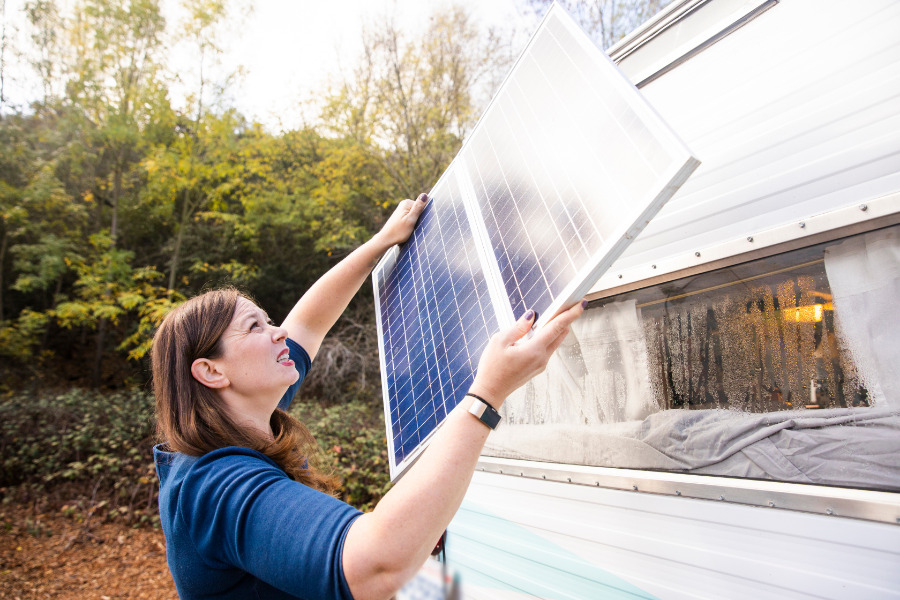
Installing solar panels on your RV camper has four main steps:
- Mount your RV solar panels
- Run your wires
- Connect the charge controller
- Install your inverter (if needed)
We’ll go over the basic process for each step. But keep in mind that this is just a general guide. Every part of your solar system should come with installation instructions; you should always read and follow them closely. Consult with a professional if you need help.
Step 1: Mounting Your Solar Panels
Before installing anything, you should measure, plan, and mark out the space where you’ll install your RV solar panels. It’s a good idea to also arrange the solar panels on the roof before doing any installation. That way, you can make sure everything fits properly.
When planning the layout of your solar panels, make sure they won’t get shaded by things like air conditioners or other components on your RV roof. If they aren’t exposed to full sun, your panels won’t be able to perform at maximum efficiency.
Once you’ve got everything planned out, it’s time to install.
If you’re using flexible panels, you can attach them with screws or an adhesive. This is as simple as cleaning your roof and carefully sticking your panels on with the adhesive. If you screw them in, remember to use some sort of waterproof seal to prevent moisture from getting through the hole the screws are using.
For rigid panels, you’ll have to attach them to the roof with brackets. In most cases, this means you’ll have to do some drilling. If it concerns you out to drill holes into your RV roof (and that’s normal), there are no-drill brackets that use an adhesive instead.
There are also brackets that will allow you to rotate your panels to meet the sun for maximum power converting abilities. These are pricier but can help you maximize your solar efficiency.
If you’re going to drill, make sure you carefully mark everything first. Attach the brackets to the RV solar panels first and then use them as a guide. Keep your RV roof watertight by applying sealant below the bracket to create a watertight seal.
Step 2: Running Your Wires
After mounting your new panels, you’ll need to wire your RV solar panels to your charge controller and the charge controller to the battery bank. The provided wires on solar panels are commonly too short for this. So you’ll need what’s called an “MC4 connector” to extend your cables.
To connect the wires to the charge controller, you’ll need to get the wires inside your RV.
The best and easiest option is to run them through your refrigerator vent. This way you don’t have to put any extra holes in your RV. You can also use any pre-existing holes where plumbing enters the RV. Check your owner’s manual; some of today’s motorhomes and travel trailers come prewired for RV solar systems, so the wiring may already be in place.
If the refrigerator vent or plumbing lines aren’t an option, you’ll need to pull out the drill again and make an entryway for the wires. Consider doing this above a cabinet or interior wall so you can hide the wiring.
Before wiring everything up, it’s a good idea to have a wiring diagram. You can draw this up yourself. Another option is using one of these wiring diagrams from EXPLORIST.life to get you started.
Step 3: Connecting Your Charge Controller
Next, you need to connect to your charge controller. You’ll want to mount your charge controller as close to your battery bank as possible. This minimizes the voltage drop over the length of the wire and ensures your batteries get enough juice to charge.
Once your charge controller is mounted, it’s time to connect your wires. Make sure to follow the instructions provided with your charge controller. Some might recommend connecting the solar panels first, while others recommend connecting the batteries first.
Make sure to clearly mark the polarity of your wires (red=positive and black=negative). (You can test them with a multimeter.) Then connect everything according to the instructions.
If you’ve done everything correctly, you shouldn’t see any flashes or sparks. Hurray! Your batteries can now be charged with the power of the sun! If you want to use your 120v devices, you’ll need to do one more thing: install an inverter.
Step 4: Installing Your Inverter
Your inverter will take the power from your batteries and make it usable by most of your electronics.
There’s a decent chance your RV already has an inverter. It’s not strictly a part of your solar system, but you’ll need one if you want to get the most out of your new RV solar panels.
Your inverter connects directly to your batteries and should be installed close to them. Just like with everything else, you should carefully follow the instructions for installing your inverter. The basic process will look like this:
- Attach the positive and negative wires to the inverter
- Connect the negative side to the battery posts first
- Connect the positive side
Once everything is attached, you’ll be able to use your inverter to power all your 120v AC devices.
RV Solar Panel Wiring: Series vs Parallel
When you’re wiring multiple solar panels, you’ll have to decide if you want to wire them “in series” or “in parallel.”
In Series Wiring
In series means that the positive terminal of each panel connects to the negative terminal of the next, one after the other.
When solar panels are wired in a series, you get a higher voltage because the voltage of each panel is combined. For example, if you have three 18-volt panels, you’ll get 54-volts in optimal conditions.
This is important because your batteries will need a certain voltage in order to charge. For example, this BattleBorn LiFePO4 battery needs at least 14.2-volts. If the voltage drops below this value, the batteries won’t charge.
Wiring in series has a major downside though. If shade covers just one panel in the series, it reduces the power output from every other panel along with it. When wiring in series, every panel is important.
In Parallel Wiring
To wire the panels in parallel, you connect all the positive terminals together, then do the same with the negative terminals.
When you wire in parallel, the output voltage for all the panels is the same as a single panel. So, you could have eight 18-volt panels and the output would still be 18-volts.
However, solar panels wired in parallel are less affected by shade. Because they can operate independently, if one panel goes down, the rest will continue to work just fine.
It’s worth keeping in mind, however, that when wiring in series, you have a lot more voltage to spare. With only 18-volts, you need at least 80% efficiency to charge your batteries. But with the 54-volts from our series example, you could charge the batteries at only 30% efficiency.
Those that have 30-amp RVs may want to choose parallel wiring. Your electrical system might not handle the higher voltage that series wiring offers. Consult with a professional before you get started to avoid damaging your RV’s electric system.
One last thing to consider is your charge controller. If you have a PWM controller, it’s recommended you connect your panels in parallel. But with MPPT controllers, in series is better.
What Are The Benefits of an RV Solar Panel System?
There are a ton of benefits to having an RV solar panel system!
Solar Energy is Eco Friendly
Solar power is a clean, renewable energy source. You’re taking just a little bit of the massive amount of power generated by the sun ( 384.6 septillion watts !) and putting it to use.
Your other options for electricity in an RV aren’t nearly as good for the Earth. Shore power overwhelmingly comes from fossil fuels ( about 60% ). A generator also requires you to burn fuel (gas, diesel, or propane), creating emissions. But with solar panels, you can rest easy that your electricity is 100% eco-friendly.
You Can Go Anywhere and Still Have Power
With solar panels on your RV, as long as there’s sunlight, there’s power. You’ll be able to really get away and get the most out of secluded spots. If you enjoy boondocking, you’ll love the freedom of solar power.
You Can Get Off The Grid For Longer
You can use a generator when boondocking, but you’re limited to how much fuel you can bring. With solar panels, the only limit is good weather. That means you can keep your batteries charged and stay off the grid for as long as you want.
Solar Panels Are Low Maintenance
Your solar system has no moving parts and is practically zero maintenance. The only thing you’ll need to do is clean your panels every so often.
This means that once your system is installed, you’ll never have to worry about a thing. Your solar panels will keep powering your RV for years.
Solar Panels Are Completely Silent
Ah, the sound of silence.
Even the quietest generator is going to make some noise. This can be frustrating for you and anyone near your RV. And in some places, such as state parks, you can only use your generator at certain times.
But you’ll never have to worry about noise pollution with solar panels. They don’t make a sound; you’ll barely even notice they’re there!

It’s Easy to Upgrade Later
Want to upgrade to a solar system, but don’t have a big budget? No worries! A solar system is easy to upgrade further down the line.
Whenever you’re ready to upgrade an existing system, all you’ll have to do is add more solar panels and redo the wiring. Then you’ll be able to enjoy even more solar power from your panels.
How Much Does RV Solar Power Cost?
Get out the checkbook. There’s a huge price range for RV solar power systems. The price will depend on a few things like:
- The amount of wattage output of your solar panels
- Type of charge controller (PWM vs MPPT)
- Your existing battery bank (if installing new batteries or upgrading your existing ones)
- DIY installation vs professional installation
For a small, DIY solar system, you could get it done for around $600 or maybe even less. But for a larger system, especially with a professional install, you’ll probably spend anywhere from $2,000 to upwards of $5,000. An especially powerful solar system could even cost more than $10,000.
One option for those trying to save money is a portable solar panel. A portable solar panel with a charge controller can be purchased for between $200 and $350. These won’t replace a full solar system, but it is a great budget option to get you started.
Are RV Solar Panel Kits a Good Idea?
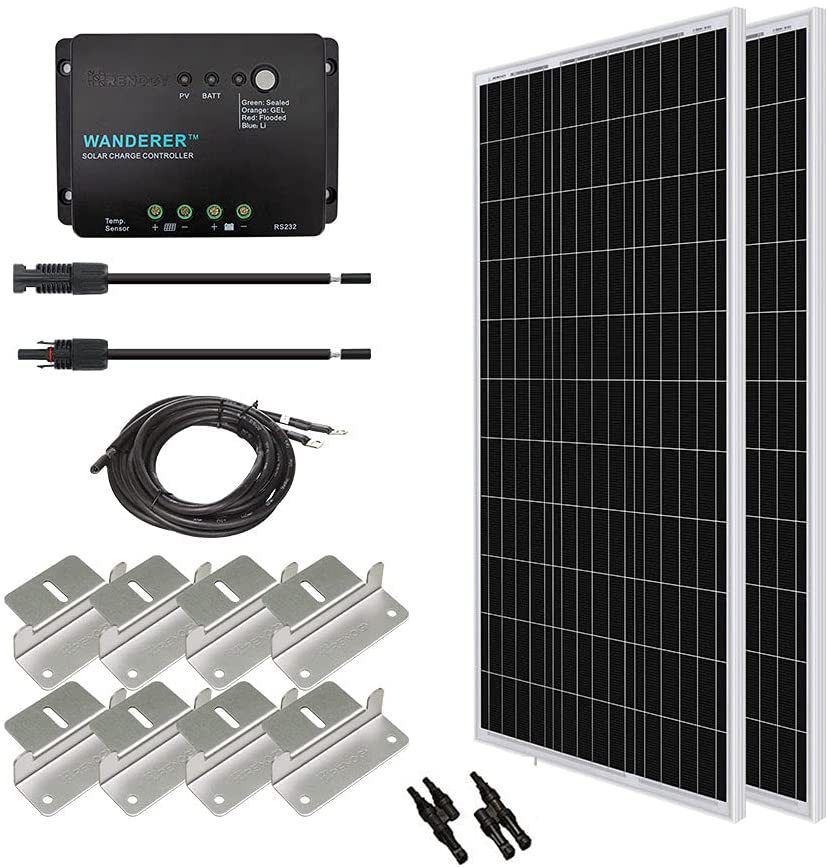
RV solar panel kits will include everything you need for a solar power system (except the batteries). With a kit, you won’t have to worry about choosing all the different parts of your solar setup. Panels, a charge controller, wires, brackets, and sometimes even an inverter will be included.
Because of this, RV solar panel kits aren’t just a good idea, they’re a great idea! Take the guesswork out of your solar setup. With a kit, you can be sure all the different parts will work together. And you can save time because you don’t need to select everything individually.
Our Top RV Solar Panel Recommendations
Here are our top RV solar panel recommendations to help you navigate through all of the options.
Renogy 200-Watt Monocrystalline Solar Panel
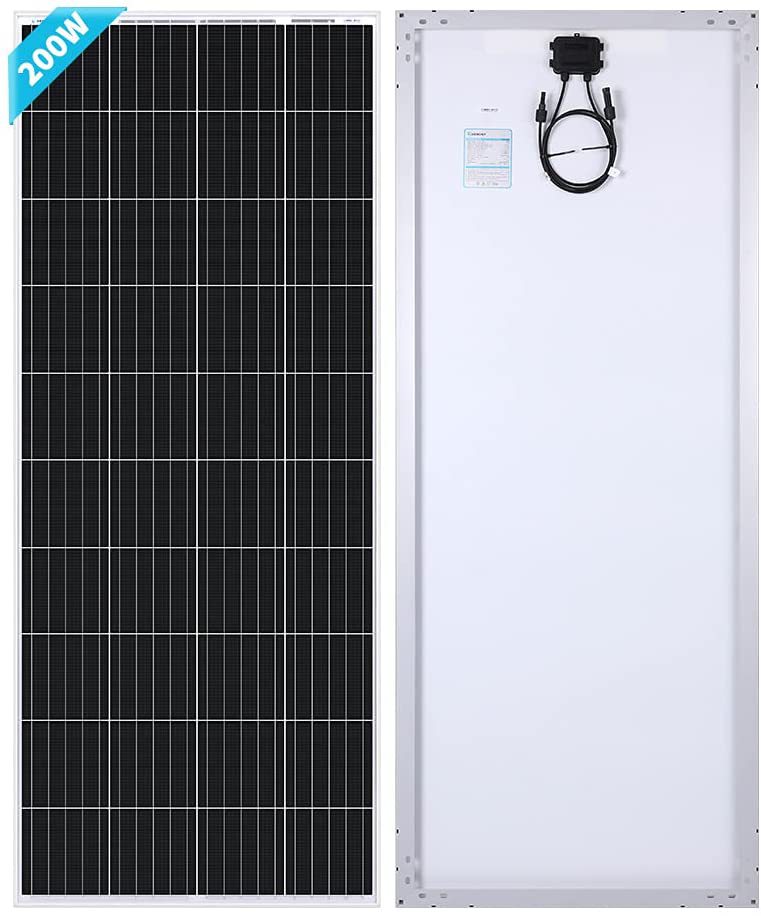
Renogy is one of the biggest names in solar power. They’re well known for their durable, high-quality solar panels. That’s why we recommend their 200W 12V monocrystalline solar panel as a great foundation for a powerful solar system.
This solar panel is nice and sturdy. They’re designed to resist high winds, snow, and rain. Plus, they have a 25-year warranty that guarantees the panels will maintain 90% efficiency after 10 years and 80% after 25 years.
If you need a smaller panel, Renogy’s 100-watt panel is also a great choice. Renogy also sells full solar kits, like this solar panel kit that includes a 100-watt panel, charge controller, cables, and mounting brackets.
Renogy 175 Watt Flexible Monocrystalline Solar Panel
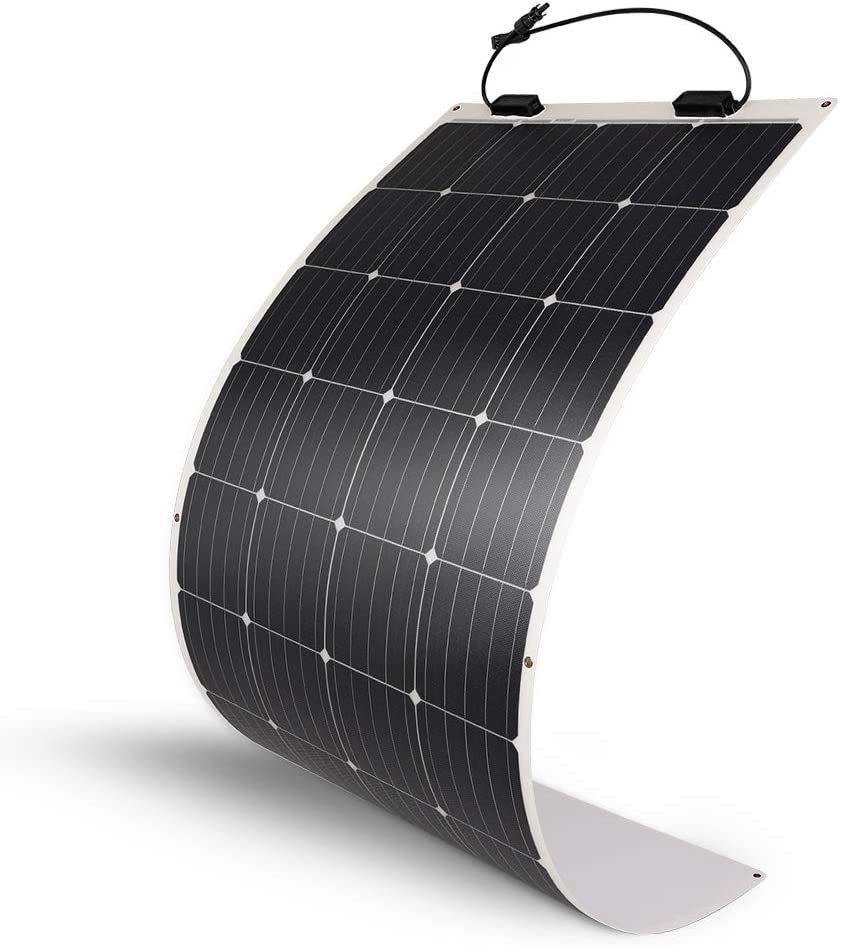
If you need a little flexibility, we recommend Renogy’s 175-watt flexible monocrystalline panel . Just like Renogy’s rigid panels, this flexible panel is powerful, sturdy, and long-lasting. It’s also super lightweight (only about 6 pounds) and slim (only 1/10th of an inch).
Renogy also makes 50-watt and 100-watt flexible solar panels. And of course, they also sell kits with everything you need, like this 100 watt kit.
Windynation 100 Watt Polycrystalline Solar Panel
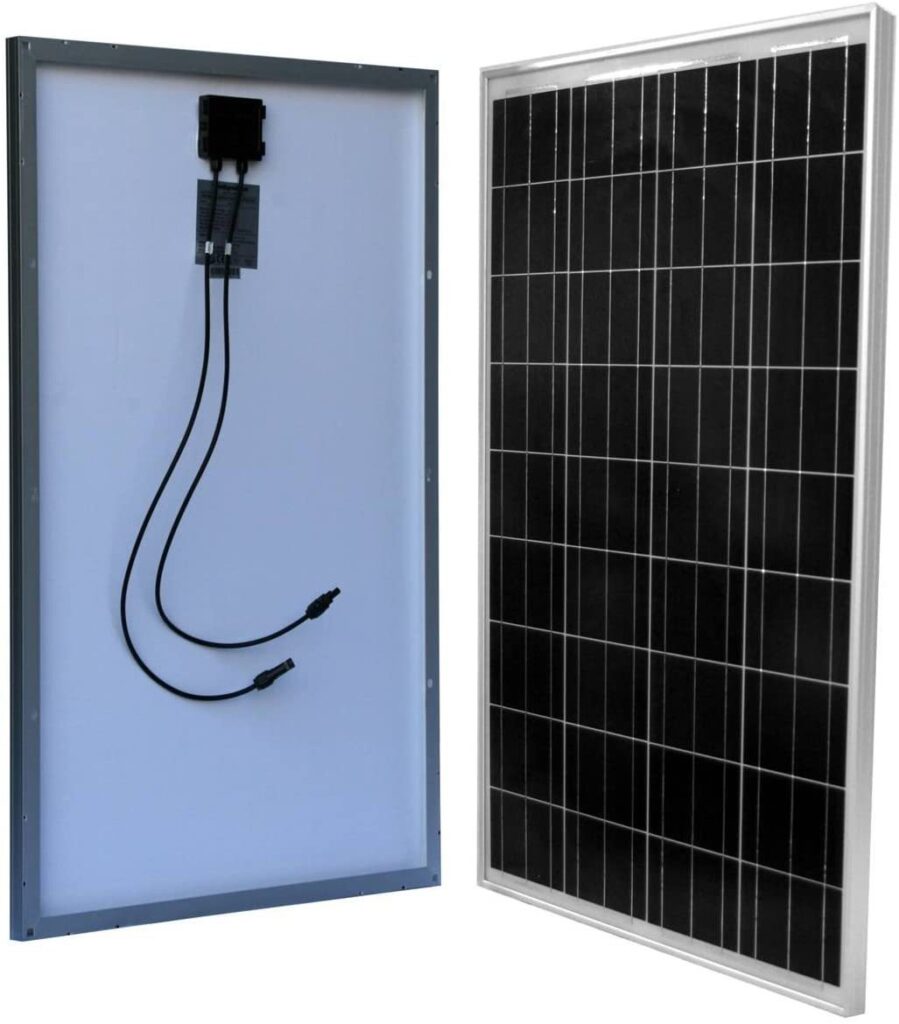
Polycrystalline panels aren’t quite as efficient but they’re more affordable. This 100 watt polycrystalline panel from Windynation is highly recommended for a less expensive solar build.
The Windynation panels are highly rated and sturdy. Plus they’ve got a 5-year warranty for parts, labor, and a 25-year power warranty.
HQST 100W Polycrystalline Solar Panel
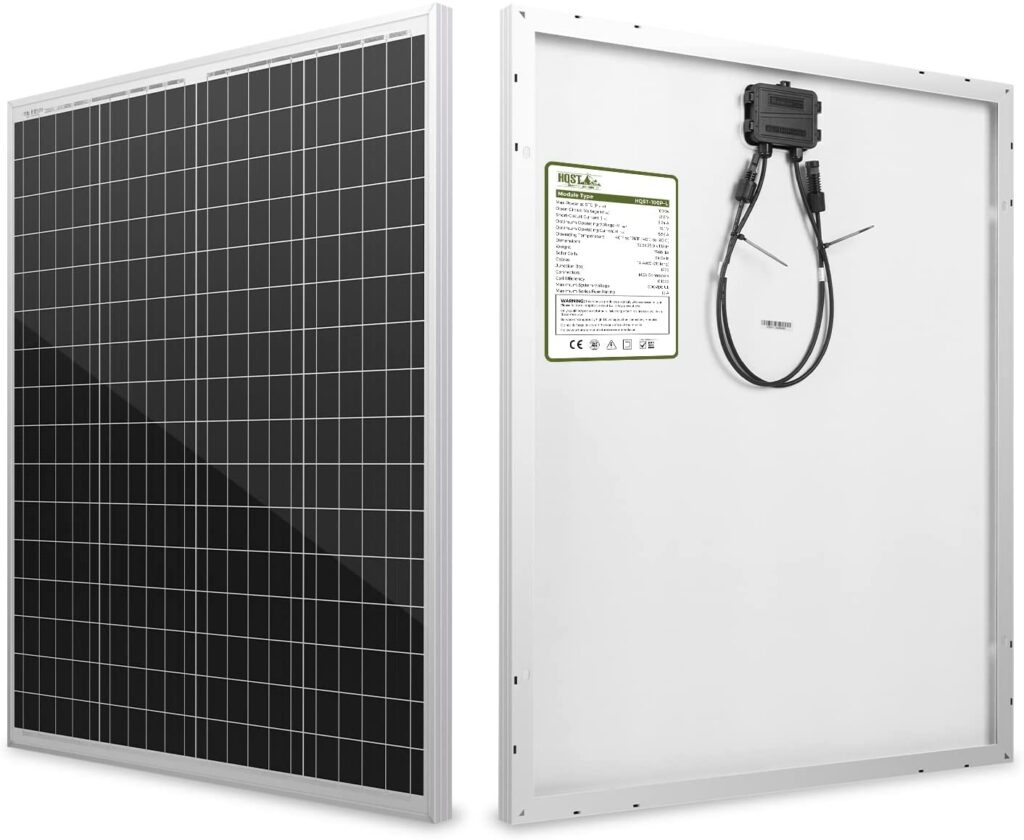
Another great budget option is the HQST 100-watt polycrystalline solar panel . They’re one of the most affordable solar panels you’ll find, but they don’t sacrifice quality.
These panels are waterproof, sturdy, and designed to withstand the elements. At only 14 pounds, they’re also fairly lightweight.
Renogy 100 Watt Monocrystalline Foldable Solar Suitcase
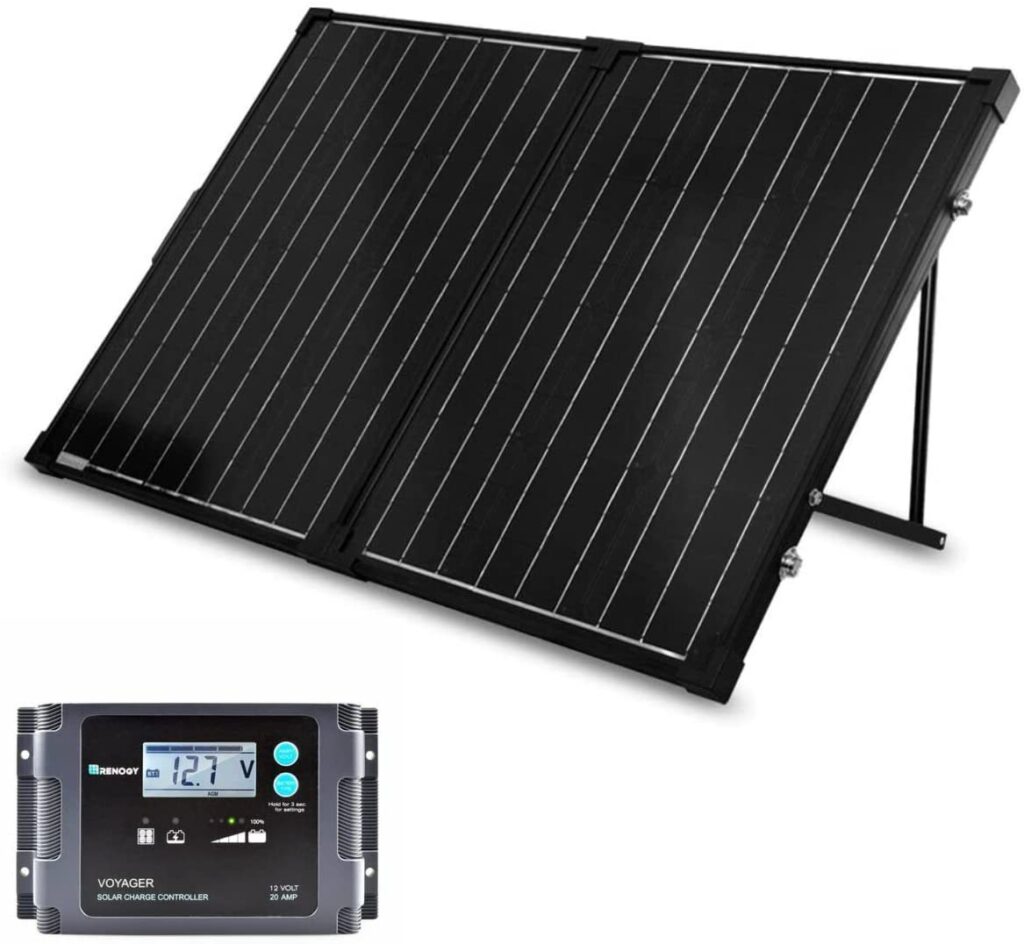
If you want a portable solar solution, we recommend the Renogy 100-Watt Monocrystalline Solar Suitcase . This foldable solar panel comes equipped with a charge controller and a protective case. Just unfold it, attach it to your batteries, and you’re ready to go.
Just like Renogy’s other panels, these are heavy-duty and fully waterproof. If you need more power, they also make a 200-watt version .
Are RV Solar Panels Worth It For You?
RV solar panels can be worth it for you and there are a ton of great reasons to install them on your RV. It’s a clean and quiet source of energy that gives you freedom from shore power and fuel sources. But, are they right for you?
Of course, it’s going to depend on your situation. If you only take your RV out for a few days at a time, it might not be worth investing in a full solar setup. The same is true if you mostly stay at RV parks and don’t care about going off-grid.
Solar panels aren’t cheap, and installing them means hard work (or paying someone to do the work for you). If you’re on a tight budget, you might want to hold off on making the jump to solar.
On the other hand, if you think you’re ready to take advantage of solar panels, then it’s well worth the investment. If you want to go farther and stay out longer in your RV, you’ll love the freedom solar power gives you. For those that want to get serious about boondocking, solar panels are a must-have power source.
In fact, even if you’re on a budget or don’t need a lot of power, there are still solar options for you. Portable solar panels are a great and super easy solar solution that’s usually cheaper than a full setup. And flexible panels are also a great choice because they’re both cheaper and easier to install.
It’s Time to Harness The Power of The Sun!
If you want a flexible and eco-friendly power source you can use everywhere, it’s hard to beat solar. Solar panels let you harness the sun’s natural energy to charge up your batteries, anywhere you go.
Flexibility and freedom are huge reasons that adding solar panels to your RV is so popular. With solar power, you’ll be able to really get away and you won’t have to worry about finding a shore power hookup. As long as the weather is good, you’ll be able to keep your batteries charged indefinitely.
Solar panels are a bit of an investment, but they’ll let you truly maximize your RVing experience. With solar power, there’s no limit to where you can go!
Related Reading:
– Can Solar Panels Really Power an RV Air Conditioner? – 5 Best Portable Solar Generators for RV Life and Camping – Do You Need an Inverter to Run a 12v RV Fridge? – RV Boondocking Beginner Tips and “How-To” Guide – Do I Need a Battery for My Travel Trailer? – Green RVing: Sustainable Tips For RVers
Jennifer and Kendall are avid RVers and part-time van lifers who share their years of experience both as full-time RVers and nomads through writing.
Jenn and Kendall have explored Canada, the USA, and Mexico while RVing and living full-time in all 3 countries.
They have been fortunate to work not only as part of the RVBlogger team but also with RVLife, DIY RV, Camper Report, RV Magazine, Rootless Living, Vanlifers, and more.
They have also shared their RV experience through DashboardDrifters.com and are the founders of RVSpotDrop, a web service for full-time RVers.

1 thought on “Beginners Guide to RV Solar Panels”
Super useful and also well explained Many thanks.
Leave a Comment Cancel reply
Save my name, email, and website in this browser for the next time I comment.
Your Guide to RV Solar Panels: Components, Installation, and More
Which is more practical for your RV, a generator or solar panels?
David Kuchta, Ph.D. has 10 years of experience in gardening and has read widely in environmental history and the energy transition. An environmental activist since the 1970s, he is also a historian, author, gardener, and educator.
:max_bytes(150000):strip_icc():format(webp)/professional-headandshoulders-b7be2761c16e44438607bf932fc1993c.jpg)
- Wesleyan University, University of California, Berkeley
:max_bytes(150000):strip_icc():format(webp)/ScreenShot2021-04-07at1.57.45PM-bcef177316c94cdf998457c694cce6d5.png)
- University of Tennessee
Voyagerix / Getty Images
- Renewable Energy
- Fossil Fuels
RV Solar Components
Solar vs. generator: which is better, installing solar panels on your rv.
- Frequently Asked Questions
It's increasingly common to see solar panels on the roofs of recreational vehicles (RVs). While solar panels can't replace an internal combustion engine and turn your RV into an all-electric vehicle, they can allow you to run your lights and appliances cleanly rather than relying on a fossil-fueled generator.
Solar panels also give you the freedom to camp off-grid and in places that don't allow generators, rather than having to find a spot in a crowded campground with an available hook-up. And of course, with solar panels, you can reduce your carbon footprint.
Here, we discuss RV solar components and whether they are worth investing in for your next RV trip.
RV solar is not as simple as attaching solar panels to the roof and plugging in appliances. Here are the main components in an RV solar system.
Solar Panels
Panels can be flexible, portable, or rigid. Lightweight flexible panels are better suited when an RV roof is molded rather than flat, while portable panels can be placed anywhere on or off the vehicle, so they can capture sunlight even if the RV is parked in the shade. Rigid panels are much heavier, but they are also more durable and efficient. Panels may generate 150 watts in flexible and portable panels and up to 250 to 300 watts in rigid panels.
Most RVs have two batteries. A 12-volt lead-acid/AGM starting battery is used to start the engine, while a 12-volt RV "house" battery bank is used to run the DC-powered appliances, such as fans, lights, and water systems.
An AC/DC inverter can provide 120-volt power from a "shore power" hookup at an RV campground to power air conditioners, microwaves, and other energy-intensive appliances. In more modern RVs, older lead-acid RV battery banks have been replaced by lithium iron phosphate batteries charged by solar panels and the RV's engine alternator via DC/DC chargers. Together, these provide much more rapid charging and much longer-life battery banks, especially suited for off-grid use.
Some RV owners upgrade to lithium-ion batteries, which are lighter, more efficient, maintenance-free, can hold more energy, and have a longer lifetime. The downside is they cost significantly more.
Solar Charge Controller
A solar charge controller protects your battery by regulating the flow of electricity from solar panels to the battery. The controller matches the voltage output of the solar panels to the voltage capabilities of the battery or batteries.
Many RVs already have inverters that convert DC power from your 12-volt battery into 120-volt AC power used by your lights and other electrical equipment. More expensive inverters can produce more reliable and consistent power needed to run sensitive equipment like electronics or medical equipment.
Transfer Switch
A transfer switch allows you to switch the source of your power from the battery to shore power when parked in a campground, or to turn off a propane source when you are driving.
It's no surprise that solar panels are more environmentally friendly than fossil-fuel generators. Here are some other factors to consider:
- Energy : Solar panels require adequate sun to charge your batteries, while generators require adequate fossil fuels.
- Space : A generator and its fuel take up a significant amount of interior storage space. Solar panels are limited by the amount of roof space.
- Flammability : Fuels for generators (usually diesel, gasoline, or propane) are flammable. Some states prohibit the use of propane generators while driving.
- Maintenance : Generators need regular maintenance and can leave sulfate residues in batteries. With no moving parts, solar panels need little maintenance other than dust and debris removal.
- Power Speed : Generators provide instant power. Solar power is slower.
- Costs : Solar panels usually cost more to install than a generator, but once installed, the sunshine is free and infinitely renewable.
- Noise : Running a generator at night in a crowded campground will not win you any friends. Absolutely quiet solar panels, however, do not generate anything at night.
- Emissions : Generators emit greenhouse gases, carbon monoxide, and particulate matter, while solar panels are emissions-free. The manufacture of solar panels is not carbon-free, but neither is the manufacture of generators or the fossil fuels that run them.
Installing solar panels on an RV is no more complicated than installing them on the roof of a home.
Treehugger Tip
If you are uncomfortable or inexperienced in working with electrical systems, hire a professional, such as a professional RV converting company.
When you're ready to purchase and prepare for installation, remember to:
- Calculate how many panels you will need . Identify the power requirements of your appliances and how many hours per day you use them.
- Consider what equipment your RV already has . A number of RVs for sale on the market already come solar-equipped or solar-ready. For safety and efficiency, be sure that your RV has heavy-gauge wiring adequate to supply the full amount of power from your panels to your batteries.
- Buy everything at once . Each component of your RV solar system needs to be compatible with each other. RV solar panel kits are more expensive than buying each component separately, but their components are already compatible.
Installing an RV solar system consists of upfront costs that can be expensive. But these costs may save you money in electricity and fuel costs, as well as camping fees. Solar panels will also reduce your greenhouse gas emissions. If you want to go completely emissions-free, consider a car-camping road-trip in an electric vehicle.
Depending on the amount of sunshine you get and the amount of energy you use, a single 100-watt solar panel is likely to be able to keep a 12-volt DC battery charged. It is likely you'll want multiple higher-wattage panels and perhaps multiple batteries to give you more power for a longer period of time.
Depends on your usage. The larger upfront cost of solar panels, compared to a generator, pays itself off if you frequently rely on solar power off-grid. However, if you only park your RV in campgrounds with shore power, it's probably not worth your money and effort to invest in solar panels.
If your RV is not solar-ready, you may need more than a minimal 100-watt solar panel kit with mounting brackets and a solar charge controller, which can cost as little as $150. With a lithium-ion battery and multiple panels on your roof, the cost can be a few thousand dollars.
- What Are Flexible Solar Panels?
- The 7 Best Solar-Powered Generators of 2024
- The 6 Best Home Battery Storage Systems
- What Is Solar Charge Controller? Do You Need One?
- Are Portable Solar Panels Worth It? Everything You Need to Know
- A Guide to Solar Panel Installation
- Should You Get Solar Panels for Your Shed?
- Wind Turbines vs. Solar Panels for Home — Which Is Better?
- How to Redesign a Van to Live Out of It
- Inverters and Converters in Hybrids and EV (Electric Vehicles)
- The 7 Best Energy-Efficient Air Conditioners of 2024
- The 7 Best Solar Power Banks
- The 7 Best Portable Solar Panels
- Solar Panels for Apartments: 6 Ways for Renters To Go Solar
- Ground-Mounted Solar Panels: What You Need to Know Before Investing

- Overlanding
- Complete Solar & Mobile Power Systems
- Flexible Solar Kits
- Portable Solar Kit
- Rigid Solar Kits
- Solar Expansion Kits
- Trickle Chargers
- Smart Solar Systems
- Pure Sine Wave Inverters
- Modified Sine Wave Inverters
- Inverter Charger
- Inverter Remotes
- Portable Power Stations
- Battery Chargers
- Solar Controllers
Transfer Switches
- How Solar Works
- RV Solar Sizing Guide
- Installations
- Solar Calculator
- Inverter Calculator
- Dealer Locator
- Meet The Team
- Life @ Go Power!
- Careers at Go Power!
- Events & Tradeshows
- In the News
- Company Updates
- RV Installations
RV Solar — A Complete Guide
RV ownership is more popular than ever, and adventurous campers are going further off – grid to explore remote locations. However, taking along the conveniences of home, such as heating, refrigeration, and personal electronics, can drain RV batteries in a hurry. In response, many RVers are installing solar solutions to go fu rther off – grid for longer while preserving battery health and cutting operating costs.
In this guide, we’ll discuss the benefits of RV solar solutions, how to choose solar panels, batteries, and other RV solar components, and provide installation and maint enance tips.
Table of Contents
The benefits of solar power for rvs.
RVing gives you the freedom to explore distant, uncharted paths or simply get away for a few days. Adding solar power to your RV offers many ways to enhance your experience:
Go anywhere . In the past, many RVers were limited by the availabili ty of campgrounds and shore power. Today, well – designed off – grid solar systems allow RV operators to go without external power for much longer and trade campgrounds for untouched landscapes.
Lower costs. Many RV operators use portable generators to charge batteries while off – grid. Gasoline generators and solar systems both require an upfront investment, but running costs for solar are minimal compared to operating a generator. Solar solutions can also preserve and extend RV battery life by up to 50%, reducing replacement frequency and costs.
Less noise. Run ning a generator can interrupt your peaceful setting and won’t endear you to your camping neighbors. Generator use may also be restricted or regulated in some locations.
Fewer emissions. Most RV operators are environmentally – minded, and solar systems are more earth – frien dly than generator power options.
Solar Panels — What You Need to Know
Solar panels are the backbone of your RV solar system. Choosing the right panels for your needs will maximize your solar system’s efficiency, performance, and return on investment .
Solar panels consist of multiple individual solar cells that convert sunlight into energy. Several panels can be joined together to create a ‘solar array’ that generates more power. The solar panels generate direct current (DC) electricity used to recharge the RV batteries.
There are three types of solar panels commonly used in RV applications, each with its own benefits and drawbacks:
Amorphous panels are older solar panels and are often found in first – generation RV installations. While inexpensive, they are fragile, inefficient, and take up the most room. They also degrade quickly when exposed to sunlight and can lose up to 30 percent of their power – generating capabilities in their first year of service. Today, amorphous panels are not widely used in new RV applications.
Polycrystalline panels are more robust than their amorphous counterparts. They require half the space to produce the same power; however, polycrystalline panels can vary widely in quality and performance.
Monocrystalline panels are considered the most efficient RV solar panels, with energy efficiency rates typically in the 15 – 20 percent range. They perform better in high heat and low light environments, making them more versatile for RV operators. While more expensive than polycrystalline options, monocrystalline panels are more durable and typically last l onger.
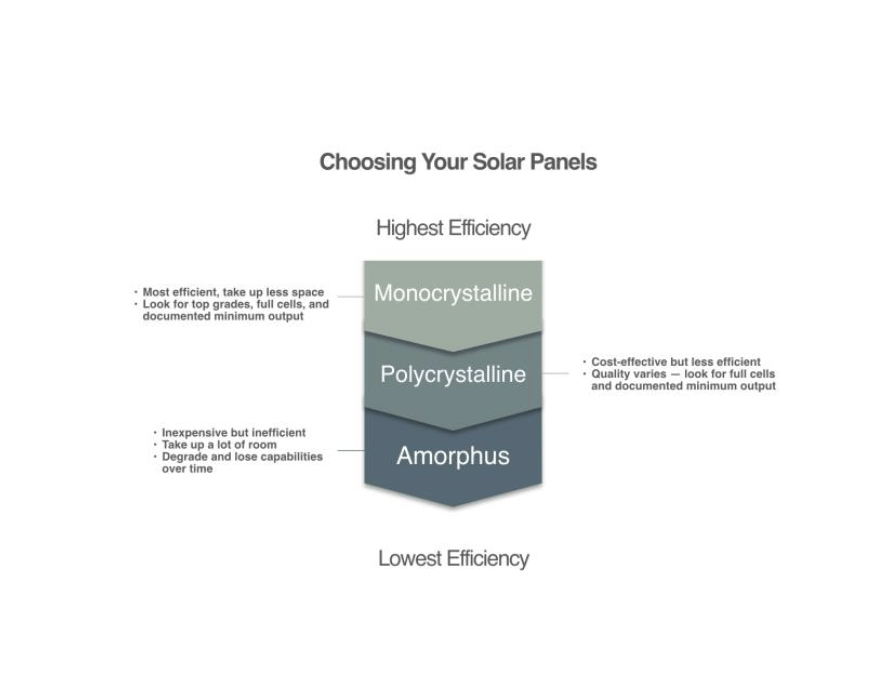
Rigid Versus Flexible Panels
Rigid solar panels, built using a frame surrounding tempered glass covering the solar cells, are the mos t common option for RVs. Flexible panels, in contrast, have the collecting material embedded into a thin mylar film affixed to an aluminum substrate.
Rigid panels are very durable and typically have longer warranty periods than flexible panels. While flexible versions may be up to 80 percent lighter, they are much more susceptible to damage. Flexible panels are usually reserved for specialty applications; for example, when panels need to be molded to curved surfaces or accommodate height or weight constraints.
Solar Panel Buying Tips
- Cheap solar panels are usually constructed with a lot of cut cells — they may be less expensive, but they’re also less efficient. Full, complete solar cells perform better and are worth the additional cost.
- Look for panels with the highest rated wattage for their size. A smaller footprint means a more efficient panel.
- Watch out for manufacturer claims of wattage output. The best manufacturers will provide a minimum output for their panels, as opposed to a maximum. Always ask your seller to document their panel output range (plus/minus percent).
Solar Panel Installation Tips
Panel placement. Solar panels should be located where th ey’ll receive the most light. Many operators will back into campsites, so they’ll receive more shade at the rear of the RV. Panels should also be mounted away from potential shade areas caused by the RV roof and air conditioning units.
Panel mounting. Rigid panels will come with sc rews and mounting brackets. After starting the screws, a self – leveling and sealing compound like Dicor can be inserted under each bracket to ensure a level install and a tight panel seal.
There are several ways to install flex panels. One of the most effective is by using 3M double – sided tape. Other installers opt for a silica flex adhesive, which also works well.
Panel wiring. Once the panels are mounted, you’ll need to run the panel wires down into the RV. If the RV is not solar – ready, one method is to feed the wires through the refrigerator roof vent. An alternative is to use a cable entry plate. The plate can be mounted anywhere o n the RV roof and provides greater flexibility no matter where the solar controller is installed.
RVs pr ewired for solar already have the cable entry plate pre – installed, which can dramatically reduce wiring time and complexity
Battery Basics
RVs use deep cycle, valve – regulated lead – acid (VRLA) batteries that can be regularly discharged and recharged. There are two common types of VRLA batteries — gel and absorbed glass mat (AGM) — with the latter being more popular. A third battery type — lithium – ion — is quickly gaining popularity in the RV community based on its efficiency, performance, and longevity.
Gel batteries are based on older technology. While they are sealed and do not spill, they charge more slowly than other battery types and require a compatible charge controller.
- An extended lifespan of up to ten years versus three years for traditional lead – acid batteries
- Weight savings of up to 65 percent
- Zero maintenance
- Safer to store. Lithium-ion batteries don’t vent potentially dangerous gases and can be stored in enclosed locations
- Greater discharge depth . Lithium-ion batteries can be discharged greater than 80 percent without ill effects
- Faster charging and better discharge efficiency. Lithium-ion batteries can be charged and discharged much faster than lead-acid batteries.
Battery Buying Tips
How many batteries will I need? Your battery requirements are based on the energy consumption of your RV. The more appliances you plan to run, the higher your consumpti on. RV batteries can also be wired together to form a ‘battery bank,’ providing either higher voltage (wired in series) or greater capacity (connected in parallel).
What type of batteries should I purchase? For mo st off – grid applications, high – quality AGM batteries strike an excellent balance between performance and price. As lithium – ion prices drop, they may offer a better alternative for demanding RV applications.
Heavier is usually better . With traditional AGM batteries, mor e lead equals more battery capacity.
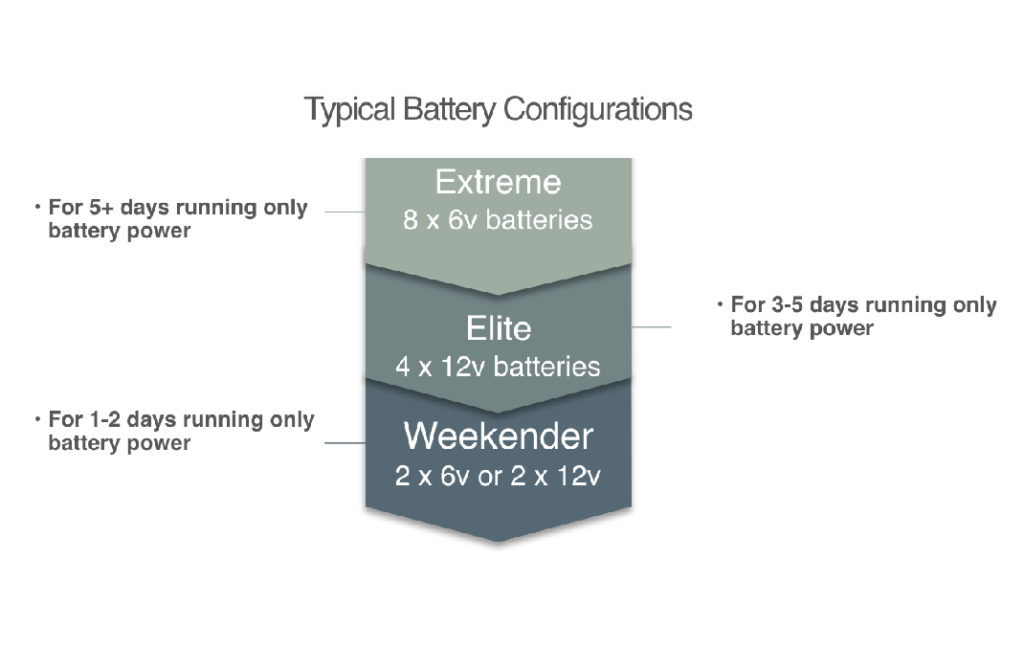
Troubleshooting Your Battery Installation
If your RV batteries aren’t providing an adequate charge, the first thing to c heck is the interconnect cables between each b attery. Often do – it – yourself installers will use thin, ten gauge wire for the interconnects. These cables should be a minimum of four gauge wire (and preferably two gauge). Sometimes batteries are not wired in the proper sequence. A new RV owner will often connect the batteries in series or parallel but run both positive and negative connecti ons off one battery. This will limit available power and not adequately charge all the batteries in the battery bank. Over time, this can result in irreparable damage to the RV batteries. When using multiple batteries, it’s important to have all the positives connected to one battery and all the negatives connected to the battery furthest f rom the first. In effect, this creates a single large battery with maximum available power and optimal charging capabilities.
Avoiding Battery Charging Pitfalls
Overcharging your RV batteries can result in severe water loss, plate corrosion, and eventual failure. Newer ‘3 – stage’ RV converter chargers help prevent battery gassing, water loss, and battery overcharging.
Undercharging can also cause significant issues. A simple way to reduce the impact of undercharging is to recharge your batteries often. For example, if you discharge your battery to 50% (then recharge), it will last up to twice as long compared to discharging it to 20%.
Adding a solar panel and a charge controller to your RV can help mitigate overcharging and undercharging issues. Solar power delivers a slow charge to your batteries — perfect for optimal performance and battery health. Conductin g routine maintenance and using a solar solution to frequently recharge your batteries can dramatically extend the life of your RV batteries.
Power Inverters — What You Need to Know
While RV batteries typically provide 12 volt DC power, many appliances RV operators require 120 volts AC (like in your home). Converting DC power to usable AC power is the primary role of the RV power inverter.
There are two types of inverters — mod ified sine wave and pure sine wave. Modified sine inverters, while more affordable, use a basic form of technology that supplies power in an erratic fashion, with more peaks and ebbs in the flow.
Pure sine inverters provide ‘clean’ power very similar to what you receive in your home from your utility provider. Many modern appliances (inc luding microwaves) and electronic devices are susceptible to power fluctuations and won’t operate optimally with power from a modified sine inverter. Opting for a pure sine inverter will ensure you always get the best performance and life expectancy from y our appliances and electronics.
Choosing an Inverter — Buying Tips
You should purcha se your i nverter from a company with a proven track record and reliable customer support. Your inverter should have a full range of safety certifications (such as CSA and UL) to ensure safe operation within your RV.
More elaborate converters also allow you to charge your batteries when you’re plugged into shore power or running a generator. Some even enable you to ‘pass through’ AC directly to your appliances when you’re plugged into shore power or to draw shore power and battery power at the same time.
Sizing Your Inverter
It’s important to properly size your inverter to ensure your appliances and devices run optimally. Appliances like microwaves and air conditions have ‘surge power’ requirements — up to 3x their rated power when starting up. You’re RV provider or your authorized solar dealer can help you determine the best inverter size for your requirements.
Inverter Installation and Operation Tips
Inverter location. You should install your power inverter as close as possible to the DC battery bank. This will minimize any power loss between the two.
Wire gauge. Larger capacity inverters require larger gauge wire connections to the battery bank. Small inverters (1,000 watts and under) can use four gauge wire, while a 3,000 – watt converter requires 0 gauge connectors. Using incorrectly – sized conn ectors will limit the available power and performance of your inverter.
Fuses. It’s critical to install a fuse for the inverter. This can prevent equipment damage or even a fire in the event of a short circuit or inverter failure. Fuses are sized according to inverter size — for ex ample, a 110 amp fuse for a 1,000 – watt inverter and a 400 amp fuse for a 3,000 – watt unit.
Charge Controllers — Getting the Most From Your Batteries
Charge controllers regulate the voltage and current coming from the solar panels to the battery, preserving battery life by preventing batteries from overcharging.
When RV batteries are low, the controller provides a full flow of current from the sol ar panels to replenish the battery banks. As the batteries achieve a 100% charge, the controller limits the current flowing from the solar panels to the batteries.
Pulse Width Modulated (PWM) controllers will shut off solar current when your battery is full and control the current flowing from the solar panels and battery for better ‘tric kle charging.’
More sophisticated Maximum Power Point Tracking (MPPT) controllers are up to 30% more efficient than PWM controllers and provide even more control. The high cost of MPPT controllers, however, remains prohibitive. A top – quality PWM controller is recommended for almost all RV applications.
Installing Your Solar Controller
Most solar kits come with 25 feet of positive (red) and negative (black) wire. These wires feed from the roof panels down into the RV and connect to the solar controller. Depending on the RV size and where you choose to mount the controller, you may need to add additional wire lengths.
Installing the controller on an RV prewired for solar is very straightforward. There will be a cable entry plate installed on the roof and existing wires running from the roof to the predetermined contr oller location. Inside the trailer, a decal indicates where to mount the controller, with the wires already in place behind it. Simply use the decal as a template, cut around it, and attach the wires.
All About Power Converters and Transfer Switches
Power converters.
In RV applications, the power converter (also known as a battery charger) takes AC power (typically from a generator or shore power) and converts it to DC power used to charge the RV batteries. The best converters provide high throughput and shorten battery charging times, reducing shore power charges and saving generator fuel.
Buying Tips
Converters are available in different amperage output ratings — usually from 20 to 100 amps. It’s important not to go too small — selec t a converter that meets both your current and potential future needs.
Many upgraded converters offer a mul ti – stage charging feature with an equalization mode for better charging and improved battery life. Some also incorporate temperature compensation circuitry to adjust charge rates based on temperature — a feature that also helps extend battery life.
When To Disable Your Power Conver ter
Once RV operators remove any external AC hookups (generator or shore power), they should also sh ut off the power converter. The simplest way is to turn off the converter breaker on the panel. Disabling the power converter eliminates any parasitic loop that may prematurely drain the battery bank. Once the operator reconnects AC power, they’ll also nee d to reconnect the power converter.
Transfer switches automatically switch between two incoming AC power sourc es — for example, from shore power and your inverter. Separating AC power sources is critical for your safety and the protection of your electrical equipment.
The biggest v ariable in choosing a transfer switch is your power consumption (watts and amps). Look for a high – quality automatic transfer switch that will accommodate your daily power requirements with room for growth.
6 WAYS TO IMPROVE THE PERFORMANCE OF YOUR RV SOLAR SYSTEM
Even with an efficient RV solar system, you can do several simple things to maximize your system’s overall performance an d power output.
Unplug cellphone chargers and power adaptors. These devices draw power even when not in use. Connecting all chargers and adaptors to a single power bar means you won’t need to unplug individual items to turn them off.
Use efficient lighting . Lights can drain considerable power from your battery bank. Replacing in candescent bulbs with high – efficiency LEDs can significantly reduce your power consumption. For example, you can run 25 equivalent 2 – watt LED bulbs for the same power consumption as a single 50 – watt incandescent bulb.
Install a central inverter switch. While some inverters incorporate pow er – save features, turning the inverter completely off when not in use is more efficient.
Use Propane For You r Refrigerator. Keeping your RV’s fridge cold takes a lot of power. A propane refrigerator will spare your batteries and reduce the load on your solar system.
Upgrade Your Personal Electronics. Newer electronics are generally more power – efficient than older models. For example, a netbook may consume 25 percent of the power of a full – sized laptop. It pays to read the specs of your devices and choose the most efficient models possible.
Consider Lithium Batteries. Lithium battery banks create a more fle xible system, improving power output and recharging speed while reducing weight.
Help From the Experts
A Go – Power Solar Deal er Can Make All the Difference

RV Solar Calculator for Off Grid Living
This RV solar calculator will help you correctly size your entire camper solar system. It includes your inverter, solar panels, solar charge controller and battery bank too.
It’s simple and straightforward to use. We’ve included a section below to answer some questions you may have.
This calculator forms part of our camper solar setup series and the wider subject of campervan electrics .
And it’s just one of our electrical calculators for RVs and campervan conversions too.
Calculating the minimum size of your RV solar system is a major step in finalising your electrical design.
Get this right and you can complete your DIY campervan conversion with confidence.
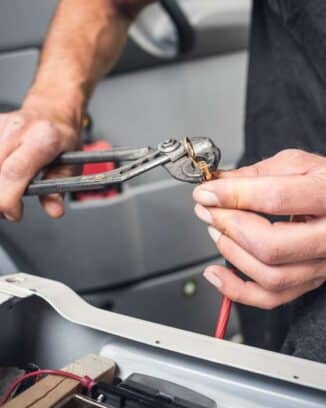
Need help & advice with your electrical setup?
Join Our Facebook Support Group
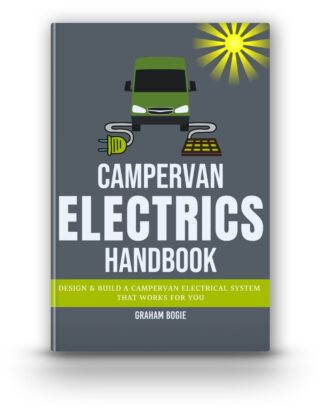
Everything you need to know about campervan electrics. Now available in ebook and paperback!
Learn how to design, size, install and troubleshoot your camper’s electrical system.
How do I use this solar battery bank calculator?
How do i know all the electrical devices i’ll use, i won’t use every appliance everyday. what should i do, how do i find the watts of each device, how do i know my appliance is ac or dc, i have more than 5 devices. what shall i do, i have more than 25 devices. what shall i do, why is the calculated watts bigger for ac, i already know my total load in watt hours. can i still use the calculator to size battery, how much contingency do i need, what is the difference between gel, agm, fla and lithium batteries, how much battery should i install, what peak sun hours should i select, what is the difference between a pwm and mppt charge controller, what solar charge controller should i install.
- Do I need an inverter?
The inverter size calculated is smaller than I expected. Why?
What do i do next.
- Enter every electrical device and component you’ll power form your camper batteries
- Enter the watts each device uses
- Enter the maximum number of hours each day you’ll use the device
- Select whether each device is DC or AC
- Enter the amount of contingency you want to add to the total usage
- Select the battery type you will install
- Select the minimum expected peak sun hours
- Select the type of solar charge controller
The RV solar calculator provides the minimum size solar components needed based on the information entered.
Getting a complete list of electrical appliances, devices and components you’ll use in your RV is the most critical part of sizing the electrical system .
Underestimate it and you may run out of power.
Overestimate and you’ll probably spend more money and make your setup more complex than necessary.
Work through your typical day, considering all the appliances you’ll use along the way.
Don’t forget any gas or diesel appliances that need power to start them up.
The aim of the calculation to size your camper electrical setup so you have enough power every day.
With this in mind, it’s important to consider your most heavy usage day.
Maybe you intend to live in your camper during the winter .
Your heating will run for longer and probably your ventilation fan too (it’s the best way to stop condensation ).
You may be living indoors much more and with fewer hours of daylight than during the summer months. All this adds up to greater energy demands.
Think it through carefully. It’s not going to be 100% accurate but you can get close enough.
The watts of most devices can be found either printed on the device, in the operating manual or the manufacturer’s website online.
Sometimes, products list the power usage in current (i.e. amps). In this case, use the wattage calculator at the top of the solar calculator above to convert the current and volts to watts.
The way the power is stated on devices isn’t standard. Look out for things like:
- Power: 12V/2.5A
- Voltage: 12v Wattage: 25w
- Amp Draw 12V/DC: 4.2
For some devices, in particular those with battery charging adaptors like camera batteries and laptops, use the input values specified not the output values.
If you can’t find the power of the device easily, a watt meter is a low cost tool to help you get an accurate reading.
Simply plug the meter into your household socket, plug the device into the meter and switch on the device.
The read out display will give you the watts used. Make sure the device is operational for the maximum reading.
The labels or specification of most appliances state whether it is AC or DC.
Failing that, if it has plug you can use in your home sockets, it is probably an AC appliance.
For calculation purposes, if in any doubt, assume it is AC as this produces a higher number so errs on the side on caution.
If you have more than 5 devices to list follow these steps:
- Enter the 1st 5 devices
- Press the “add more devices” button
- A further 5 rows are displayed for your to add more devices and another “add more devices” button after each set
You can add upto 25 devices in total.
If you have more than 25 devices to list follow these steps:
- Split the appliances between AC and DC
- Enter the 1st 25 DC appliances
- Change the contingency value to 0%
- Make a note of the Daily Power Usage figure
- Refresh the page in your browser to reset the calculator
- Enter the 1st 25 AC appliances but enter them as DC
- Watts = Wh you noted down
- DC or AC = DC
- DC or AC = AC
- Add your additional devices
AC appliances need AC power but camper batteries produce DC power.
The DC power is converted via the inverter to AC power but there is a cost of this conversion. As such, AC appliances use a greater power factor in the solar battery bank calculator.
If you already know your total load in watt hours, enter 1 device with the total watt hours in the watt field, 1 hour and list it as DC.
If you list it as AC, the calculator will increase the watt hours further and size an inverter too.
How much contingency you want to include is completely upto you.
We’ve always used about 20% and it has served us well.
If you don’t rely on your electrical system, consider reducing it a little.
If unsure of your power use or appliances, consider increasing the contingency – you’ll never complain about having too much battery.
You can deduct contingency too by using a negative number. The calculator will warn you the value should be a positive number but will calculate accordingly.
Battery technology varies widely and advancements are being made all the time.
Currently, the most commonly installed batteries are Gel, AGM or Lithium. FLA use dated technology and we recommend steering clear of them.
Lithium batteries are significantly more efficient than Gel or AGMs so can be discharged to a much lower level.
This explains why you need a smaller Lithium battery than either AGMs or Gels.
But this doesn’t mean a lithium battery is always the best option.
To assess which battery is most cost effective and best suits your needs, use our battery comparison calculator .
More information, read our detailed post on campervan batteries .
The calculator states the minimum size solar battery bank you need to provide the load you’ve indicated.
However, if you only install that amount of battery, you must have the ability to fully recharge them every day.
Otherwise, you’ll discharge your batteries faster than you can top them up and end up with flat batteries pretty soon.
If you have a reliable source of recharging, like a hook up facility to shore power , you may not need any extra battery.
But if living off grid and rely on charging the leisure batteries from solar panels or the alternator, you may need to consider increasing the amount of battery.
Whatever you decide, there is no point installing a battery bank greater than you can reasonably expect to charge.
The amount of sun falling on your solar panels affects how much energy they can harvest.
Because the sun’s position in the sky varies throughout the year, the amount of energy they can harvest also varies.
Use our peak sun hours calculator for each area you plan to travel.
Use the lowest number of all the locations you will travel to.
The main differences between a PWM and MPPT charge controllers is price and efficiency ratings.
A PWM controller is low cost but even when performing at its peak, isn’t especially efficient.
If you want (or need) a solar charge controller to squeeze as much juice out of the wattage on the panels, a highly efficient MPPT controller is the way to go.
You can read more about the differences between PWM and MPPT charge controllers in this post .
A solar charge controller should be sized for the size and configuration of your solar array.
The calculator above provides the minimum size needed.
When you know what solar panels you’ll install, use our solar charge controller calculator to find the right size and model for your set up.
Do I need an Inverter?
You only need an inverter if you want to use AC appliances powered by your deep cycle battery.
If you use AC appliances only when hooked up and have AC sockets on the mains circuit, you don’t need an inverter.
Check out our detailed article on campervan inverters for more info.
Running AC appliances on a solar system demands a lot of energy from the batteries.
Keeping the number of AC appliances to a minimum will help keep the size of the system down.
We’ve calculated the inverter size to run only your largest AC appliance with no other AC appliances running at the same time.
If you already have a larger inverter, use that but keep your maximum load as low as possible or you’ll drain the batteries fast.
For more information and to understand the implications of a large inverter on your solar system, check out our inverter calculator .
So now you have an idea of the kind of size solar system your expected load needs what are the next steps?
Step 1 – Cut back on electricity use
If this is your first attempt at sizing your camper solar setup, you may find the result is a pretty big system.
Living in a van isn’t the same as living in a house. We need to be more frugal with our resources.
The first thing to do is check you have enough space on the RV roof for all the solar panels.
If not, or the system is much bigger than you expected, it’s time to reassess you energy needs.
Try swapping out AC appliances for DC alternatives, look for less powerful devices and replace electric devices for non electrical versions.
Re-run the calculations above for revised sizing.
Step 2 – Draw up a Solar Panel Wiring Diagram
Drawing out a wiring diagram will help identify the components you need to install it.
Check out our solar panel wiring diagrams (for free). Choose the size closest to your solar panel set up. Each has a complete list of the components needed.
Step 3 – Select the Solar Panels
Choose your solar panels.
There’s a number of different types and you can read more about them in our camper solar panels post.
Once you’ve selected the type of panel, measure the available space on the roof so you know what sizes to buy.
Check the technical spec of the panels before you move onto the next step.
Step 4 – Decide if you’ll wire the panels in series or parallel
A solar array wired in parallel produces a much higher current than when wired in series .
When wired in series, the solar array produces much higher voltages.
Each of the scenarios have their advantages and disadvantages, especially when installed in a campervan for off-grid living.
You can read more about wiring solar panels in series and parallel here .
Step 5 – Select a Solar Charge Controller
Now you know the exact solar panels you’ll use and how you’ll wire them, you can accurately size the solar charge controller .
Our Solar Charge Controller Calculator will provide you with the right size and recommended controller too.
Step 6 – Choose the Battery Type
Deep cycle leisure batteries come in a number of technologies – Lithium, AGM and Gel. You can read more about the pros and cons in our post on campervan batteries .
While Lithium are the latest most efficient, they’re also the most expensive. In fact, if you only intend to own your camper for a couple of years, they’re not the most cost effective either.
If you want to compare batteries to help find the most cost effective for your setup, use our battery life calculator before you buy.
Step 7 – Install your Solar System
Follow our step by step guide on how to install solar panels on RVs and campers and you’ll be living off grid in no time.
Graham Bogie

Graham is a seasoned marine electrical engineer with two decades of experience designing customized electrical systems for plant machinery and converting campers and overland vehicles. His expertise has led him to author the reputable Campervan Electrics Handbook and become the chief designer of the RV Wiring Design Tool . As a knowledgeable figure in the field, his YouTube channel , blog, Facebook group , and newsletter, offering electrical advice and product reviews, reach more than a million users each year.
3 thoughts on “RV Solar Calculator for Off Grid Living”
Hi folks, I’m renovating/redesigning the interior of my 96 Thor Pinnacle camper from scratch. I’m using lightweight materials, multi-purpose furniture like a Murphy bed/desk. Designed a circulating shower. I’m installing energy-efficient appliances. No propane a normal household mini fridge and freezer, infrared floor heating, no furnace. Induction cooking … I made a rough calculation (can’t upload a pic or pdf)and I need about 21 kwh 300 Amps to power all this. I’m planning to install 6 x 200w flexible mono ETFE solar panels and 3 200Ah LiFePO4 Lithium Batteries. I know that the lifespan of flexible solar panels is not that great but cutting the weight is something that I consider. I’m planning to travel from May till September around the Mediterranean. So my question is, is my solar setup enough or overkill ?
Hi, unless I’m mistaken there is a flaw in your calcs for the power. If I select a 2000w DC item for .5 hr per day I get an Inverter of 1200w.
When I change this to run for 1 hour per day get an Inverter of 2400w.
When I change this to run for 2 hour per day get an Inverter of 4800w.
I understand that I will need more battery, and solar, but simply running a device that uses a constant power draw does not change the size of the inverter? Or do I miss the point? Cheers
Hi Colin – The inverter size shouldn’t change regardless of how long you use the device. Can you please double check your entries again? Please make sure you’ve selected AC for the device. I can’t replicate the problem you’ve described. If you still see the issue when you re-enter the numbers, it’d be super helpful if you could send us a a screen shot so we can investigate further. Thx
Leave a Comment Cancel reply
Save my name, email, and website in this browser for the next time I comment.
Related Posts

Peak Sun Hours Calculator by Zip Code, Address & City
November 23, 2023
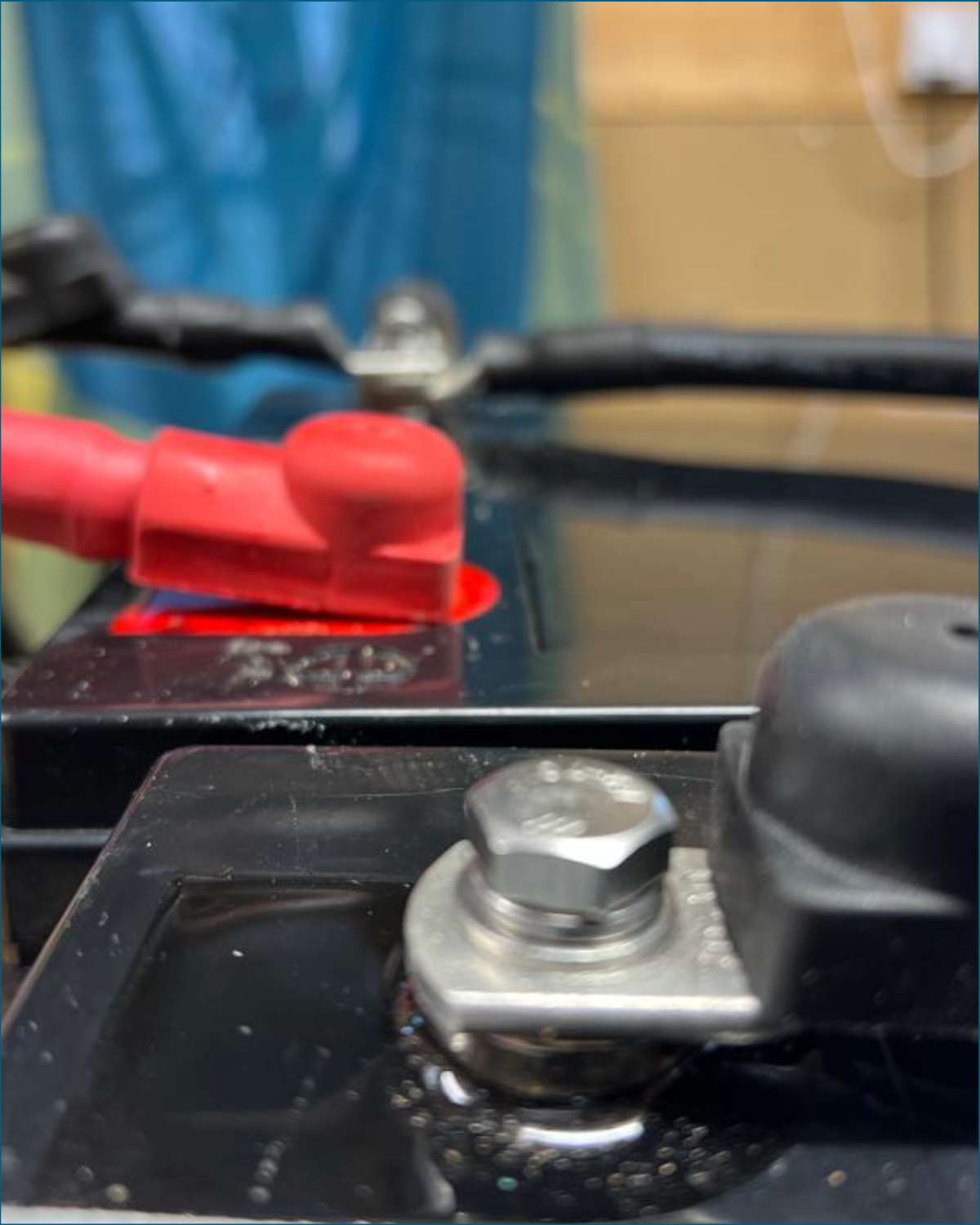
Why is My RV Battery Not Charging: Troubleshooting Guide
October 9, 2023

© 2024 mowgli adventures
Privacy Policy | Terms Of Service | Sitemap
Part of Mowgli Adventures Media Ltd. Registered in England and Wales. Company Number 13558893

The best of EcoWatch right in your inbox. Sign up for our email newsletter!
- About EcoWatch
- Contact EcoWatch
- Terms of Use
- Privacy Policy
- Learn About Solar Energy
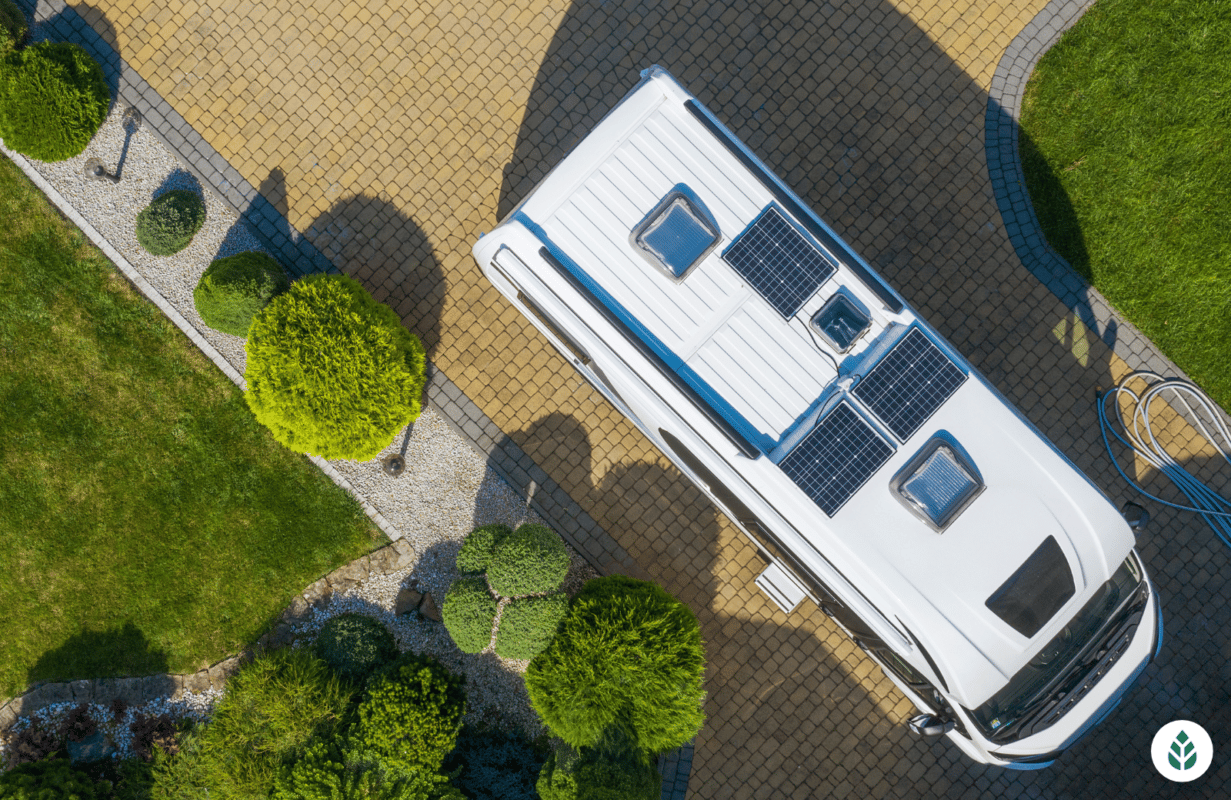
10 Best Solar Panels for RVs (2024 Portable Solar Options)
Tired of your noisy generator? Read this article to learn how solar can boost your RVing experience:
- Which solar panels are best for RVs
- Why use solar panels for your RV
- How to choose an RV solar panel
Each product and or company featured here has been independently selected by the writer. You can learn more about our review methodology here. If you make a purchase using the links included, we may earn commission.
Portable RV Solar Panels Are Increasingly More Popular to Live Off-Grid
As more and more people opt to leave the sedentary life and turn to a nomadic lifestyle, interest in solar panels for RVs and mobile homes have continued to rise. Whether it is for a shorter roadtrip or a new lifestyle, staying connected while in your RV has become increasingly important. No longer having to rely on rest stops or g as generators to power your home on wheels; a better option is to embrace the clean, renewable energy of the sun — Invest in solar panels to keep everything in your RV humming along.
Living off the grid and harnessing the energy of the sun, how much more do we need to say? A good RV camper offers the serenity of nature along with the basic comforts and conveniences of the modern world. To make your travels more eco-worthy, investing in one of the best solar panels for RV use is an obvious answer to staying connected “off-the grid”. The portable solar panel offering has improved since they first came out, now portable solar panels are easier to come by, at more affordable rates and produce more energy than when they initially were developed. Allowing you to choose the best potable solar panel for your RV.
We’ve compiled our top list of Solar Panels to keep you on the go so that you don’t have to worry about if you’ll have energy or not. Where the sun goes, your solar power will go too!

Blue Raven Solar

Regional Service
EcoWatch rating
Average cost
- Industry-leading in-house financing
- Competitive pricing
- Excellent reputation
- Doesn't offer solar batteries (coming 2022)
Our Top 10 Solar Panels for RVs and Campervans
There are so many RV solar systems available, which is why many RVers and van-lifers find it hard to choose the right kit to suit their needs. In the table below, we’ve laid out our hand-selected best RV solar panels for every genre of glamping.
Best Overall: Renogy 400W 12-Volt Monocrystalline Solar RV Kit
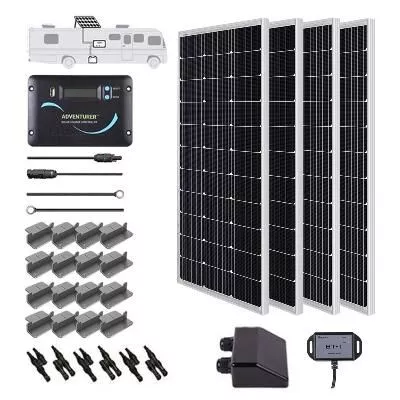
Quick Facts :
- 100W/12V solar panels
- Up to 22% efficiency
- 25-year warranty
- Industry-leading efficiency
- Generous 25-year warranty
- Easy and customizable DIY installation
- Includes 30-amp PWM charge controller
- Includes mounting equipment
- A large solar system that may not be suitable for all motorhomes
The Renogy 400W solar RV kit is our top choice for the all-around best solar panel for RV and campervan use. This solar power kit comes with four 100-watt panels that are not only high efficiency but are durable. Renogy is a leader in the portable solar panel industry and offers a 25-year warranty to back up its quality panels.
Something else to note is that the kit comes with all of the mounting brackets and solar cables you need to install the panels on your RV’s roof. Renogy also offers easy app integration that allows you to control your solar energy panels from your phone or tablet.
Best Basic Kit: WindyNation 100W Solar Panel Off-Grid RV Kit
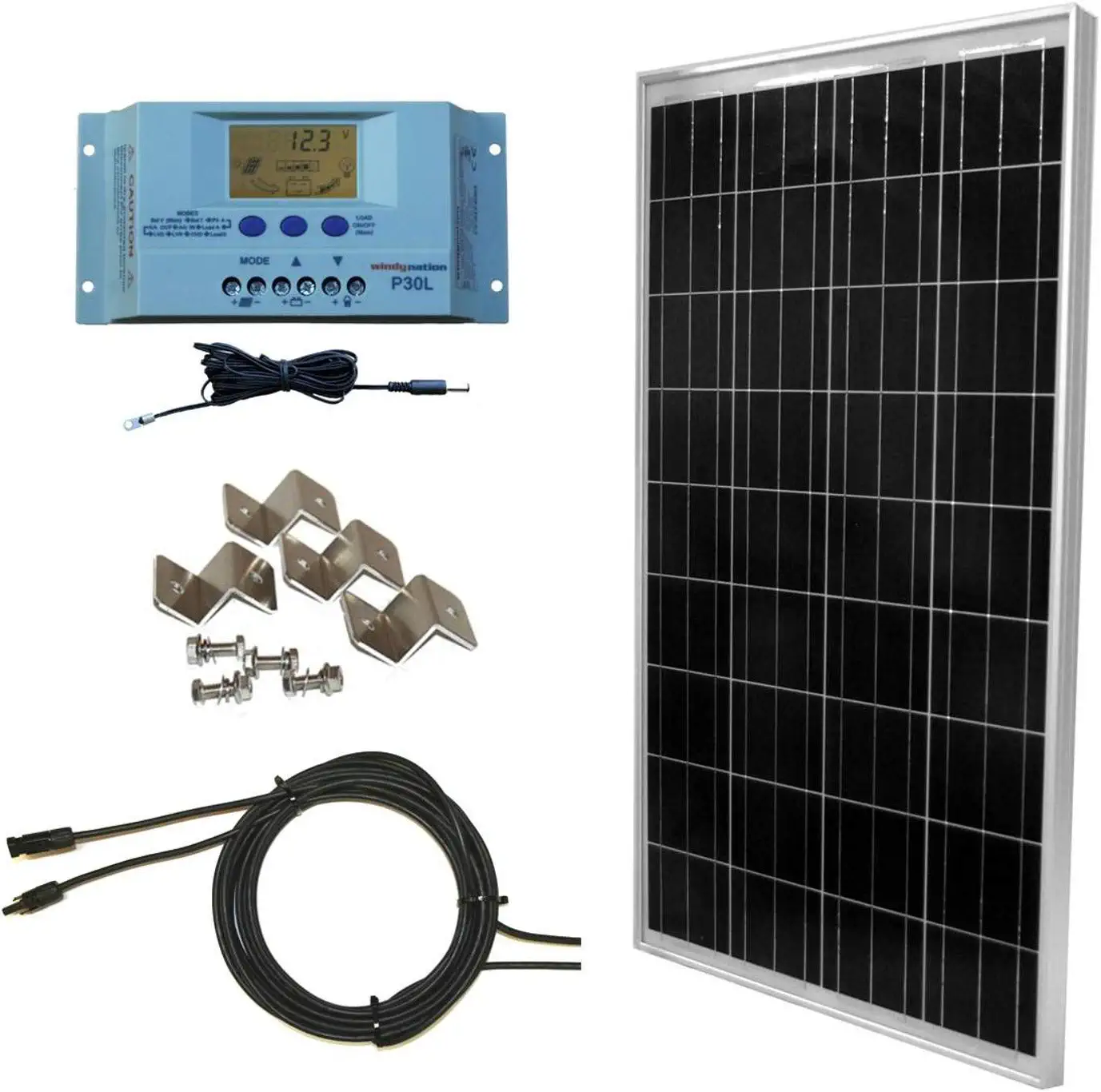
- 100W solar panels
- Undisclosed efficiency rating
- Five-year warranty
- Competitive price point
- Easily expandable for adding additional panels
- Includes mounting brackets
- Includes 30-amp charge controller
- May not offer enough solar power for all RV campers
- The inverter must be purchased separately
- Shorter warranty
This WindyNation 100W solar panel is the perfect choice for RV campers and van-lifers who are new to solar energy. The 30A PWM controller and panel kit is rated to provide, on average, 350 watt-hours or 33 amp hours of charge each day. This should be enough energy to power most of your appliances.
WindyNation’s solar panels are less expensive than other competitive panels, but they do tend to generate less electrical power. However, if you don’t need a ton of energy, this single solar panel system should more than accommodate your needs.
Best Flexible Panel: Renogy 100-Watt 12-Volt Flexible Monocrystalline Solar Panel
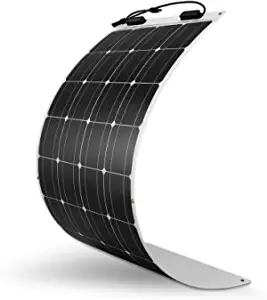
- 100W/12V solar panel
- 25-year performance warranty
- Highly efficient
- Flexibility for uneven surfaces
- Low profile
- 95% thinner than traditional solar panels
- Inverter, battery bank, and charger are sold separately
- Not enough to power the entire RV setup
Few flexible panels can compare to Renogy’s 100W monocrystalline panel . This flexible solar panel is ideal for uneven and curvy surfaces, such as the hood of your campervan. Despite its thinness, the panel itself is known for its durability and ability to withstand high winds and heavy snow loads.
Renogy’s flexible panel may not be able to power an RV on its own, but it can be combined with several panels to provide enough energy to run all your appliances. This panel is sold on its own, so you’ll need to purchase the rest of your solar kit separately.
Best Portable Solar Panel Kit: Goal Zero Nomad 100-Watt Monocrystalline Portable Solar Panel
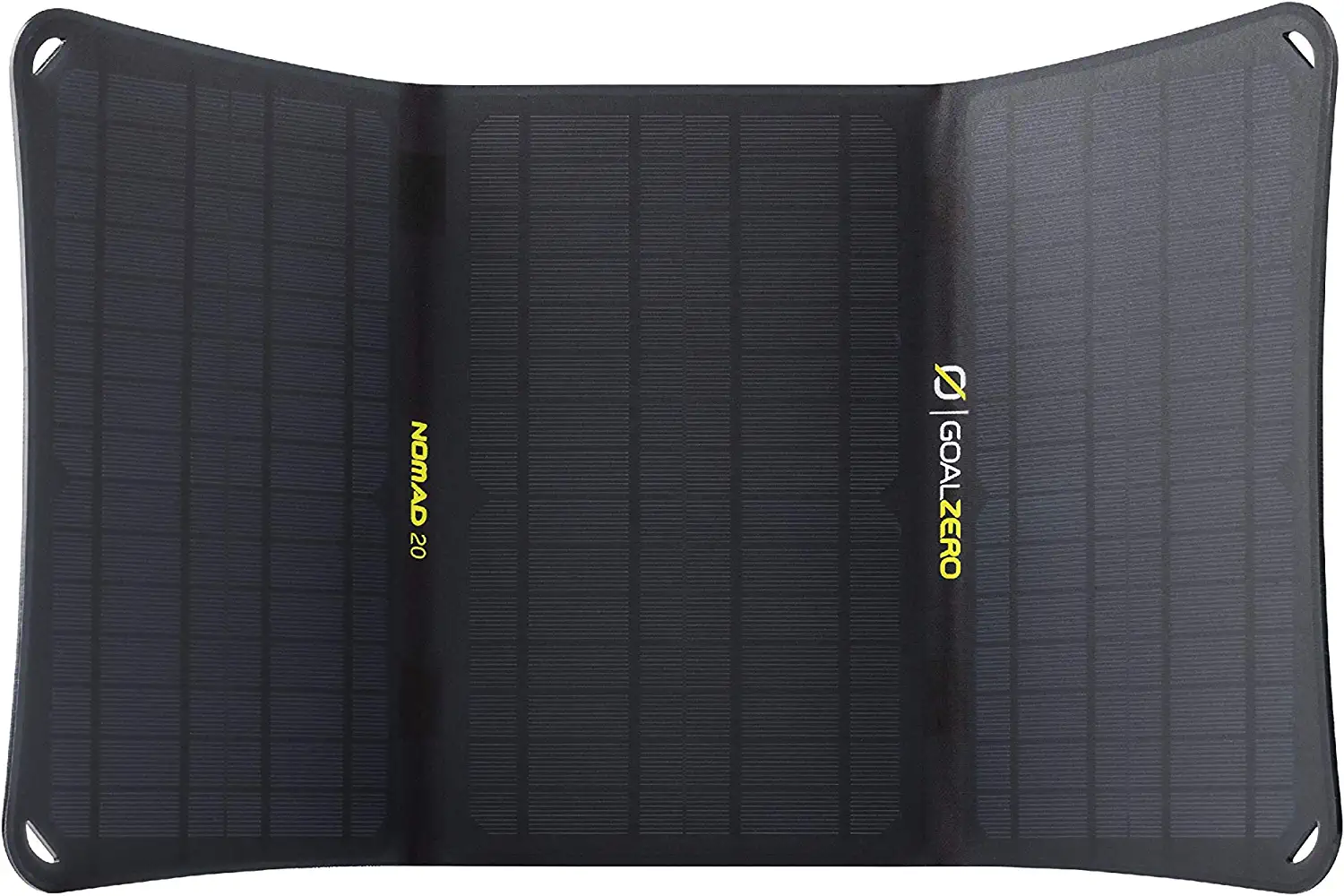
- 10-watt, 20-watt, 50-watt, 100-watt, and 200-watt options
- High-efficiency rating
- One-year manufacturer warranty
- Built-in carrying case for easy transport
- Easy to chain several panels
- Ultra-lightweight design
- Unclear efficiency information
- Short warranty period
- Battery, charger, and inverter not included
- I May need an adapter for some mobile devices
The Goal Zero Nomad lives up to its nomadic name because you can place it on the ground with its built-in kickstand, attach it to your kayak to absorb maximum sunlight, or even clasp it to your backpack for on-the-go power.
The solar kits with lower wattage include a USB adapter and are best used as a power source for phones, power banks, battery chargers, headlamps and lanterns, but the larger modules can be used to power more advanced equipment. Lithium batteries are required but are sold separately.
Best Kit for Beginners: Renogy 100-Watt 12-Volt Monocrystalline Solar Starter Kit
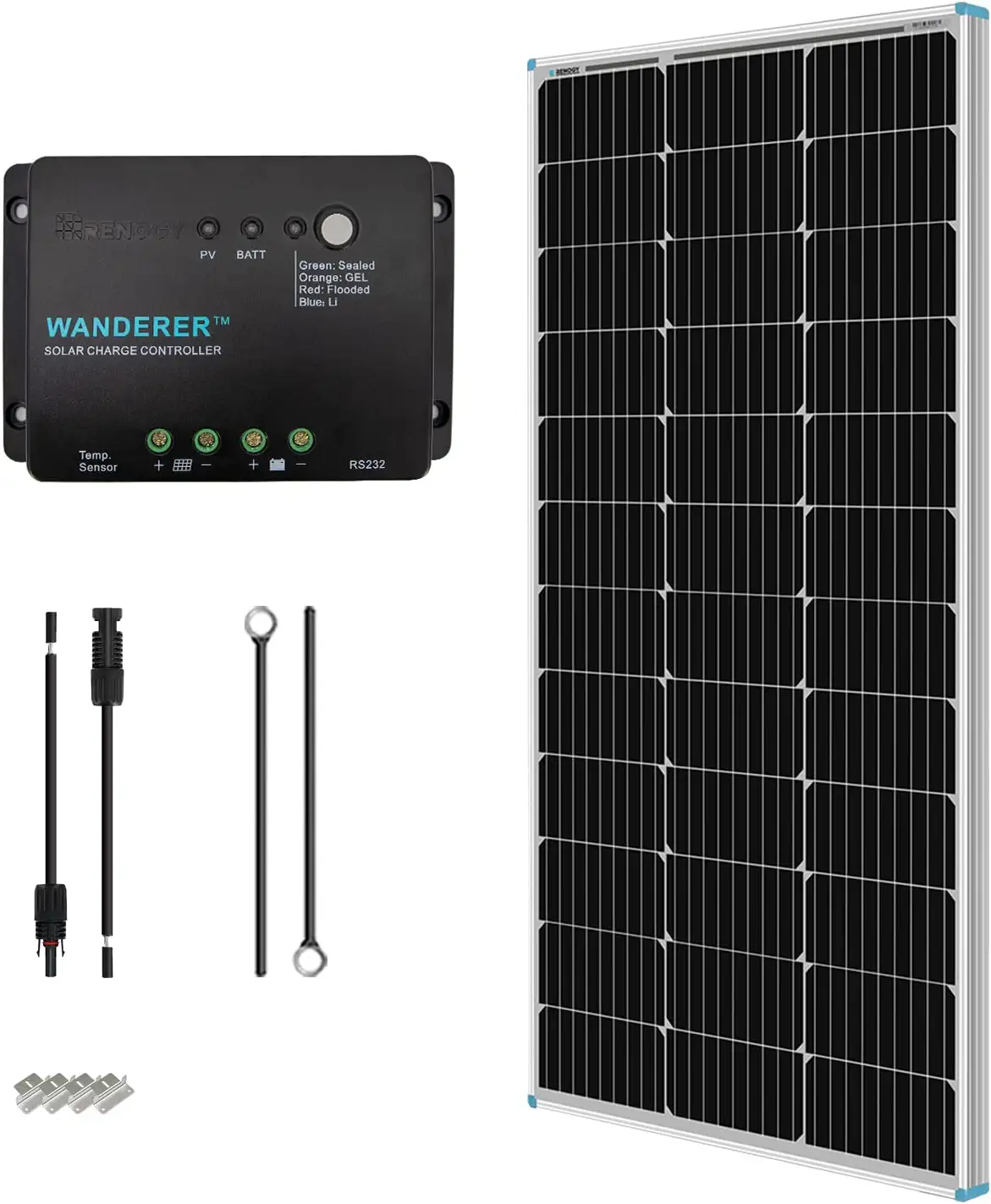
- 100W/12V solar panels
- Up to 21% efficiency
- Easy DIY installation
- Fixed solar panel for van roof
- Not enough to power a full-size RV
Complete with an adaptor kit, charge controller, tray cables, and Z-brackets, the Renogy 100-watt starter kit is the perfect affordable setup for the novice solar enthusiast. Built with a durable aluminum frame, this high-quality panel can withstand high winds and heavy snow.
This single-panel kit will not have enough power for your entire RV, but it is a good starter kit for supplying partial solar power. It can also easily connect to additional solar panels, so you can upgrade your system as needed.
Best Weatherproof Kit: Renogy 100W Monocrystalline Off-Grid Portable Foldable Kit
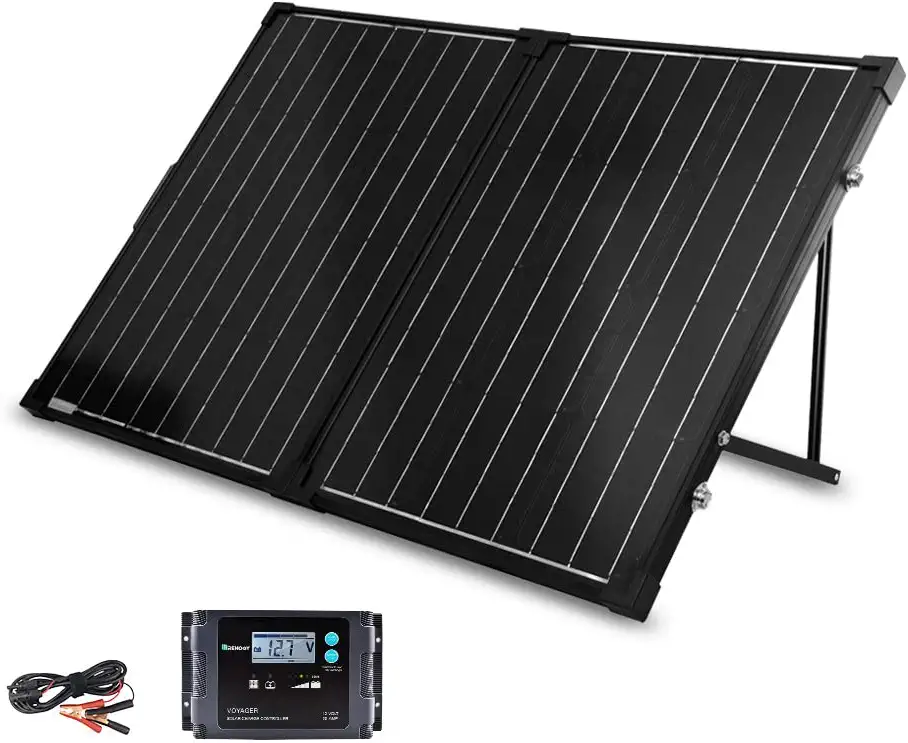
- 100W/12V monocrystalline solar panels
- Up to 18% efficiency
- Includes MPPT solar charge controller
- Easy to install
- High portability
- Lightweight design
- System expansion available
- Excellent customer support
- Lower efficiency rating
- Will not be able to power an entire RV
When you’re RV camping, severe weather is practically inevitable. Renogy’s portable and foldable 100W off-grid kit is waterproof and built to withstand even the harshest of weather.
The kit also comes with a heavy-duty protective case and safety guarantee for your charge controller and batteries. This portable solar panel is easy to set up and can be added to your existing solar system.
Best for Full-Time RVers: EF ECOFLOW DELTA Mini Solar Generator and 2 110W Solar Panels
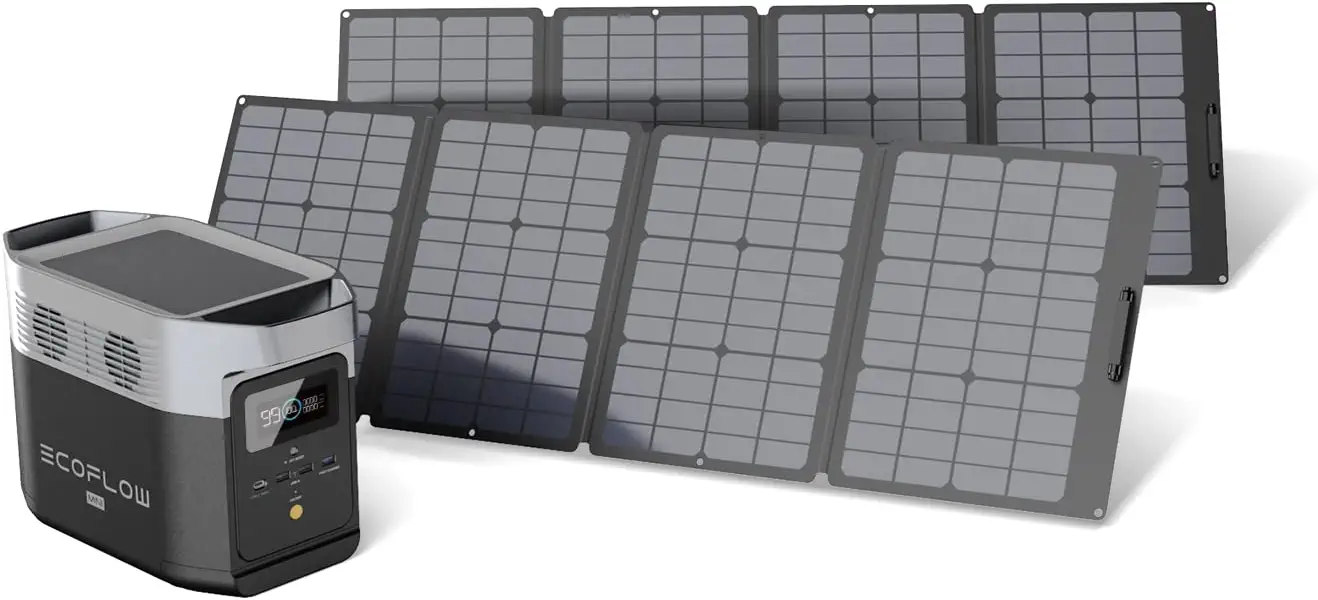
- 110W/120V solar panels
- 882 Wh capacity
- Two-year warranty
- High efficiency
- Full system to power your appliances
- Two solar panels, solar generator, DC cable, AC charging cable, car charging cable, and solar panel carrying case included
- Expensive price point
- Shorter warranty period
- Battery banks are sold separately
Available on Amazon, EF ECOFLOW’s panel system is perfect for RVers who make it to a campground and stay awhile. Whether you need to charge your phones, plug in your air conditioner, or power your mini fridge, this solar panel system has got you covered.
Although it’s on the expensive side, the kit comes with a powerful generator and high-efficiency solar panels. There’s no need to worry about mounting hardware because these panels are portable and meant to be set up on the ground.
Best Compact Panel: 100W 12V Poly Solar Panel
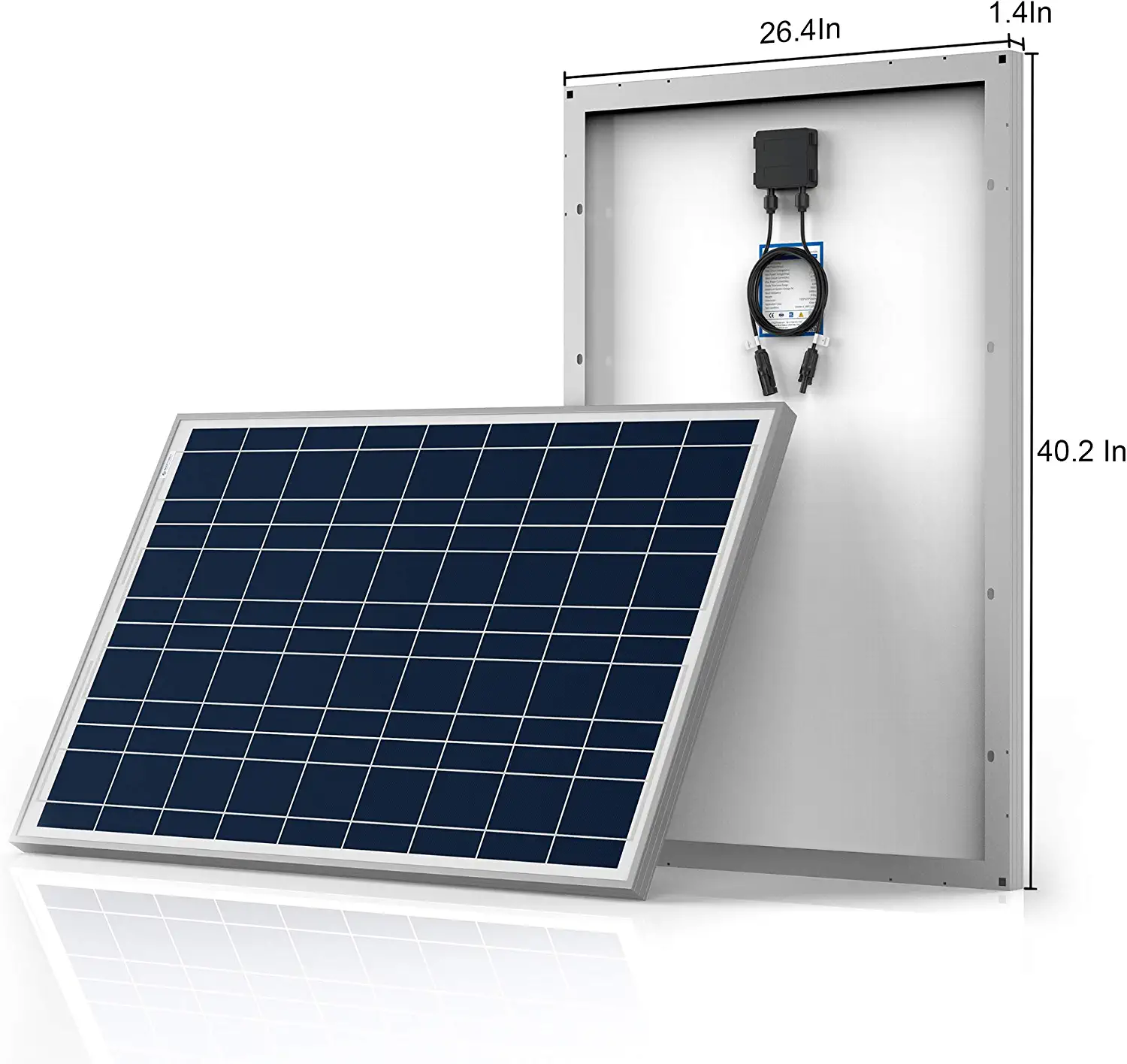
- High efficiency
- Lowest price point
- Made with corrosion-resistant aluminum
- Weather-resistant
- Not enough to power the entire RV battery and setup
- Battery, solar inverter, and charger are sold separately
- Efficiency rating is unclear
Poly Solar’s 100W solar panel is the most affordable on our list and its compact design makes it great for campervans and RVs alike. To combat low-light conditions, Poly Solar’s bypass diodes minimize the power drop caused by excess shade. This helps your solar panel operate effectively on cloudier days .
The IP-65-rated junction box and aluminum frame ensure that this panel is built to survive harsh weather conditions. With pre-drilled holes and a lightweight design, these panels are super easy to install on your RV, boat, caravan or off-grid system.
Best Foldable Panel: ROCKPALS SP003 100W Portable Panel
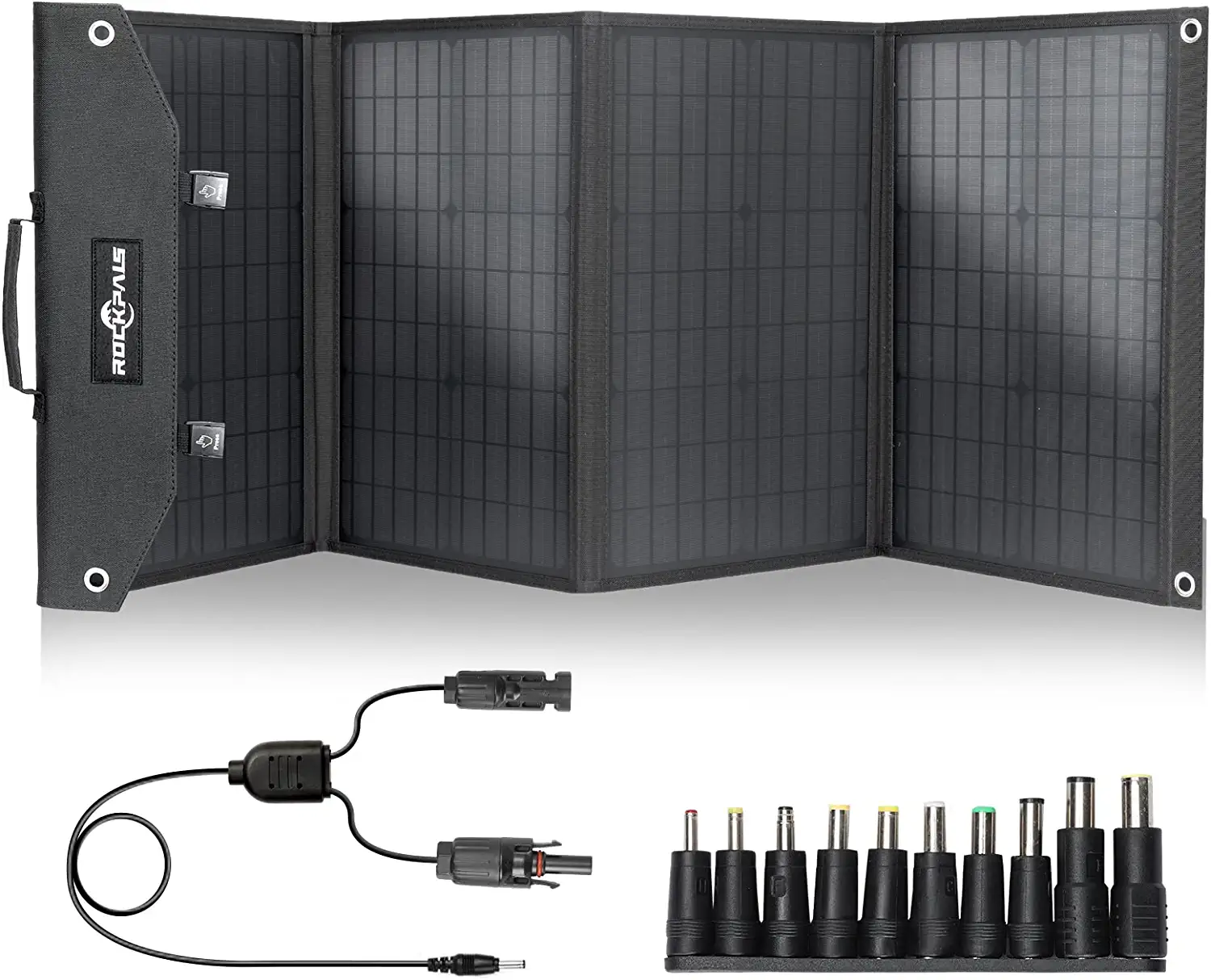
- 100W solar panel
- Up to 23% efficiency
- 12-18 month warranty
- Portable and lightweight
- Excellent power output
- MC4 connector for optimal power
- Great for off-grid applications
- Not enough to power an entire RV setup
The ROCKPALS 100W portable solar panel is designed with portability in mind. As a lightweight foldable solar panel, this kit can easily be stowed away in your campervan or RV. Specifically for powering generators, this panel comes with more than ten different adapters.
If you do decide to purchase this solar panel for your RV camper, you will likely need more than one, and you will have to purchase the solar generator separately. The warranty period may be short, but the panel does come with a lifetime customer service guarantee.
Best Value Kit: DOKIO 110w 18v Portable Foldable Solar Panel Kit
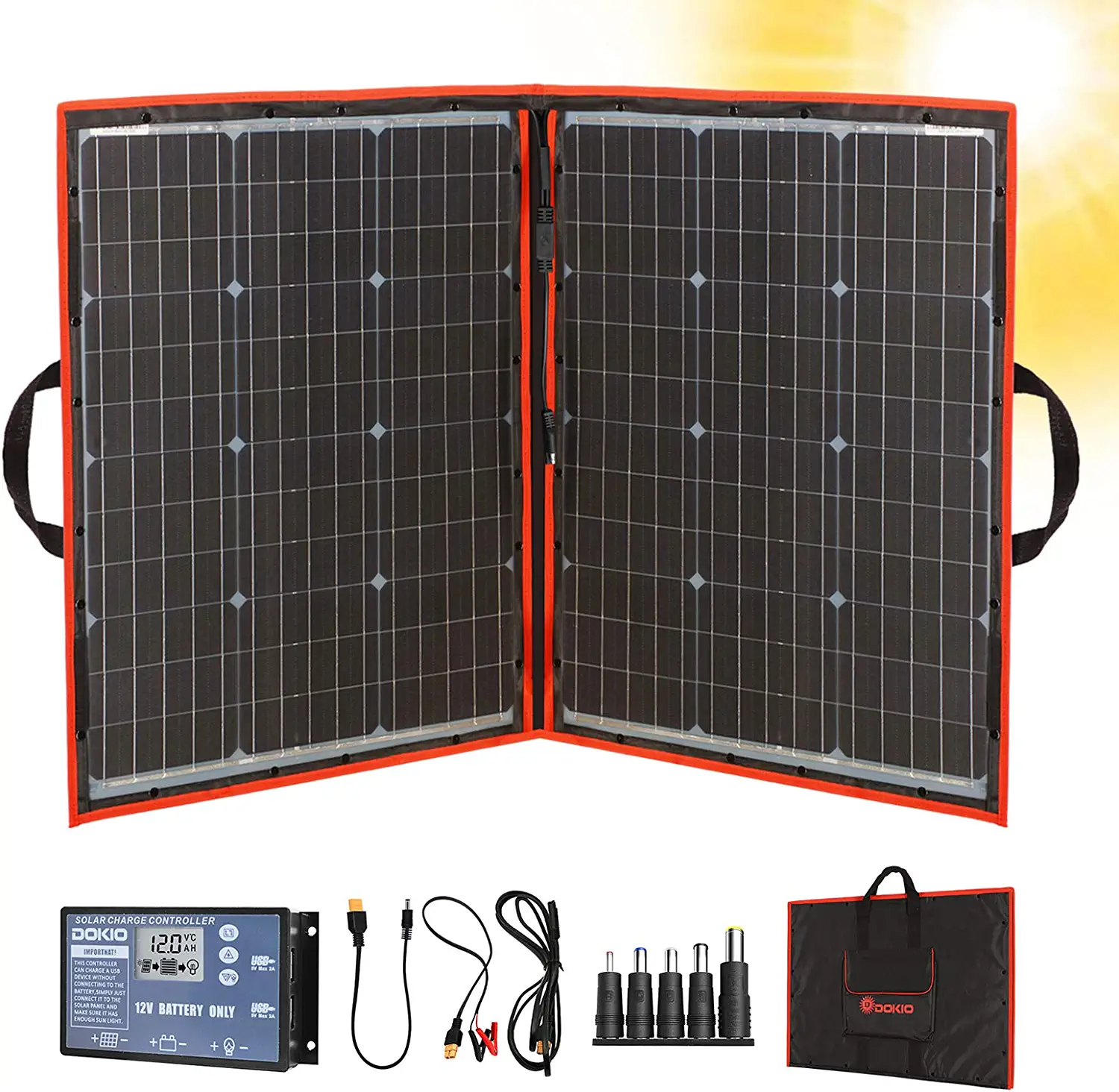
- 110W/18V solar panel
- 30-day money-back guarantee
- One-year warranty
- Portable and lightweight design
- Ideal to power 12V batteries and power stations
- Great campervan solar panels
- Includes 10-amp charge controller, conversion adapters and mounting equipment
- AGM battery sold separately
The DOKIO 110w 18v Portable Foldable Solar Panel Kit is great for RVers on a budget. Designed for battery charging, this complete kit can deliver enough amperage to your RV battery, marine battery, or off-grid setup. The kit comes with several different connectors to easily attach to any 12-volt battery.
What sets DOKIO apart from other panels on the market is its safety rating. DOKIO’s solar panel kit includes overcharging protection, overcurrent protection, ISO certification, and more. The panels are also durable and come with their own carrying case.
How Do RV Solar Panels Work?
As you shop for the best solar panels for your RV, it may be helpful to know how solar panels actually work .
Generally speaking, a solar power system for an RV works like a typical residential solar system. The panels draw energy from the sun and an inverter turns it into an electrical current, which is then distributed throughout your RV’s electrical system.
Solar energy can be converted and used in real-time, but a battery can make your solar harnessing worthwhile. A battery may be used to store any excess power that’s generated by the solar cells so that you can still power your system on low-light days or at night.
Do You Need Solar Panels for an RV or Campervan?
When it comes to RV camping and van-living, there are typically two major “camps,” if you will — the campground electrical hook-up-ers and the off-grid adventurers. Naturally, both can benefit from using solar power, but the need looks a bit different for each.
If your ideal RV trip is to a campground with an electrical outlet, then you don’t necessarily need solar energy for your camper. But if you would rather take an eco-friendly approach to camp, then an RV solar panel kit is the way to go. Plus, you won’t be out of luck if you get to your favorite campsite only to find that all the electrical hookups are taken.
Whereas those who frequent the campgrounds often have access to electricity, our boondocking folks take a more rugged approach by living off the land or whatever they can fit in their van. That means limited or no access to electrical hookups.
Our off-grid RVers or van-lifers will likely get more out of a solar panel system because it could be used as their only energy source. Instead of relying solely on batteries and propane to power their equipment, off-grid folks can use solar energy.
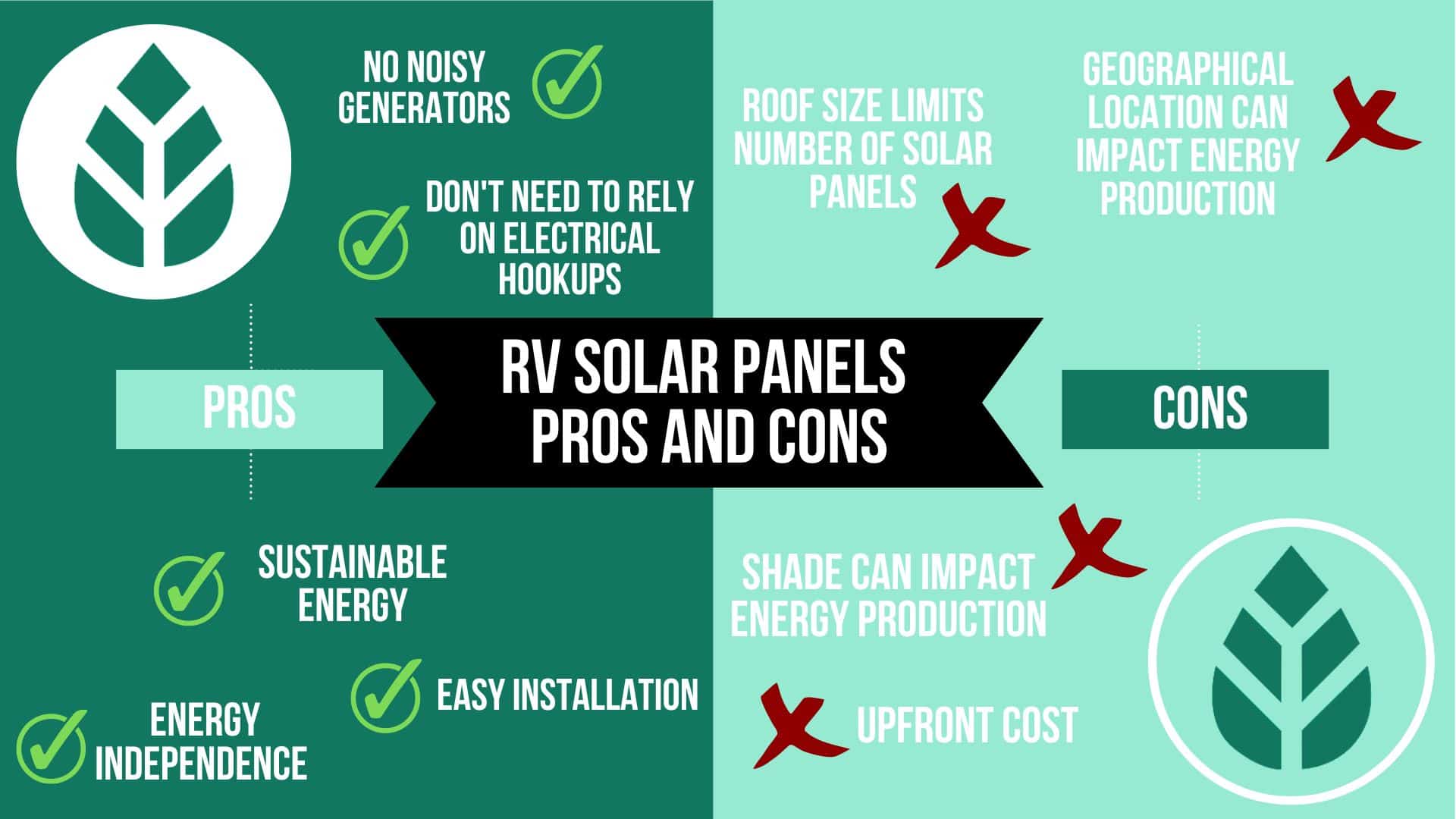
What to Consider When Buying Solar Panels for Your RV
Solar panel type.
There are three basic types of solar panels for RVs: monocrystalline, polycrystalline and thin-film solar panels.
Monocrystalline and polycrystalline solar panels are both made from silicon. The difference is that monocrystalline panels are made with a single, unbroken silicon crystal, while polycrystalline panels are pieced together from silicon fragments. Monocrystalline panels tend to be a bit more efficient, but also a bit more expensive.
Thin-film panels can be made from a number of different materials. They’re the least expensive option, but also the least efficient. Many RVers prefer this type of panel because they tend to be more lightweight, flexible, and portable, which makes thin-film solar panels well-suited for RV use.
Portability
Portability is a sought-after feature for RVers who don’t want to mount their panels on their RV roof. These panels can easily be moved around to face direct sunlight so that you can harness more energy. Portable solar panels have other advantages, such as:
- Easy to install and set up
- Can be moved around
- Often less expensive than mounted panels
- You can still harness sunlight if you park in the shade
- Avoid the use of noisy generators
The downside to portable solar panels is that you have to manually set them up for every use and shift them around as the sun moves across the sky. This inconvenience is why some RVers and van-lifers opt for mounted solar panels.
Expected Energy Consumption
Before buying solar panels for your RV, you’ll first want to figure out how many panels you’ll need . The number of panels generally depends on two factors: the amount of power you consume and your energy goals.
On average, RV campers use about 20 kilowatt-hours of electricity each day . This number is for your basic setup of appliances, but if you’re powering more heavy-duty appliances, you’ll probably need more panels.
The number of panels you need also depends on your energy goals. If you want to rely solely on solar energy, for example, you will need enough panels to offset your use. But if your goal is to use partial solar energy, then you’ll need fewer panels.
If you don’t know how much energy you use when camping, it doesn’t take a lot of effort to find out. One of the best ways to determine how much solar energy you need is to buy a basic solar setup and see how far that power goes. If you need more than the starter kit to offset your wattage, you can easily add panels and batteries.
Battery banks are an important component of any RV solar power system. Most RVs will only need a 12V battery, but some may opt for higher voltage depending on what needs to be powered.
You’ll also need to choose between lead-acid batteries and lithium-ion batteries. While lead-acid batteries are a common choice, they typically need to be replaced and maintained more frequently than lithium-ion ones.
If you camp most of the year, the more efficient, longer-lasting lithium-ion batteries will be worth the investment. But as always, it all depends on your unique solar energy goals and how much power you need for your appliances.

Final Thoughts: Is an RV Solar Power System Right for You?
After learning more about mobile solar systems, it’s time to decide: Are solar panels worth it for your RV camper?
Solar can be a great option if you consistently camp at sites that have electric hook-ups and you wish to reduce your environmental footprint. They can be an even wiser investment if you frequently camp where you don’t have access to the power grid.
Make sure you do your due diligence so that you can find the best solar panels for your RV, your budget, and your camping lifestyle.

Related articles

Are ‘Free Solar Panels’ Really Free? (2024 Guide)
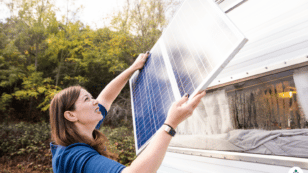
7 Best Solar Panels for Mobile Homes (2024 Guide)
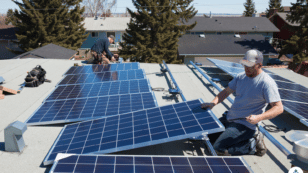
5 Best Solar Panels for Homes (2024 Costs, Reviews & More)
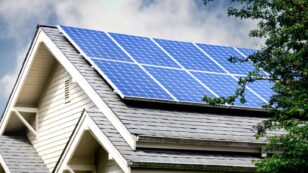
3 Types of Solar Panels (Which Is Right for You?)

Best Direction for Solar Panels (Tips to Maximize Output) (2024)
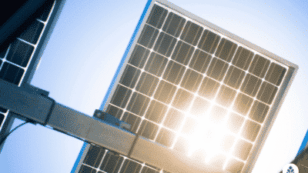
Arizona Solar Panels
Related Articles
- Best Solar Batteries
- How to Install Solar Panels
- Best Solar Panels for Camping
- 4 Best Rechargeable Flashlights
Comparing authorized solar partners
Having trouble deciding? Click below and use our process to receive multiple quotes instead:
The 8 Best RV Solar Panels Bring Sustainable Power Wherever You Roam
Power up, no matter where the road takes you.

Gear-obsessed editors choose every product we review. We may earn commission if you buy from a link. Why Trust Us?
But solar panels can be finicky. They aren’t always designed to endure the rigors of the great outdoors. And frankly, some of them simply don’t work as well as they should. Unlike the large, heavy solar panels you might install on the roof of your home, RVers need panels that are either compact enough to fit on a vehicle, or portable enough to stow inside.
A great RV solar panel, whether foldable or fixed on the roof, needs to deliver effective energy production and feature a rugged design that can handle dust and rain. If you’re packing up and hitting the road this summer, we recommend pairing your solar generator with a set of the best RV solar panels.
The Best RV Solar Panels
- Best Overall: Renogy 200W 12-Volt Solar RV Kit
- Best Value: Eco-Worthy 100W Solar Panel
- Best Mounted: Go Power! Overlander 190W Solar Kit for RVs
- Best Lightweight: Renogy Flexible Monocrystalline RV Solar Panel
- Best Premium Portable: Bluetti PV350 Solar Panel
The Expert: I’ve used portable solar panels about as extensively as is humanly possible. I relied on them for five years to power my remote work setup through some 40,000 miles of road-tripping all across North America. That work included reviewing solar panels, portable power stations and other relevant gear for leading publications like Popular Mechanics , Popular Science , The Daily Beast and Thrillist , among others.
What to Consider in a Set of RV Solar Panels
Solar panel materials are most frequently made from using silicon crystal, which captures solar energy. These panels come in one of two types: Monocrystalline silicon panels are made with a single panel of crystal, while polycrystalline panels are constructed from multiple crystal fragments. Monocrystalline panels are more efficient because it’s easier for electricity to move through an unbroken crystal. Given that, all of our recommendations are monocrystalline panels.
They can also largely be divided by whether they have a rigid or flexible structure. Rigid panels are a great option for flat-topped RVs, but if your rig has a curved or uneven rooftop, you may want the surface-hugging malleability of a flexible option. Both types are available with similar levels of weather resistance, though rigid panels often take a slight edge when it comes to efficiency of energy production.
Panel Placement–Portable or Mounted?
Before you buy your panels, consider where and how you plan to set them up. You want them to face the sun as directly as possible, for as long as possible. How you position your panels will vary quite a bit, depending on whether you use mounted or portable panels.
With an RV, you have the option to mount your panels directly on your vehicle. A rigid, mountable panel will be more durable than a portable set, water- and windproof to brave the elements, but they require some elbow grease to install. You may also find yourself unable to park in an ideal spot to catch the sun, limiting your capture capacity for the day.
They tend to sit face-up on the roof and aren’t adjustable, so you’ll have a narrow window for maximum efficiency. On the other hand, your rooftop panels will capture energy while you drive, so they’ll draw power for a larger portion of the day.
Portable solar panels are more flexible, literally and figuratively. They fold up for compact storage, and are designed to be easy to set up and tear down. They often have integrated kickstands and handles to help you optimize your placement, no matter where you’ve posted up for the night.
That said, you need to be careful to put them away when the weather turns gray: They are scratch-resistant and can handle a light shower, but they’re typically not meant to stay outside around the clock. And unlike rooftop panels, which are bolted in place, you may not feel safe leaving your portable, easily stolen panels out while away from your campsite, meaning you can only generate power while you’re there.
Wattage and Efficiency
A solar panel's wattage specification indicates the amount of power it can produce in one hour. Most RVs and campers can get enough juice to power their appliances and a few electronic devices for a full day from a 100- to 500-watt solar panel setup. A slim 100-watt panel will provide enough juice to power a small fridge, a toaster and a coffee maker.
We imagine, though, that most RVers have more gear than that: If you have an electric stove or a large fridge, we recommend using panels that can bring in at least 400 watts. If you have electronics that need regular charging, like a smartphone or laptop , you’ll need to collect extra power for that as well.
Whatever your daily power consumption is, aim for having a system that will produce at least two-to-three times that if you expect to use electricity around the clock for multiple days on end. Every person’s exact power needs will vary. If you aren’t sure what you need, we recommend starting small and upgrading when and if you need to. You can always buy multiple panels, rather than upgrading to a more efficient model.
One thing to keep in mind: Wattage and other specs provided by manufacturers, including those cited in this guide, describe how the panel will work in optimal conditions—a bright, sunny day without a cloud in the sky. More often than not, you will pull less energy than advertised. To get a better sense of what you can actually expect on an average day, check the efficiency rate, which estimates the panel’s capacity to convert sunlight into usable electricity. The best solar panels operate at 23 percent or higher.
If you go with foldable panels, make sure you can pick them up and pack them up comfortably, because you will be moving them around a lot. Generally speaking, the higher the wattage rating, the heavier the panels. So, while it might seem convenient to rely on a single 400-watt unit, you may be better off setting up two or more panels than setting up and adjusting something that weighs as much as 40 pounds.
How We Selected The Best RV Solar Panels
We picked the best RV solar panels based on years of experience testing and recommending solar gear, including generators and panels. We also researched panel specs and performance, including data and recommendations from specialty outlets like Treehugger and SolarReviews .
In making our selections, we considered many scenarios for RV owners and power setups to present a range of options that work for as many people as possible. Having spent years and many miles on the road working remotely, I've learned firsthand about the benefits and pitfalls of different solar setups. Lastly, we checked consumer reviews for all of these picks to make sure we didn’t accidentally select a panel that looked perfect on paper, but was actually a lemon. These are the best RV solar panels to keep you powered up on the road.
Renogy 200W 12-Volt Solar RV Kit

This kit has everything you need for easy installation on your RV or camper. It’s made specifically for first-time solar panel users, with a straightforward, user-friendly design. For smaller van conversions, you’re probably better off with a portable power station, but this is exactly the kit you need for mid-sized vehicles like Sprinter vans or camper trailers and medium-sized RVs where you want the convenience of power going directly to your rig’s battery.
The two 100-watt solar panels are rigid but relatively lightweight at 18 pounds–and the kit comes with everything you need to mount them. The included charge controller has LED indicators that allow you to monitor charging, which will help you avoid overcharging or, worse, overloading your system. They also alert you to input changes due to weather conditions like rain, clouds, or nightfall.
The aluminum frame panels are UV- and corrosion-resistant to withstand high winds, rain, snow, and blazing heat, so they’ll take just about whatever the elements throw at you. For anyone looking to install their first RV solar panels on their own, this kit is an excellent pick.
Eco-Worthy 100W 12V Solar Panel

There’s nothing fancy about these panels from Eco-Worthy, but that’s kind of the point. They’re exactly what you need if you’re looking to set up solar panels on your RV for as little as possible. They’re the perfect size for mounting via the pre-drilled mounting holes, and you should be able to fit three to four of them on most RV rooftops. They come with integrated 35-inch connectors that run into a waterproof junction box, and the whole panel is waterproofed with sealed and tempered glass.
They’re surprisingly durable for such low-cost panels, too. Once you’ve got them on your RV roof, however, they should last for years.
Go Power! Overlander 190W Solar Kit for RVs
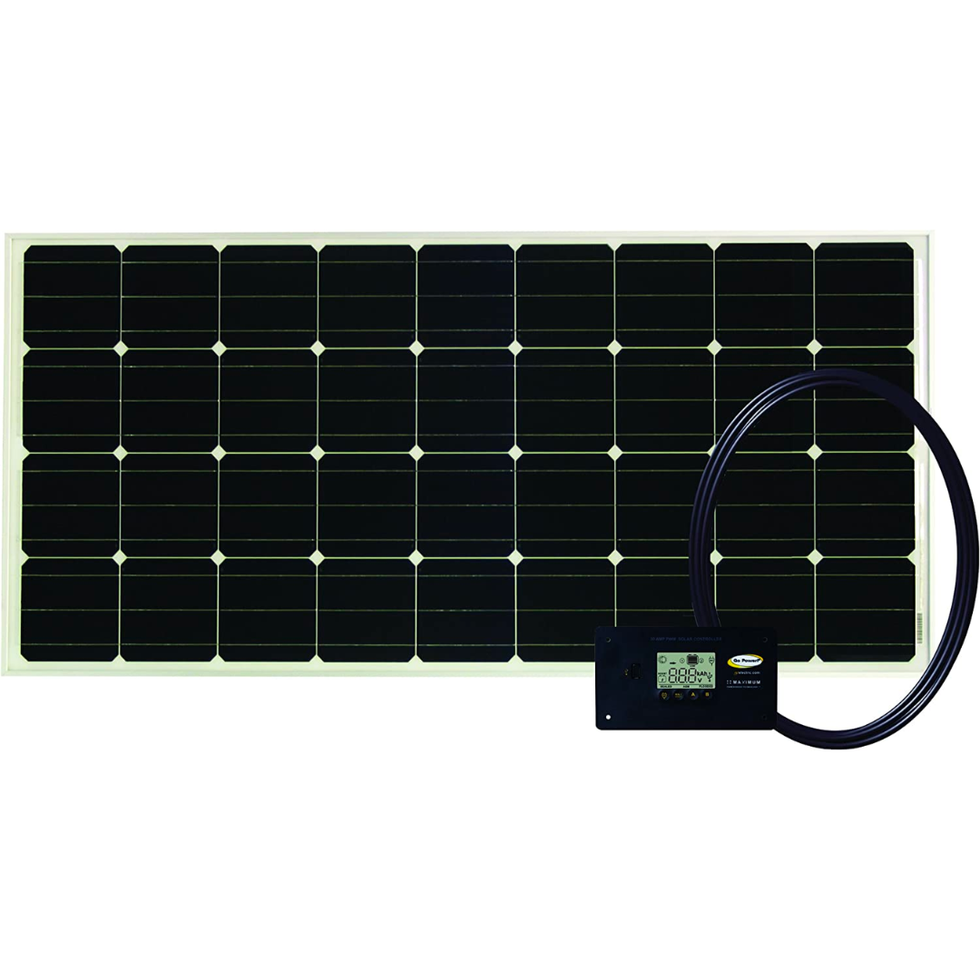
This extremely large 12-volt panel draws up to 190 Watts of power to keep any battery charged on long trips, camping, or on the road. It’s a bit heavy–26 pounds–but its anodized aluminum frame and durable tempered glass panels hold up well against rough weather. Customers report easy installation and that the controller maintains power in their RVs even in less-than-ideal conditions like partly cloudy skies and rain.
If you need more power, the company sells an expansion kit that doubles the output. It’s designed for seamless connectivity between your existing solar power system and the panels you want to add for more power. If you need a lot of juice, this is probably the best mounted panel for the job.
Renogy 100W 12V Flexible RV Solar Panel
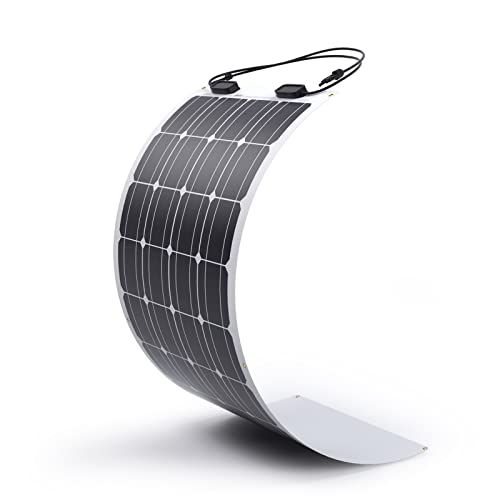
This bendable RV solar panel is great for uneven surfaces like Airstreams and vans, or propped up facing the sun at your campsite. It weighs just 4 pounds and can withstand high winds, rain, and snow.
The mounting uses silicone adhesive for permanent installation without any drilling. It can flex up to 248 degrees without any micro-cracks forming, which is handy for hitting the right angle after mid-day.
Customers like the slim profile of these panels and say the output is great for such lightweight panels. These are best suited for small camper set-ups or as expansions to larger RV solar energy systems, as just one or two of these aren’t enough for a large RV with a lot of appliances.
Bluetti PV350 Solar Panel

Bluetti makes some of the best solar gear in the industry, and the PV350 solar panel is an upscale buy that’s worth the investment. It absorbs up to 350 watts per hour, which is huge for a folding panel. At the same time, it’s remarkably compact, folding down to a compact 35.6- by 24.1-inches for easy storage.
There’s a downside, of course–it weighs 30 pounds–which may make it tough to set up. You can’t beat that size-to-wattage ratio, though.
It’s also designed for efficiency. The cells are wired in parallel, rather than in a daisy-chained configuration like you find in most cheaper panels. This allows it to continue collecting power when mostly shaded. (Many panels will stop operating if they aren’t getting very good coverage.)
The PV350 is also well-built. Nick took one on a trip through the deserts of Utah and Nevada, where it saw no shortage of hard treatment from dust, wind and my own rough handling, but emerged without any major damage. That said, it isn’t fully waterproof: You can leave it out through a light drizzle, but avoid charging on rainy days.
Goal Zero Nomad 100

Goal Zero is known for making tough, outdoor-friendly solar gear for camping. Case in point, the Nomad 100 is perfect for pretty much any camping scenario, whether you’re charging up your RV or a portable power station. Weatherproof and built like a rock, it’s designed with tie-down loops around the frame. These are great for both staking it into the ground or affixing it to your RV rooftop to keep it in place when the wind kicks up.
The Nomad 100 folds down to a comparatively small 20- by 15- by 2-inches, it’s easy to pack and move around. It draws 100 watts, which is good for its size, but you may need a few of them to fully charge up an RV.
To that end, you can daisy chain multiple Nomads without a splitter. That said, its 8mm plug is not universally compatible with all systems and power stations: Many support it, but you may need an adapter if yours has a different port.
Jackery Explorer 2000 Plus Solar Generator Bundle

You see Jackery gear everywhere in the RV/van life scene these days because the brand offers such an expansive variety of dependable solar products. After using many Jackery generators, I found the 2000 Plus brings the perfect balance between physical size and capacity: Its 2000-watt-hour capacity is plenty for most campers, but it isn’t so large that you can’t bring it out when you need it.
Weighing a hefty 96 pounds, it isn’t exactly light, but compensates for the heft with integrated wheels and a telescoping handle so you only need to lift it to get it on and off your vehicle. Plus, it has a 25A plug, so it's designed specifically to bring on an RV.
This kit pairs the 2000 Plus with two of Jackery’s 200W SolarSaga panels , which are among the best you can find. They’re very durable—I can’t tell you how hard I’ve worked them over the years. Plus, they fold down to an easy-to-carry package, and are reliable in most sunlight conditions.
And, if you need even more juice at some point, you can expand the 2000 Plus’ capacity with up to five of the brand’s 2000 Plus battery packs , which can store as much as 12,000 watt-hours of power. That’s more than you’ll ever need on an RV, but it’s always nice to have the option.
EcoFlow 220W Bifacial Foldable Solar Panel

Bifacial panels, which can absorb solar energy using both their front and back face, aren’t as common among portable and RV panels as they are for home setups, but they definitely offer benefits while camping. By capturing solar energy from the light that bounces onto the back of the panel, they can capture more energy and be more efficient when it isn’t placed perfectly.
According to EcoFlow, the second face of their 220W Bifacial Foldable Solar Panel gathers 5- to 25-percent more energy than a single-sided panel. Personally. I’d say 25 percent is a stretch, but 15 seems in line with my experience and that’s not nothing: Every bit of juice counts when you’re on the road. I found it especially useful for off-season camping, when the days are shorter and you get a narrower window for gathering sunlight.
I also loved this panel’s tent-like stand design, which makes it easier to set up and place than other folding panels. It’s lightweight–just 20 pounds–but it’s also pretty big and can be tough to lug around.
Q+A With Our Experts

What kind of tools do I need to install a solar panel on my RV?
Much of the work can be done with basic tools you likely already have like a cordless drill , screwdrivers , and wrenches . I’d also recommend keeping a pair of wire cutters and strippers handy, as well as a hydraulic crimper, a MC4 connector/crimper tool, and a digital multimeter . As with any project involving electricity, it’s always a good idea to use dielectric tools that won’t conduct electricity.
Will mounting a solar panel on my RV change how I drive?
It’s unlikely. Typically your panels are more or less flush against the roof, which shouldn’t noticeably alter the aerodynamics of your RV.
Any advice on how to park my RV for great solar panel placement?
Try to park with the front to the east and the rear to the west. This will provide your roof with the maximum amount of sun throughout the day. As an added bonus, if you’ve got a typical left-sided fridge it will keep it somewhat shaded, reducing its power demand. When parked in direct sun, keep your window blinds closed to keep the interior cooler, further reducing the strain on your fridge.
Can I use my solar panel to jump-start my RV?
The short answer is no. The long answer is that the energy collected from a solar panel needs to be converted to a voltage and amperage required by whatever you want to use or charge. Without a charge controller to regulate power flow, and monitor battery charge levels, the current your solar panel outputs won’t be compatible with your RV’s battery.
Nick Hilden is a writer, globetrotter, and jack-of-many-talents who has written gear reviews for the likes of Runner’s World , Popular Science , Men’s Health , Thrillist , the Daily Beast , the Los Angeles Times , Greatist , and the Manual , and his lifestyle, culture, and tech writing has also appeared in Scientific American , Afar , Salon , Vice , Healthline , and many others. Before entering journalism some 15 years ago, he worked as a bartender, brewery manager, sound engineer, recording and touring musician, cook, teacher, and in a variety of other trades. These days, he lives all over the world, performs music sporadically, and spends a lot of time thinking how to best improve his Honda Element conversion.
Danny Perez is a Commerce Editor for Popular Mechanics with a focus on men's style, gear, and home goods. Recently, he was coordinator of partnership content at another product journalism outlet. Prior to that, he was a buyer for an independent men's shop in Houston, Texas, where he learned all about what makes great products great. He enjoys thrifting for 90s Broadway tees and vintage pajama sets. His spare time is occupied by watching movies and running to impress strangers on Strava.

.css-cuqpxl:before{padding-right:0.3125rem;content:'//';display:inline;} The Perfect Road Trip .css-xtujxj:before{padding-left:0.3125rem;content:'//';display:inline;}

10 Great Gadgets For Your Next Road Trip

What It's Like to Drive Across the Top of Alaska

The No-GPS Road Trip

10 of America's Must-See UFO Destinations
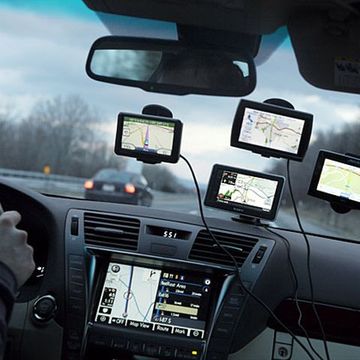
The Best GPS Units For Your Next Hike or Road Trip
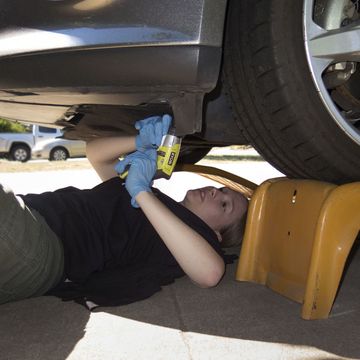
How to Prepare Your Car for a Road Trip in One Day
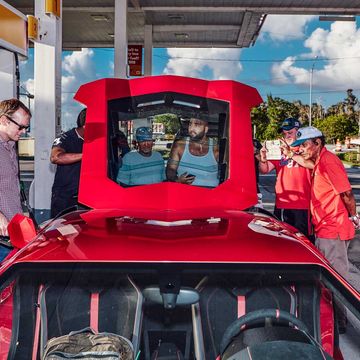
I Took a Road Trip in a Supercar
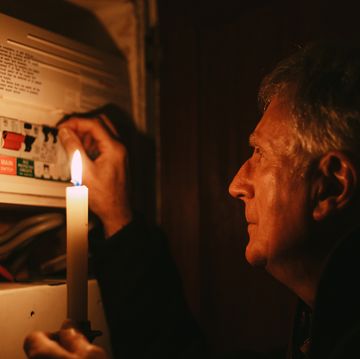
Surviving the Inevitable Summer Power Outage
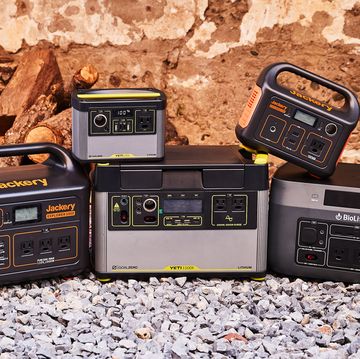
The 9 Best Solar-Powered Generators

The 7 Best Camping Lanterns to Light Up the Night
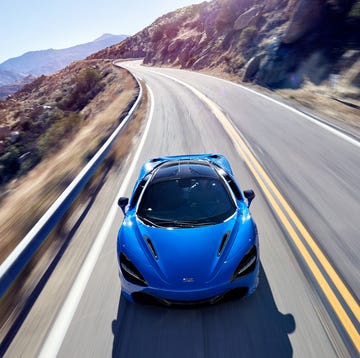
15 Countries Worth Visiting for an Epic Drive
- United States - English
- United Kingdom - English
- Canada - English
- Australia - English
- Other Europe - English
- Germany - Deutsch

How to Hook Up Solar Panels to RV Batteries
When we present our “Solar 101” seminars at RV & Sports Shows around the country, the number one question we get from new RV and van owners is, “My rig says it’s ‘solar ready’...what does that mean, and what do I need to do to wire solar panels to my RV?”
But before you go cutting wire and grabbing MC-4 connectors, it’s important to first assess your energy needs and THEN size a solar powered system that’s going to fit your rig and how you intend to use it.
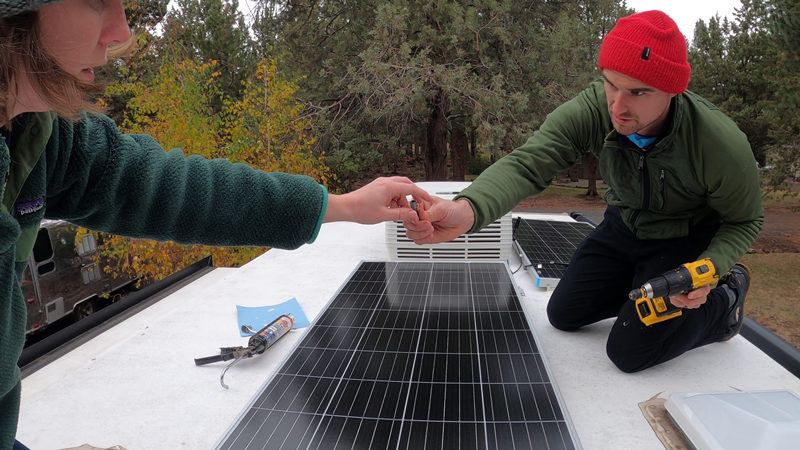
How to Wire Solar Panels to RV?
Here are some questions to ask yourself before simply hooking up solar panels to your RV .
● How many days do I want to run my RV without plugging into an external electrical outlet (e.g., “shore power” at an electrical campsite)?
If you only plan to spend one or two nights in between electrical hook-up campsites then your solar paneled system can be simple. One option is a solar suitcase (with an included charge controller) that can simply be connected to your RV battery via alligator clips - red to positive & black to negative. On the other hand, if you plan to go fully off-grid and run your RV with solar, like we do , then you will need to plan out a much more robust system, with all 4 components of a solar paneled system . See this helpful worksheet to begin this process.
● Is my RV/van listed as “solar ready” or “pre-wired for solar”?
Is there a solar input port on the outside of the rig? Does it require a specific brand of solar panel (or provide a QR code or website for more information)? This will help you determine what type of panels you’ll need to purchase – or if you simply need to buy an inexpensive SAE to MC-4 adapter and SAE reverse polarity plug (search this product on Amazon) to adapt them for Renogy solar panels . You can then choose rooftop panels or a solar suitcase, or better yet, a combination of both that will give you more boondocking flexibility. Check out this blog to learn more about what “solar ready” means.
● Is there a solar panel already installed on top of my rig (usually less than 50W)?
We get this question a lot, “I already have a small panel on my roof, can I just tie that into my new system?” The answer is, probably not. These smaller factory installed panels are designed to simply maintain an already charged battery, so that the RV’s lights and slideouts work while for customer walk-throughs while sitting in the dealer lot.
This small panel is NOT designed to recharge a depleted battery while boondocking. If you plan to install more permanent solar panels, this small one will likely have to come out – in addition to the small charge controller connected to it and any wiring currently going to the battery. To have an effective solar panel system, with multiple panels, they all need to be all the same wattage.
● What is the capacity and type of my RV battery bank?
Unless you plan to replace these batteries, you need to know this so you can determine how to charge the RV battery with solar panels. Most rigs these days are equipped with AGM or flooded lead acid batteries, which range from 85-200Ah. Some newer, higher-priced rigs which are designed for boondocking provide Lithium Iron Phosphate (LFP) batteries pre-installed. These LFP batteries are longer lasting, more expensive, and more powerful.
Knowing the size and type of your battery bank will help you determine how many panels you’ll need, as well as the size of the charge controller. See this blog for more detailed information about deep cycle battery options.
● What is the square footage of my RV roof? How many panels will fit? And, how do you plan to connect them (parallel vs. series)?
While Renogy panels range from 50W to 550W, most RVers use 100W - 200W panels due to roof size / dimension limitations. Here are some options:
Rigid Panels Options : 100W panels weigh 14.5 lbs each and measure 43.3”x 20” x 1.38”; 200W panels weigh 26.46 lbs each and measure 58.7” x 27.5” x 1.38”
Flexible Panel Options (very lightweight, durable, and designed for curved roof lines): 100W weigh 4.2 pounds each and measure 48” x 21.6” x 0.08”; 175W weigh 6.2 lbs each and measure 59.2” x 26.5” x 0.08”; 200W weigh 10.8 lbs each and measure 63.2” x 29.4” x 0.1”
See this blog (scroll down a bit) for more information about how and why to create a solar array in parallel or series (or both).
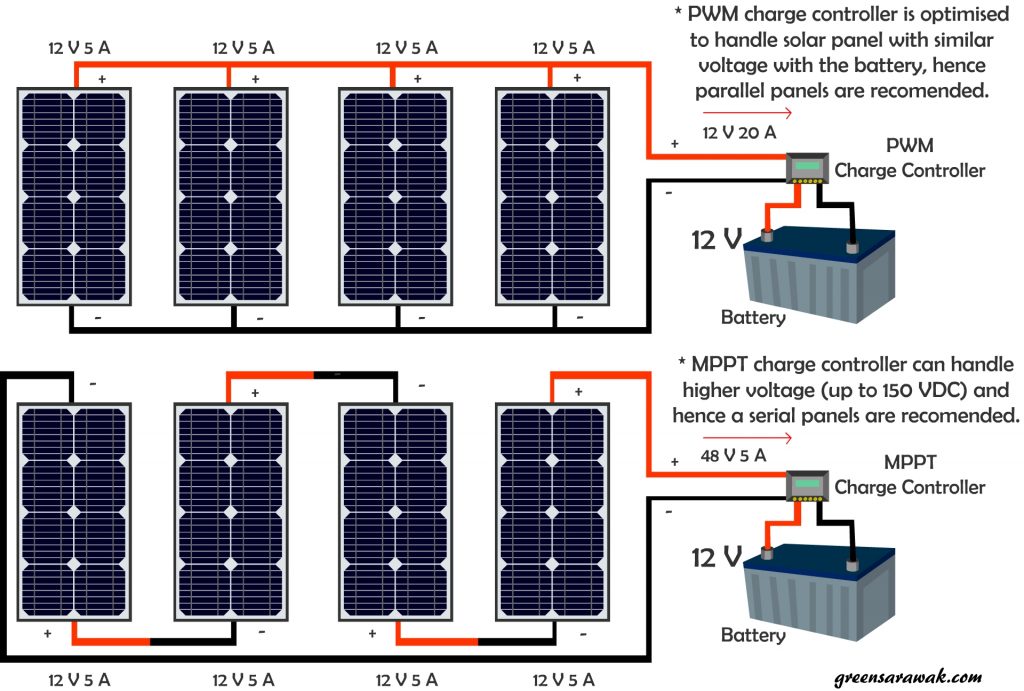
● Does my RV/van manual mention anything about a solar charge controller already installed?
While it's always good to check to be sure, more than likely the RV will NOT be equipped with a charge controller as they come in different sizes (rated in amps) to accommodate the total power output of your solar array, as well as the type of batteries to which it will be connected.
To help you get your head around an installation, check out this 1 minute solar panel installation overview:
How to Wire Solar Panels to RV?
Now that you’ve answered some key questions and you’ve planned out your system , let’s dive into some wiring and connection steps so you can know how to charge your rv battery with solar panels !
First, if you have a “solar ready” port on your RV, your energy needs are low, you usually camp in very sunny locations, AND you only plan to boondock for a night or two, then a single 100W or 200W solar suitcase with an attached charge controller may be all that you need. As mentioned before, “solar ready” plugs may have intentionally reversed the polarity of the plug to only work with a specific brand name solar panel. To determine this, check the polarity of the plug with a voltmeter or multimeter. You may need to purchase an SAE reverse polarity plug in order to use Renogy panels.
BUT, if you want to create a system that will allow you to live off-grid for longer and/or to meet higher energy demands, then read on for basic diagrams and step-by-step instructions.
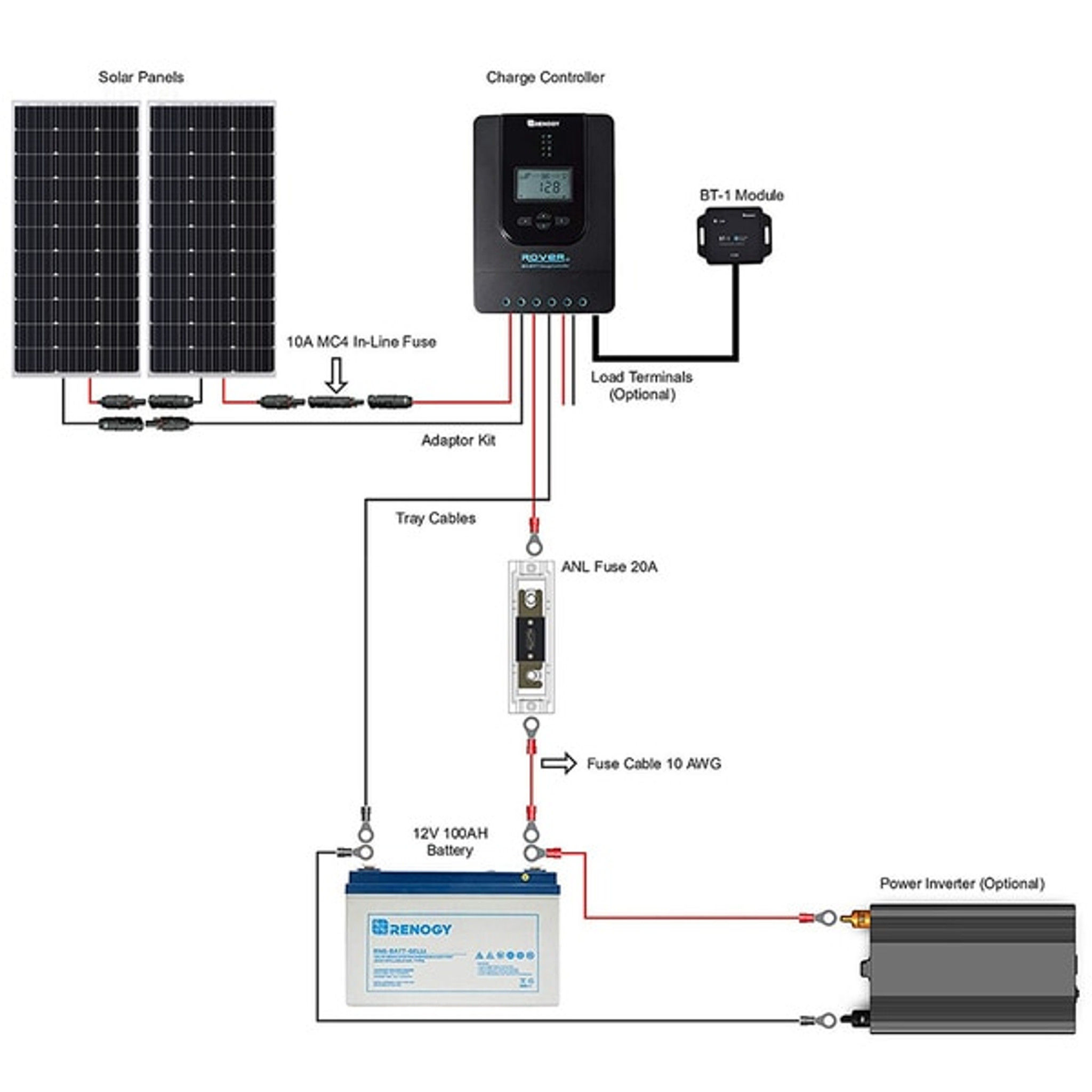
Step by Step Instructions for an RV Solar Connection:
1. Secure the solar panels to the roof of your RV. There are many ways to do this depending upon the type of panel you will use and the material of your RV roof. See this blog to learn various ways to attach different types of solar panels to your rig.
2. Wire the panels together (in series, parallel, or both) using MC-4 Branch Connectors . Be sure to mark the positive (+) wire with red electrical tape, so you know which wire is which. Add an appropriately-sized inline fuse (easy to connect MC-4) downstream of the branch connections along the positive (+) wire as this protects the wire from damage. Next, mark the end of that same positive (+) wire with red tape. Send both wires through the cable entry gland on the roof (this housing makes drilling and sealing a hole into the roof of your RV painless!). Now, when you get down into the RV for the next few steps, you'll be certain which wire is positive and which is negative.
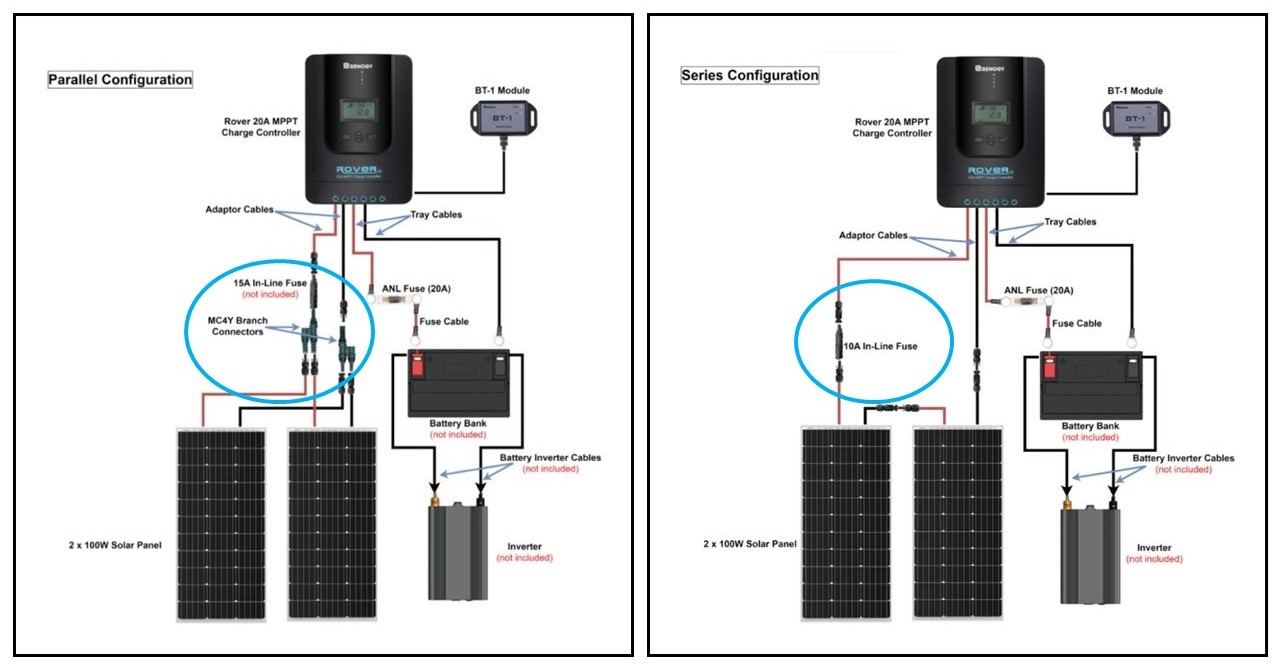
3.While this is somewhat counterintuitive, you MUST connect the solar charge controller to the battery bank, BEFORE wiring the solar panels to the charge controller because when the panels are irradiated by the sun, they immediately begin producing power, and that power has to have somewhere to go. Safety Tip: Cover your panels so they are not irradiated before beginning any wiring so that there is no power/energy running through the system.
4. Locate the output side of the charge controller. Using appropriately-sized tray cables , secure the positive (+) wire into the output side of the charge controller, then connect it to an appropriately-sized ANL fuse (or breaker switch), then from the fuse to the positive (red) terminal on the battery or positive battery bus bar. Secure the negative (-) wire into the output side of the charge controller and run it directly to the negative (black) terminal on the battery, or negative bus bar. Note: Bus bars are appropriate when you have more wire terminals to connect to the battery terminals than can easily fit. It’s a great way to easily manage wiring. See diagram below.
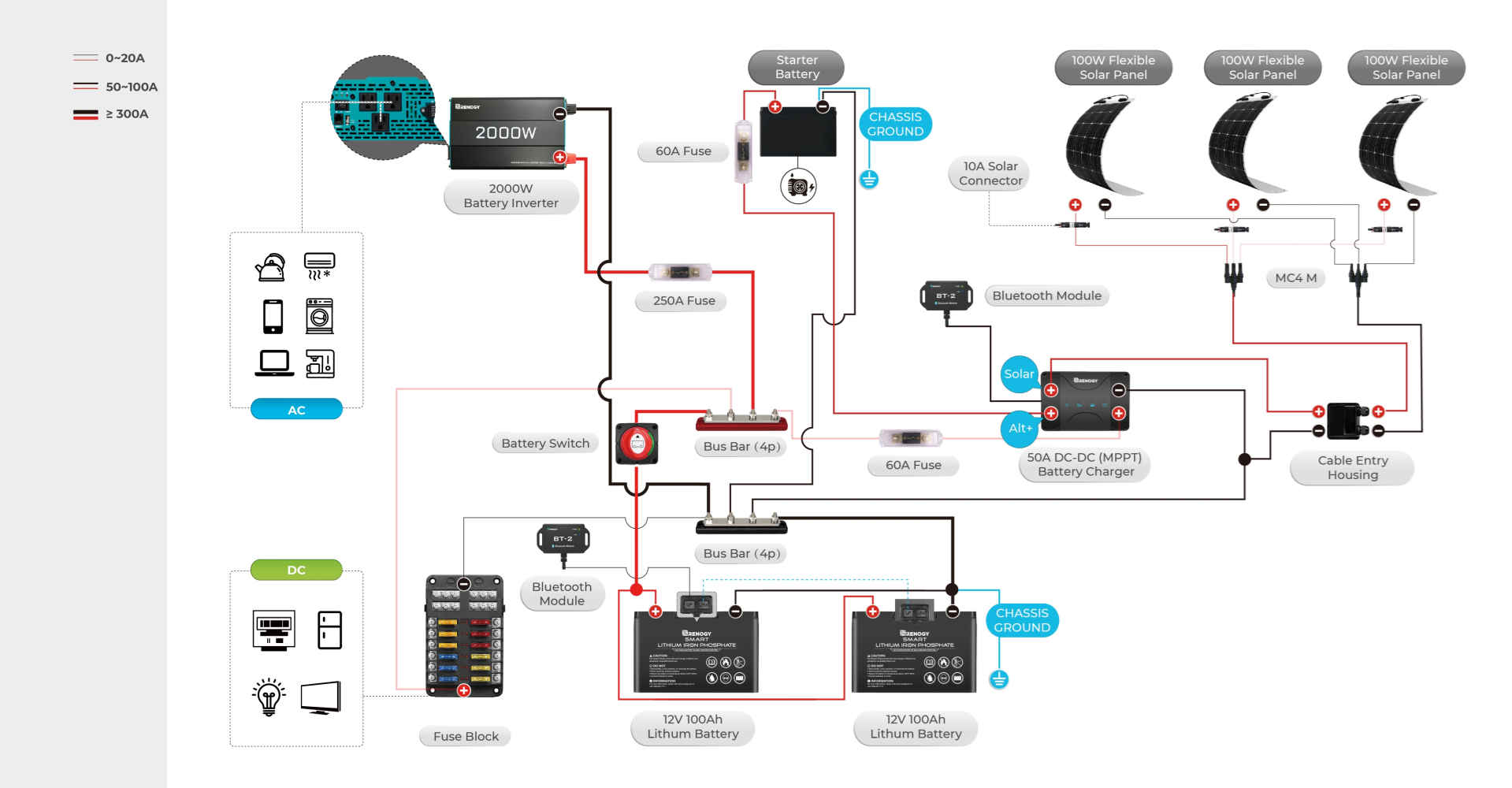
Unless you have an on/off switch on your battery (and the battery is set to off), the charge controller should power on immediately as you’ve just given it the power it needs for the display to operate. Important! Read the Quick Start Guide and set the battery type (Flooded, AGM, Gel, Lithium) or use the manual setting if applicable. Also, be sure you’ve provided adequate space for the charge controller to vent. This necessary ventilation space is clearly outlined in the Quick Start Guide. Finally, if the charge controller does not power on, see the troubleshooting chart for possible issues before proceeding to the next step.
5. Locate the input side of the charge controller. With the 2 wires coming in through the cable entry housing from the roof, find the positive wire (that you marked with red tape). Secure it into the (+) terminal of the input side of the charge controller. Next, take the negative (-) wire and secure it into the (-) terminal on the input side of the charge controller.
Those are the basics! To watch a complete installation (from panels to charge controller to battery), check out this video:
While there are many different solar panel configurations, types and sizes, the way to hook up solar panels to your RV is usually the same – Panels to Charge Controller to Battery Bank to a DC Fuse Box and/or a DC to AC Inverter. Check out our Solar Resources page and you’ll be running your RV off of solar power in no time!
In 2012, Shari Galiardi & David Hutchison left behind careers and a comfortable home in North Carolina to travel with the vintage camper trailer they lovingly restored, outfitted with solar, and named "Hamlet." What began as a short break from careers and responsibility quickly turned into a love affair with roadlife. They have parlayed their higher education backgrounds, desire for life-long learning, and thirst for adventure travel into writing, photography, video production, and public speaking gigs from coast to coast. Known to their friends as simply Shari & Hutch, you can learn more about their full-time, solar-powered adventures on their website at freedominacan.com . Or, follow them on Facebook , Instagram , and YouTube as “Freedom in a Can, LLC.”
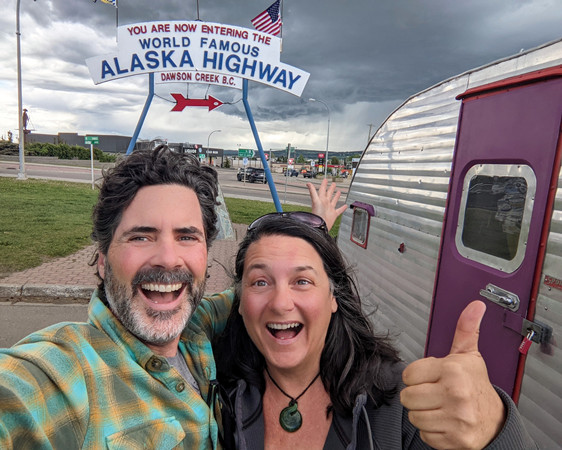
Related articles:
How Does The Solar Tax Credit Work?
Everything You Ever Wanted To Know About Renogy Charge Controllers
RV Inverter Installation Guide
Battery Dies In Cold Weather: What Low Temperatures Do To Your Battery
Solar Battery Storage System Cost: Things You Need To Know
Be the first to receive our latest news and exclusive deals!
- Solar Panels
- Off Grid Solar Kits
- Charge Controllers
- IoT Monitoring
- Deep Cycle Batteries
- Battery Chargers
- Accessories & Wiring
- Renogy Gear
- Troubleshooting
- Shipping/Warranty/Return
- Service Center
- Learning Center
- Success Stories
- Renogy Power Plus
- Renogy Discord Group
- Become a Dealer

- Accessibility |
- Privacy Policy |
- 4G App Privacy Policy |
- Do Not Sell My Personal Information
Create an account with us and you'll be able to:
- Join Renogy Power Plus and earn Rays
- Get exclusive rewards
- Track new orders
- Access your order history
- Save multiple shipping addresses
Create Account

How to Use Solar for RV Boondocking (Setup, Best Kits)

- BEGINNERS GUIDE / BUYERS GUIDE
G. Yoganand
Boondocking or dry camping refers to RV camping without hookups. You don’t get water connection, no sewer hose connection and also no electricity. In such a scenario, you are dependent on your battery bank, generator and propane for power or energy requirements.
Another way to meet your power requirements is to use solar panel system. In this article, we will discuss the pros, cons of solar power for RV boondocking. We will see if its a best option and how one can get it installed.
Read : Learn on the basics of solar for RV
Is solar a good option while boondocking in an rv?
Some campsites have electric hookups available for campers who need it as they include it in the cost, or for a fee, you can have electricity when you go camping. But when you go off the grid Aka boondocking, it is an entirely different game.
Having solar panels may be your brightest idea yet when you go boondocking in an RV . When you go boondocking, and there are no electric hookups, you can use solar panels for your extra-source of energy.
Although the RV comes equipped with RV batteries, it needs steady recharging. This is true, especially if you have a lot going on inside your RV, such as having air conditioners, fridge, TV, and other electronic devices or gadgets.
For some, this is a great idea if you have a ready solar panel for when you suddenly need to leave and go someplace unheard of. But for others who rarely go to any remote places that do not have electric hookups, it may be an added expense that they can go without.
How many solar panels watts would you need?
Factors such as electronic equipment you have in your RV and other devices will also gauge how much you will need.
Low to Medium power consumers include laptop computers, fans, microwaves, toasters, light, water pumps, coffee makers, hair dryers.
While air conditioners, space and water heaters, heat pumps are all high-power consumers.
The number of solar panels and watts you will need will depend on your electronics usage in your RV meaning if you have the usual coffee maker, hair blower, a microwave perhaps, and a TV the estimated wattage you will need is between 400 to 600 watts of solar panels.
If you need to have some heavy electronic usage, such as a fridge plus other essential electronic devices and equipment, the watts you will need are between 3,000 to 4,000 watts.
But if you just have basic electronics in your RV, such as laptops, light, and a TV, you will need between 200-300 watts of solar panels.
So if a 100-watt solar panel can produce 30 amp-hours daily, this can determine how many solar panels you will need in your RV.
What can you run
Common appliances such as a light bulb, microwave, mini-fridge, and TV can run with solar on the RV. If you are an RV user that depends more on numerous electric appliances you may need to have a higher watt or additional solar panels installed.
Some can get by with minimal electric consumption, these people can use simple Led lightings, they charge their electronic devices, a heater perhaps, also water pump, and one to two hours of TV usage.
The other consumers can use additional electronics such as a crock-pot, small fridge, toaster, and use the TV for four to five hours.
And then some RVers cannot get by without multiple TVs, a coffee maker that is usually on for hours, a large fridge, also a large microwave oven and an AC. They usually require high watts that can go beyond 600 watts.
There will be two types of appliances or items inside your RV. One that will run on AC power and the other on DC battery power. Also, you will have some things that can run on propane as well.
Propane is a great option for boondocking. Refrigerator, furnace, stove can run on propane. Refrigerator can also work on DC battery or generator AC power.
With solar you will be basically storing the power in battery which can be directly used or you can convert it to AC via an inverter.
We run our 48 inch TV on inverter for around 2-3 hours daily on solar. Plus we also charge mobiles, laptops using the pure sine wave inverter. We also run other appliances that run intermittently for very short period of time like crock pot, egg boiler.
We do not run bigger high consumption appliances on inverter like the hair dryer, microwave or toaster. These appliances have higher watts consumption and also run for little longer. AC again is high watts consumption appliance.
For these we utilize our portabel generator. Thats the best option.
The solar charged DC battery powers various components in our RV. The LED lights, multiple fans in bedroom, kitchen, bathroom are powered by battery. The DC battery also provides power for carbon monoxide detector, furnace, refrigerator, stereo and few other items.
To summarize, solar is good enough to run most of the appliances in RV except for air conditioner, Refrigerator, microwave, hair dryer and other high watts long running appliances.
Can you run Air conditioner
Air conditioners in RV run on generator or the campground electricity connection. Its not practical to run them on battery. Therefore most RVers will have generator to run the AC when boondocking.
A inverter will convert the DC power from battery to run some of the appliances but its not really for the bigger appliances like air conditioner which need more watts.
Also Read : Average watts consumption by RV Air conditioner How Many watts do RV furnace consumes Average watts requirements of RV
To run a 13,500 BTU air conditioner you will need at least 2000 watts for starting and 1500 watts for running. To produce that many watts you will need bigger inverter probably more than 2500 watts. Usually, the inverter that you get for RV range between 1000 to 2000 watts.
So, to answer the question, yes it is possible to run the Air conditioner on battery power but not an ideal or practical way.
What about lithium batteries and a solar combination
Lithium batteries can be used much longer and without affecting their long term operations. But, even with such batteries you are looking at a lot of batteries. For example, say you want to run the air conditioner for around 6-8 hours, you would need 6-8 batteries delivering 100 AH.
And with these many batteries the weight will also be high. Each of these 100 AH batteries will weigh a minimum of 50 pounds and with 6-8 batteries it will be close to 250 pounds. That’s with the weight.
Cost again is going to shoot with those many batteries. One word. Not practical.
Get a generator that is good enough to power your 13500 BTU or even 15000 BTU air conditioner.
Setting-up your rv solar panels
You can either have a professional do the installation of the solar panels for you or if you are more of a DIY person and can tinker easily with the tools you have, you can set up the solar panels yourself.
Before you buy your solar panels, consider how many watts you will need, and from there, you will know how many solar panels you should purchase.
Since there are also sellers of solar panel kits willing to help with their buyers, it would be best to ask for advice and tips from these sellers.
Before you go home and bring your solar panels with you read the instruction that comes with the solar panel kit so you will understand the step-by-step process of installation.
Check what they include in your solar kits as the screws, brackets, and solar cable connectors for your panels should be there. Adhesives are also a must, ask the seller if they have any available.
Important steps in installing
You need to measure your roof, then the panels, but first, conclude the panel layout that you prefer. You need not waste time on bringing everything up on the roof while you don’t have the measurement in place yet.
Make sure you are placing the solar panels away from A/c units, TV antennas, or coverings of the vent fan. You need to keep in mind about shades and shadows, which can hamper your solar panel from absorbing solar energy.
Measure the solar cable as it should not be over twenty-five feet from the solar panel directly to the battery bank, ensuring that you don’t have a cable that is too long will prevent loss of charging power.
The gauge should not be smaller than ten gauges, choosing a larger, and thicker wire may benefit you more since there is a better power transference.
Do not forget to purchase an amp breaker as well. You can either wire your solar panels in parallel or series. Installers may also assist you on this one as they know more about the benefits of having the solar panels in parallel or series.
Make sure that your solar panel installation is watertight around the edges.
Solar controller or remote for your inverter will make things a lot easier for you when you need to monitor battery charging. Remotes should also be accessible.
Where to install them
You can either have it installed on your RV roof or just buy a portable and easy to place on the ground solar panel.
Having your solar panels on your RV roof can be helpful and disadvantageous at the same time. Beneficial because you don’t need to keep on placing it on the ground just to absorb the sun’s rays as it is just sitting there on your roof doing its thing.
We have our solar panels installed on the roof. The reason why we did that is because:
- You don’t have to pack and unpack the panels every time you are set for the camping. The panels rest there at the top and provide the power needed.
- The exposure to sun is maximum at the top of the roof. Sun is all you need for your panels so that works great.
- Your panels are safe. Less likely to be stolen wen they are there at that height.
- It isn’t taking your storage space. Roof otherwise would have been empty and underutilized anyways.
- Not much efforts when you have them on the roof. We do have brackets installed for titling them wherever needed though. Its not much of effort though. We did our own brackets instead of going for solar kits. It saved money for us. You can either build your own or for solar kits that are much easy to install. The cost would be higher though.
The negative aspect of having your solar panel on the roof is you tend to forget to clean them, and hence it makes the solar panel less effective.
Another drawback is that it needs space on your roof, and with that, if you need to take a peek atop your roof, make sure that you don’t step on the solar panels.
Solar panels that you can place on the ground are manageable, and you can tilt them to face the sun at an angle. With it being portable, you can also clean it more often.
However, since it is a portable solar panel, you need to set it up all the time and find a fitting spot to place it on.
It is ideal also for those RVers with only a small electricity consumption, with powerful winds portable solar panel can topple over or can also be run over by other vehicles in cases of untoward incidents.
A great idea to deal with where to place them is actually to employ both. Yes, get the basic setup done on the roof and have folding panels that can setup on the ground whenever the need arises to boost the power.
Basic Working
The solar panels absorb the sun’s rays, transform the energy from the sun to create electricity, and recharges your RV battery. Learn here on how the solar charges the DC battery in your RV.
The weather is not always ideal, so a sunny camping spot can do the trick, and your solar panel’s clear line directly to the sun is a must.
The battery bank in your RV saves the electricity that is being formed by your solar panels. The Power inverter then converts the power from the direct current, which is from the batteries to be used to power RV electronic appliances and devices.
With the charging of your RV batteries, there is also a danger of overcharging, so an automated switch must be installed to control the flow of solar energy into your RV’s battery. This is a must to maintain safety in your RV.
Issues you may face
Some RV users find it expensive to buy and also not a breeze to install. Although there are professional installers available, they are not keen on paying more to have it installed after paying thousands to purchase solar panels.
Also, issues with buying the components separately for those who are just saving up enough money to complete their solar panel set, there is the issue of incompatible components, so it can also bring in some additional stress for the RV users.
Other RVers don’t have the patience to learn about the ins and outs of having solar panels . Thinking of how many panels to install, checking their electronic usage, and managing the overall solar panel system is taxing for others.
Worrying about not getting enough electricity from the solar panel is another thing, if they veered too far where there are not enough sun rays or there are shades where they parked, or the weather is not just ideal is another concern for RV users.
Repair and Maintenance is another issue for RV owners. On top of having to maintain their RV and spend money on repairs, there is also the issue of solar panels bogging down and can be daunting for others to even think of.
There are also solar panels getting stolen , such as the portable solar panels that you place on the floor, this is another consideration of RV users that makes them think twice about getting their RV installed with a solar panel.
Its important to have efficient panels because the more panels you get more will be the area occupied on the roof. Your roof may not be able to accommodate many panels. So, get the ones that are compact and efficient, that is what we have done too.
Monocrystalline panels are more efficient as compared to polycrystalline panels. Check all the advantages and disadvantages for Monocrystalline and polycrystalline .
Best Solar Panels you can buy
Before we look into which are your best options in this space lets check out some of the important things to look for.
Efficiency : This is the main aspect that you should focus on. High efficiency is important because otherwise you will end up having those panels that will belying there and just taking up the space.
Weight : Be sure you aren’t buying those bulky ones out there. Weight is critical when you talk about anything related to RVs.
Design : When buying a solar kit be sure to have a design that will facilitate the ease of use and yet give you option like tilting, folding and less weight. Its should reliable and easy to setup or install.
Cost : Installing solar can be high on cost. Its going to be free after you install though. But, to get quality panel kit you may have to spend a little higher specially if you want better design and features. Look for value for money rather than saving on money. Its going to be free for life after you install. If you are full timing with RV then you need to consider this fact into consideration.
Brand/Quality : Obviously this has to be taken into account. Solar is a emerging thing and you don’t want to spend your money on something that will stop working or become less efficient with time.
1. Renogy Solar Power Starter Kit
This includes monoscrytaline 100 watts 12 Volts panels. This is a highly rated solar kit that is used many RVers. It weighs around 16 pounds. It provides an ideal output of around 500 wh per day and fully charge a 50Ah battery in around 3 hours (from 50%).
The panels can last very long due to the aluminum frame that is corrosion free. Making the panels great for outdoor use. These are great for RVers who are just starting due to the easy installation.
The full package include all the necessary tools. It include a 100 W 12 Volt monocrystaline panel, renogy wanderer 30A PWM charge controller, mounting Z brackets, adapter kit and tray cable.
2. Renogy Monocrystalline
This panel is multi layered that provide improved performance and also last very long. They have corrosion resistant aluminum frame which facilitates better durability. Other features include better transparency and low iron tempered glass.
Their weight is also on lower side. They weigh around 16.5 lbs. The bundle kit include 100 w 12 V monocrytaline panel, adapter kit, charge controller and extension cable. Its a value for money product and great for new RV owner for boondocking.
3. WindyNation Complete
This include a polycrstaline panels weighing around 19 pounds. Other components in the package are 30 Amp controller with battery temperature sensor, connectors, solar mounting hardware and the manual.
It provides clean renewal solar power and the panels are quality built/ This too is great if you are just starting with solar for your RV. Its a perfect solar kit to get back up power in your camper.
In Conclusion:
Solar for Boondocking or even for RV in general is a great option to go to. Its a clean and free energy. Overall the advancements have made it easy to install and use. The efficiency is also much better and you can certainly rely on it.
You Might Also Like
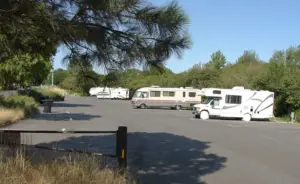
17 tips to keep RV cool without air conditioner in summer

How long do RV refrigerators last

How To Carry Bikes With a Pop Up Camper

Camping In A Pop up Camper – This Is What You Should KNOW!

IMAGES
VIDEO
COMMENTS
Getting Started with RV Solar Before we start, it's important to note that the specifics of your setup will depend on your rig and solar kit—what type of panels you have (flexible, rigid, etc.), your roof size and type (flat, curved, fiberglass, rubber, etc.), whether you have an RV or a trailer, where your battery bank is located, etc. Be sure to consult the instructions provided with any ...
Mount the RV solar panels to the roof using the parallel or series method. Attach the charge controller to the RV's interior near the battery bank. Run wires from the solar panels to the charge controller with a circuit breaker or fuse. Connect the charge controller to the battery bank. Then, connect the solar panels.
Solar system parts. The most basic RV solar system comes with three main parts: solar panels, a charge controller, and a battery bank. RV's that are solar-ready typically come with pre-installed wiring but not the components.. Pre-built RV solar panel kits are a good way for beginners to purchase a semi-complete system that comes with compatible parts. ...
Here are the steps to connecting your solar panels to your batteries: Mount your solar panels on the roof of your RV. Mount your charge controller inside the RV as close to your batteries as possible. Run your wiring from the solar panels into the RV and over to the charge controller. (You can run your wiring through a refrigerator vent or ...
The term Solar Array is an informal reference to a group of connected panels that make up a system — it is not a scientific term.. Photovoltaic Array. When exploring solar, you will encounter the term "Photovoltaic Array."Solar Array is a generic term that refers to the installation of solar panels.Photovoltaic Array is the scientific term used when describing power outputs and ...
You have two options to consider when choosing solar panels for your RV or camper. 1) Portable RV Solar Panel System. A portable RV solar panel system is the easiest to set up and use. These systems typically plug into a dedicated solar plug on your RV and include one or more 100-watt solar panels that can be attached to your roof with Velcro ...
Going with a polycrystalline RV solar panel setup can save you a few dollars on your solar setup. Rigid vs Flexible Solar Panels. One last kind of solar panel is the flexible solar panel also known as a "thin-film" panel. Your "classic" RV solar panels are hard and rigid. Just like the name says, flexible solar panels can be bent into ...
Stepping up to a multi-panel 200-watt, 30-amp kit could easily double the price. To get a 200-400-watt system professionally installed, plan on spending $3,000-$5,000, while a 600-watt or bigger solar system typically costs $7,000-$15,000. Price depends on the application, components, battery type and labor involved.
A typical solar power setup for an RV will consist of solar panels, a charge controller, a battery bank, and an inverter. These components work together to collect, store, and convert solar energy into usable electricity for your RV's appliances and electronics. Some SRRV's can harness a rooftop system or a portable system.
Energy: Solar panels require adequate sun to charge your batteries, while generators require adequate fossil fuels. Space: A generator and its fuel take up a significant amount of interior storage ...
Installation Instructions for RV Solar Panels. 1. Physically map out your RV solar system. Map out the location of everything in your system, including where your solar panels will go on your roof, and where your wiring will enter the roof to go into the RV and connect to your solar charge controller. This means making sure that no shadows will ...
3. The battery stores the charge as DC power which can be used to power your appliances even when the sun isn't hitting the solar panels. So, its not that when the sun isn't their at night you wont have solar energy for your use. The point here is its the batteries that will be powering your RV appliances.
Solar panels are the backbone of your RV solar system. Choosing the right panels for your needs will maximize your solar system's efficiency, performance, and return on investment. Solar panels consist of multiple individual solar cells that convert sunlight into energy. Several panels can be joined together to create a 'solar array' that ...
WindyNation 400 watt + 30 amp charge controller + 1500 watt inverter + AGM battery + cables. This is a big, complete, 12-volt RV solar power kit that includes everything you need to get up and running. WindyNation has a long track record in the off-grid energy world, and this kit comes with four 100-watt photovoltaic panels.
RV Solar 101: Everything you need to know about the typical RV solar charging set up. By far, the most common RV solar charging set up includes a couple hund...
RV Solar Calculator for Off Grid Living. Graham Bogie. November 23, 2023. This RV solar calculator will help you correctly size your entire camper solar system. It includes your inverter, solar panels, solar charge controller and battery bank too. It's simple and straightforward to use. We've included a section below to answer some ...
The DOKIO 110w 18v Portable Foldable Solar Panel Kit is great for RVers on a budget. Designed for battery charging, this complete kit can deliver enough amperage to your RV battery, marine battery, or off-grid setup. The kit comes with several different connectors to easily attach to any 12-volt battery.
The Best RV Solar Panels. Best Overall: Renogy 200W 12-Volt Solar RV Kit. Best Value: Eco-Worthy 100W Solar Panel. Best Mounted: Go Power! Overlander 190W Solar Kit for RVs. Best Lightweight ...
Step by Step Instructions for an RV Solar Connection: 1. Secure the solar panels to the roof of your RV. There are many ways to do this depending upon the type of panel you will use and the material of your RV roof. See this blog to learn various ways to attach different types of solar panels to your rig. 2.
RV Solar is not as difficult as it might first seem. When you can understand RV electrical in the roles they play it is easier to understand how it all works...
The Professor shows how to run a 15k BTU RV air conditioner and other major appliances for free on solar when dry camping / boondocking off the grid in a RV ...
Average watts requirements of RV. To run a 13,500 BTU air conditioner you will need at least 2000 watts for starting and 1500 watts for running. To produce that many watts you will need bigger inverter probably more than 2500 watts. Usually, the inverter that you get for RV range between 1000 to 2000 watts.
Roboteos has developed an RV rooftop solar charging system that automatically deploys and tracks the sun all day. Called the Heliotrope 1.0, it's designed to pull in every last photon, giving van ...
The RV-DE-FENDER is designed to mount inside the wheel well, protecting your RV in the case of a blowout. It deflects or maintains debris from the tire and prevents it from causing structural damage. It's an excellent protective mechanism that will give you some peace of mind on the highway. Wrapping Up Our RV Tire Inspection Checklist